Parts Of a Sail Explained (Illustrated Beginners Guide)
Are you curious about sail mechanics and how they engage the wind? In this illustrated guide, we'll explain the various sail components and how they work together to propel a sailboat. From the head to the foot, the tack to the clew, we'll break down each part and give you a solid foundation to build on as you learn to trim sails and navigate the open sea.
A sail, which is a large piece of fabric that is attached to a long pole called the mast, uses the wind to pull a sailboat across the water. It has various parts, such as the head, tack, clew, luff, leech, foot, mainsail, jib, and batten. These components determine the shape and efficiency of the sail.
Let's break down all these terms and descriptions to understand how each component interacts with each other. So, whether you're a seasoned sailor or a beginner, you'll have a better grasp of sail trim and optimal performance on the water.
- The primary parts of a mainsail include the head, tack, clew, luff, leech, and foot.
- Some critical elements of the jib include the sheet, genoa, and headstay.
- Asymmetrical spinnakers are designed for off-wind sailing and have a more rounded shape, while symmetrical spinnakers are used for downwind sailing and have a more traditional, triangular shape.
- The most common fabrics used for making sails are traditional fabrics like cotton and flax, and modern fabrics such as polyester and nylon, Dacron, Mylar, and laminates.
- Be sure to learn how to properly trim, reef, clean, flake, and store your sails for durability and optimal performance.
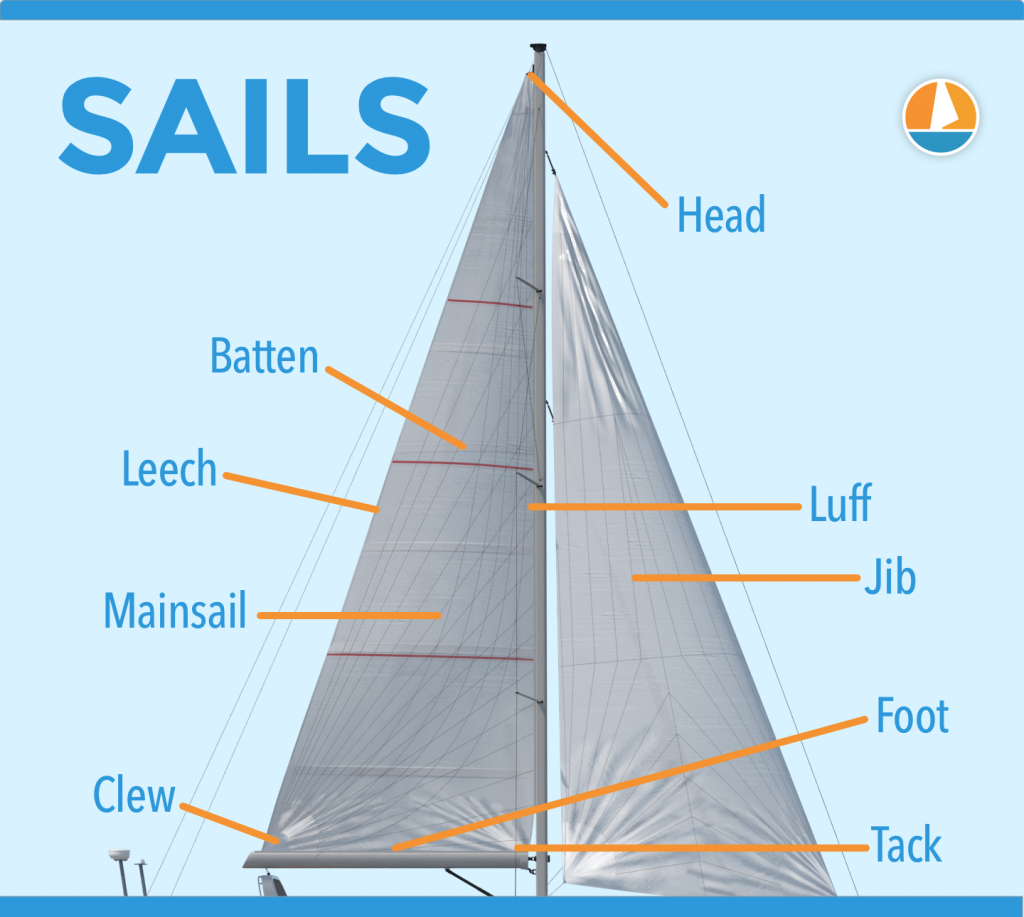

On this page:
Parts of a sail and their functions, mainsail components, jib components of a sailboat, components of spinnakers, sail controls and settings, sail care and maintenance, sail materials and construction.
In this guide, we'll focus on the three main types of sails : Mainsail, Jib, and Spinnaker.
Mainsail is the primary sail on your boat
The mainsail is the largest sail on a sailboat and is typically attached to the mast and boom. It is found aft (rear) of the mast. It's attached to the boat through a track or sail slide, which allows it to move up and down.
| Description | |
|---|---|
| the very top of the sail that is attached to the mast | |
| the bottom edge of the sail that is attached to the boom | |
| the front, leading edge of the sail that runs along the mast | |
| the trailing edge of the sail that runs from the head to the clew | |
| the bottom front corner of the sail | |
| the bottom aft corner of the sail that is attached to the boom | |
| are thin, flat strips of material (such as fiberglass or wood) that are inserted into pockets in the sail to help it maintain its shape and prevent it from flapping in the wind | |
| are sets of small lines or ties that are used to reduce the size of the sail in high winds | |
| are small pieces of ribbon or yarn that are attached to the sail to help the sailor determine the direction and strength of the wind | |
| are numbers that are affixed to the sail to identify the boat in racing situations | |
| include lines or sheets that are used to control the shape and position of the sail, such as the mainsheet, outhaul, and cunningham |
Jib is a triangular sail placed in front of the boat
The jib is a smaller sail that is attached to the bow of the boat and works in conjunction with the mainsail to control the direction and speed of the boat. It helps to improve the boat's handling and increase speed, working in tandem with the mainsail.
| Description | |
|---|---|
| the top of the sail that is attached to the forestay | |
| the leading edge of the sail that runs along the forestay | |
| the bottom edge of the sail that is attached to the deck or a furling drum | |
| the trailing edge of the sail that runs from the head to the clew | |
| the corner of the sail that is attached to the deck or a furling drum | |
| are small pieces of ribbon or yarn that are attached to the sail to help the sailor determine the direction and strength of the wind | |
| are lines that are used to control the position and trim of the sail | |
| a device that allows the jib to be rolled up and stored when not in use | |
| are clips that are used to attach the jib to the forestay on boats that do not have a furling drum | |
| the bottom forward corner of the jib that is attached to the boat's bow |
In some cases, larger jibs called genoas are used to capture more wind, thus increasing the boat's speed.
Spinnaker is designed for sailing downwind
The spinnaker is a large, colorful, and lightweight balloon-shaped sail designed for sailing downwind. It captures the wind from the rear, pushing the boat forward with added speed and stability.
| Description | |
|---|---|
| the top of the sail that is attached to a spinnaker halyard | |
| the leading edge of the sail that runs along the spinnaker pole | |
| the bottom edge of the sail that is attached to the spinnaker tack line | |
| the trailing edge of the sail that runs from the head to the clew | |
| the corner of the sail that is attached to the spinnaker sheet | |
| a long, horizontal pole that is attached to the mast and used to hold the spinnaker out from the boat | |
| a line that is attached to the spinnaker pole and used to control its position | |
| a line that is attached to the clew of the spinnaker and used to control its position and trim | |
| a line that is attached to the lower forward corner of the spinnaker and used to control its position | |
| a device that is used to control the spinnaker when it is being raised or lowered |
In this section, you'll find a comprehensive explanation of the primary components of a sail and their functions:
Head is the uppermost corner of a sail
The head of the sail refers to the uppermost corner where it connects to the top of the mast. Knowing the location of the head is essential, as it helps you identify the top of the sail and allows you to properly hoist and secure it in place.
Tack is the lower front corner of a sail
The tack is where the lower front corner connects to the base of the mast, or the boom. This important point helps you determine the sail's orientation and affects its overall shape and efficiency. By adjusting the tension at the tack, you can control your sail's performance and handling in various wind conditions.
Clew is the lower rear corner of a saisl
The clew is where the sheets attach to control the sail's angle to the wind. Adjusting the tension on the sheets can change the sail's shape and ultimately influence the boat's speed and direction. Becoming familiar with the clew will help improve your sailing skills and ensure smooth maneuvers on the water.
Luff is the front edge of the sail
The luff is the forward edge of the sail that runs along the mast. It's crucial to maintaining a tight and efficient sail shape. When sailing upwind, pay close attention to the luff, as it can provide valuable information about your sail's trim. A properly trimmed sail will have a smooth luff, allowing the boat to move efficiently against the wind.
Leech is the rear edge of the sail
The leech is opposite the luff. It plays a critical role in controlling the overall shape and efficiency of your sail. Watch the leech carefully while sailing, as excessive tension or looseness can negatively affect your sail's performance. Adjusting your sail's trim or using a device called a "boom vang" can help control the shape and tension of the leech.
Foot is the bottom edge of the sail
The foot is running between the tack and the clew. It helps control the shape and power of the sail by adjusting the tension along the boom. Ensure the foot is properly trimmed, as this can impact your boat's performance and speed. A well-adjusted foot helps your sail maintain its proper shape and operate at optimal efficiency while out on the water.
In this section, we'll look at some critical elements of the jib: the sheet, genoa, and headstay.
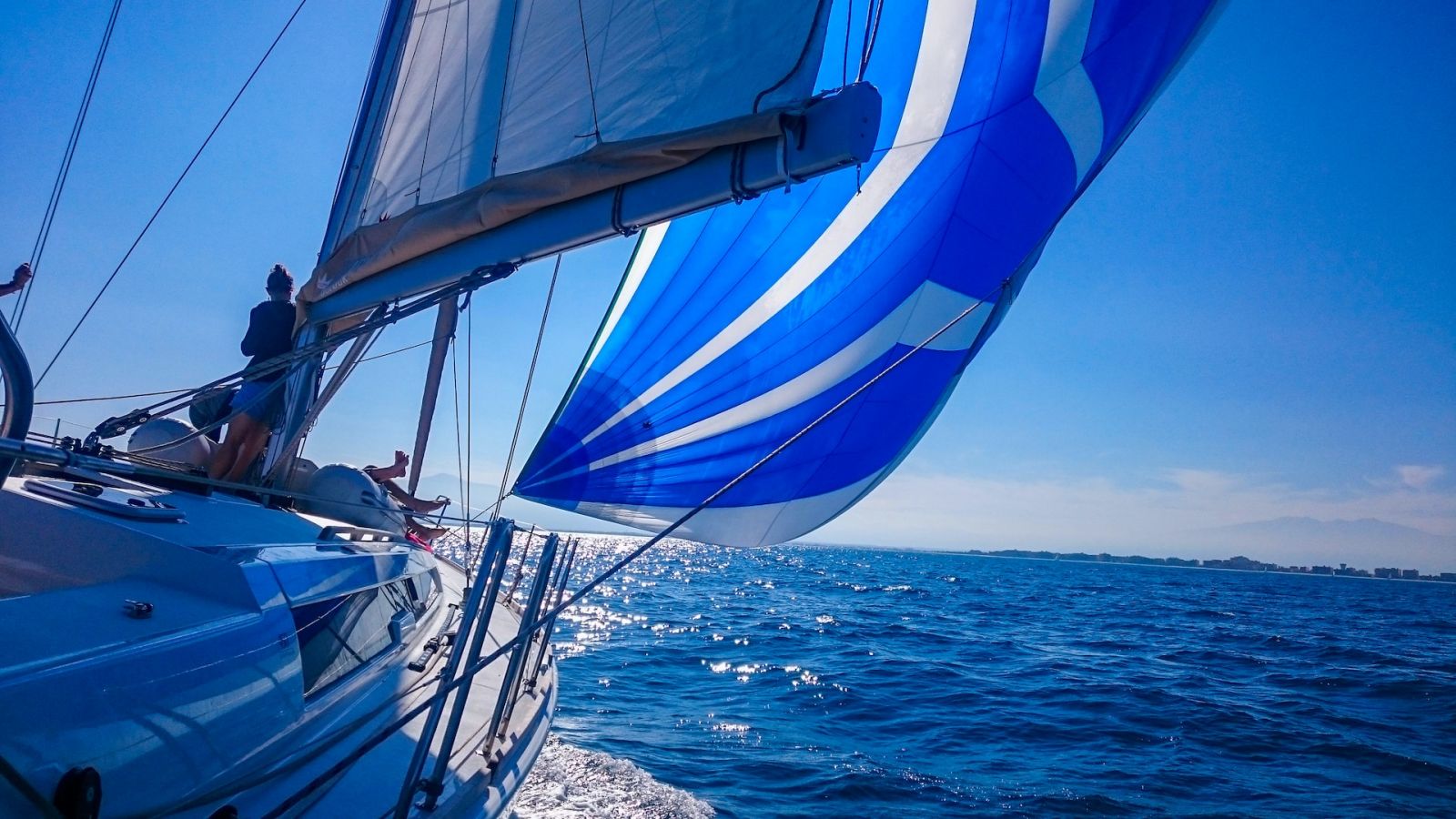
Sheet is the line used to control the position and trim of the sail
The jib sheet is the line used to control the jib's angle in relation to the wind. You adjust the sheet to get the best possible sail trim, which greatly affects your boat's performance. The jib sheet typically runs from the jib's clew (the lower rear corner of the sail) through a block on the boat's deck, and back to the cockpit, where you can easily control it.
When adjusting the jib sheet, you want to find the perfect balance between letting the sail out too far, causing it to luff (flutter), and pulling it in too tightly, which can cause heeling or poor sail shape. Make small adjustments and observe how your boat responds to find the sweet spot.
Genoa is a larger jib used to capture more wind
A genoa is a larger version of a standard jib. It overlaps the mainsail, extending further aft, and provides a greater sail area for improved upwind performance. Genoas are categorized by the percentage of overlap with the mainsail. For example, a 130% genoa means that the sail's area is 30% larger than the area of a jib that would end at the mast.
Genoas are useful in light wind conditions, as their larger surface area helps your boat move faster. However, they can become difficult to manage in strong winds. You might need to reef (reduce the size) or swap to a smaller jib to maintain control.
Headstay provides a support structure for the jib
The headstay is a crucial part of your boat's standing rigging system. It is the cable or rod that connects the top of the mast (the masthead) to the bow of the boat. The headstay helps maintain the mast's stability and provides a support structure for the jib.
The tension in your headstay plays a significant role in the jib's sail shape. Proper headstay tension will create a smooth, even curve, allowing your jib to perform optimally. If the headstay is too tight, the sail may be too flat, reducing its power, whereas a loose headstay can result in a sagging, inefficient sail shape.
A spinnaker is a sail designed specifically for sailing off the wind , on courses between a reach and downwind. They are made of lightweight fabric, often brightly colored, and help maximize your sailing speed and performance.
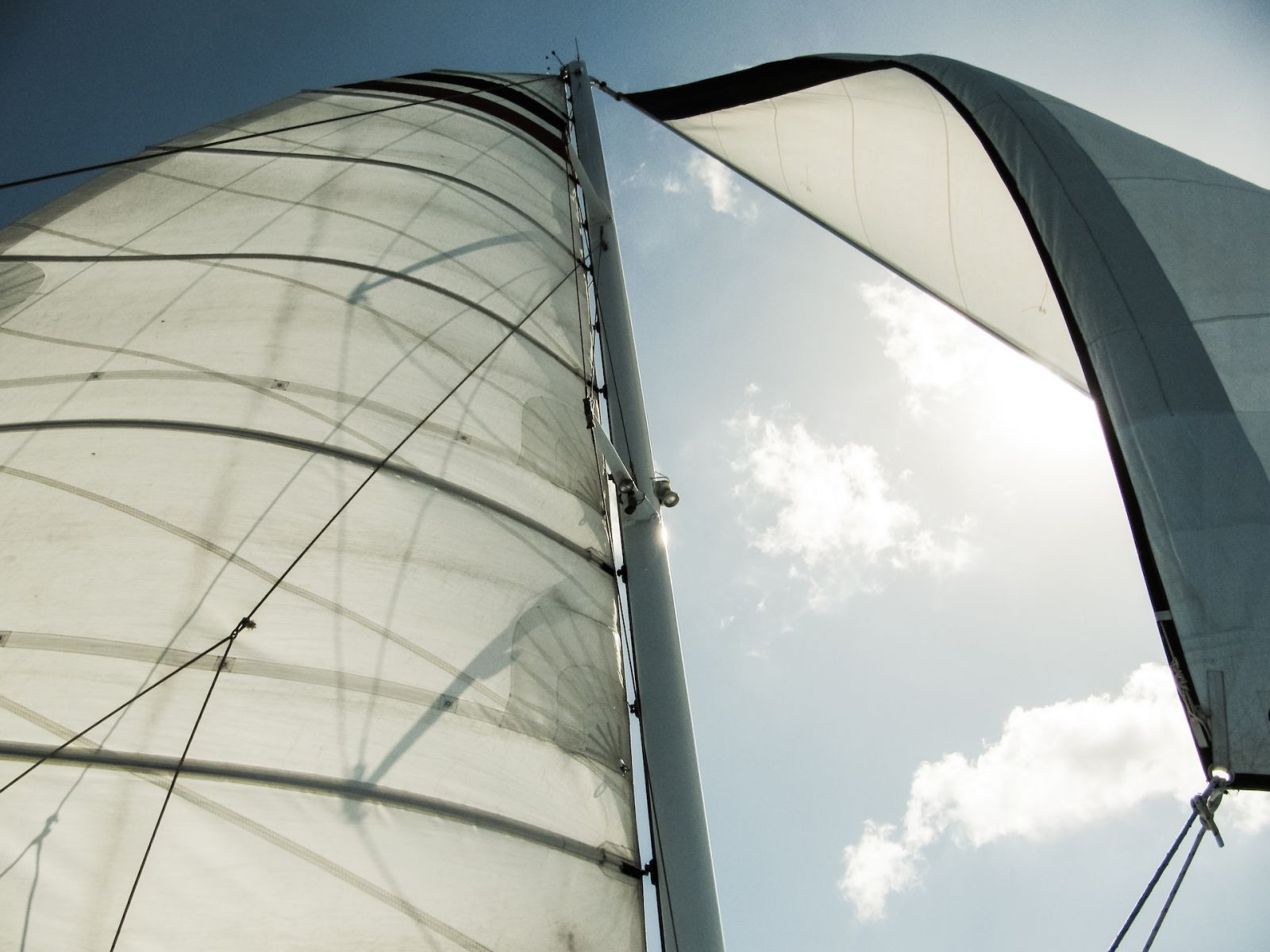
Asymmetrical spinnakers are designed for off-wind sailing
Asymmetrical spinnakers are usually found on modern cruising and racing boats. They're designed for a broader range of wind angles and have a more forgiving shape, making them easier for you to handle. Key components of an asymmetrical spinnaker include:
- Tack : This is the front, lower corner where the sail connects to the boat. A tack line is used to adjust the sail's position relative to the bow.
- Head : The top corner of the sail, where it connects to the halyard to be hoisted up the mast.
- Clew : The aft corner of the sail, connected to the sheet, allowing you to control the angle of the sail to catch the wind effectively.
You can find a step-by-step guide on how to rig and hoist an asymmetrical spinnaker here .
Symmetrical spinnakers are used for downwind sailing
Symmetrical spinnakers are more traditional and usually found on racing boats, where downwind performance is critical. These sails are shaped like a large parachute and are split into two identical halves. Key components of a symmetrical spinnaker include:
- Head : Similar to the asymmetrical spinnaker, the head is the top corner connected to the halyard.
- Clews : Unlike an asymmetrical spinnaker, a symmetrical spinnaker has two clews. Both are connected to sheets and guys, which help control the sail's shape and movement.
- Spinnaker Pole : This is a horizontal pole that extends from the mast and is used to project the windward clew outwards and hold the sail open.
Handling a symmetrical spinnaker can be more challenging, as it requires precise teamwork and coordination. If you're new to sailing with this type of sail, don't hesitate to seek guidance from experienced sailors to improve your technique.
In this section, we'll explore sail controls and settings, which are essential for beginners to understand for efficient sailing. We'll discuss trimming, and reefing, as sub-sections.
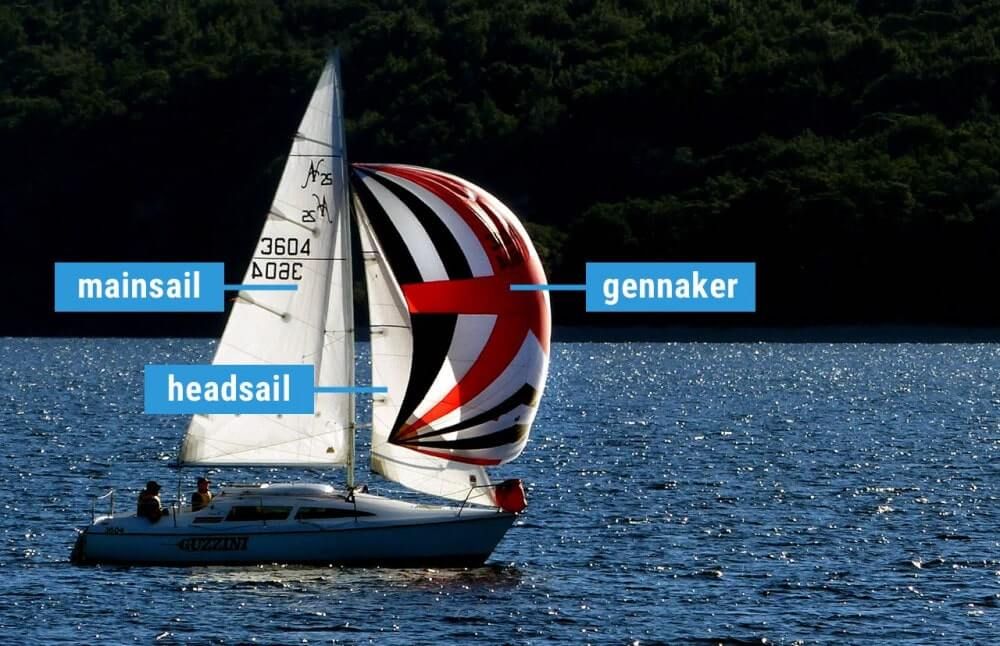
Trimming your sails for speed and stability
Trimming is the process of adjusting your sails to optimize them for the current wind conditions and desired direction. Proper sail trim is crucial for maximizing your boat's speed and stability. Here are some basic tips for sail trimming:
- Pay attention to the telltales, which are small ribbons or yarn attached to the sails. They help you understand the airflow over your sails and indicate whether they're properly trimmed.
- Use the sheets, which are lines attached to the clew of your sails, to adjust the angle of your sails relative to the wind.
- In light winds, ease the sails slightly to create a more rounded shape for better lift. In stronger winds, flatten the sails to reduce drag and prevent excessive heeling.
Reefing your sails for control and balance
Reefing is the process of reducing the sail area to help maintain control and balance in stronger wind conditions. It's an essential skill to learn for your safety and the longevity of your sails. Follow these steps to reef your sails:
- Head into the wind to reduce pressure on the sails.
- Lower the halyard (the line that raises the sail) until the sail reaches the desired reefing point.
- Attach the sail's reefing cringle (reinforced eyelet) to the reefing hook or tack line.
- Tighten the new, lower clew (bottom corner) of the sail to the boom with the reef line.
- Raise the halyard back up to tension the reduced sail.
Take proper care of your sailboat to ensure that it remains in top condition. In this section, we will discuss the key aspects of sail care and maintenance, focusing on cleaning and storage.
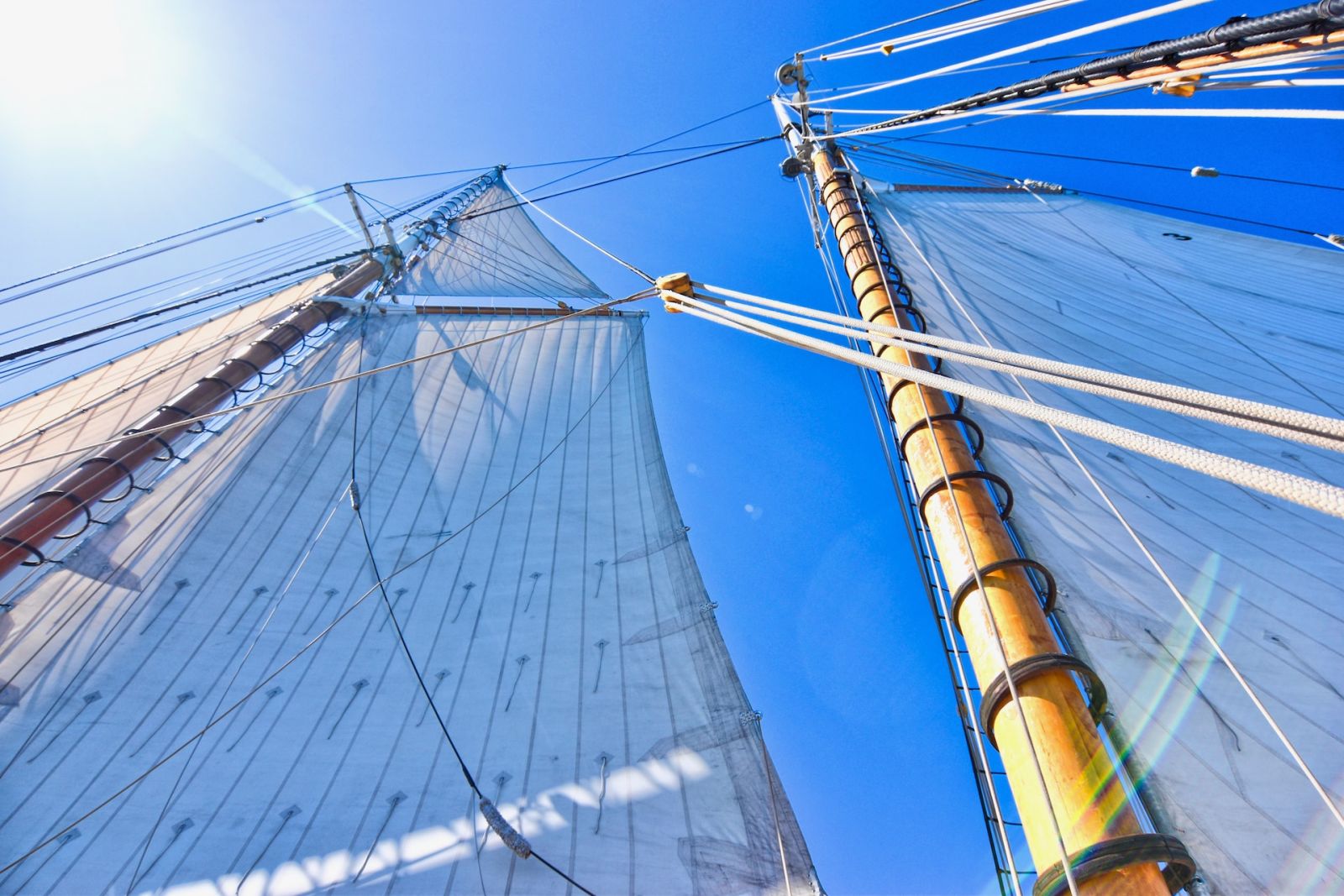
Steps to clean your sails
Keeping your sail clean is crucial for its longevity and performance. Follow these simple steps to maintain a spotless sail:
- Rinse with fresh water after each use, paying extra attention to areas affected by saltwater, debris, and bird droppings.
- Use a soft-bristled brush and a mild detergent to gently scrub away dirt and stains. Avoid harsh chemicals or abrasive materials, as they may damage the fabric.
- Rinse again thoroughly, ensuring all soap is washed away.
- Spread your sail out to air-dry, avoiding direct sunlight, which may harm the fabric's UV protection.
Ways to store your sails
Sail storage is equally important for preserving the lifespan of your sail. Here are some tips for proper sail storage:
- Fold or roll your sail : Avoid stuffing or crumpling your sail; instead, gently fold or roll it to minimize creases and wear on the fabric.
- Protect from UV rays : UV exposure can significantly reduce the life of your sail. Store it in a cool, shaded area or use a UV-resistant sail cover when not in use.
- Ventilation : Ensure your sail is stored in a well-ventilated area to prevent mildew and stale odors.
- Lay flat or hang : If space allows, store your sail laid out flat or hanging vertically to reduce the risk of creasing and fabric damage.
Flaking your sails when not in use
Flaking is the process of neatly folding your sails when they're not in use, either on the boom or deck. This helps protect your sails from damage and prolongs their lifespan. Here's how to flake your sails:
- Lower the sail slowly, using the halyard while keeping some tension on it.
- As the sail comes down, gather and fold the sail material in an accordion-like pattern on top of the boom or deck.
- Secure the flaked sail with sail ties or a sail cover to prevent it from coming undone.
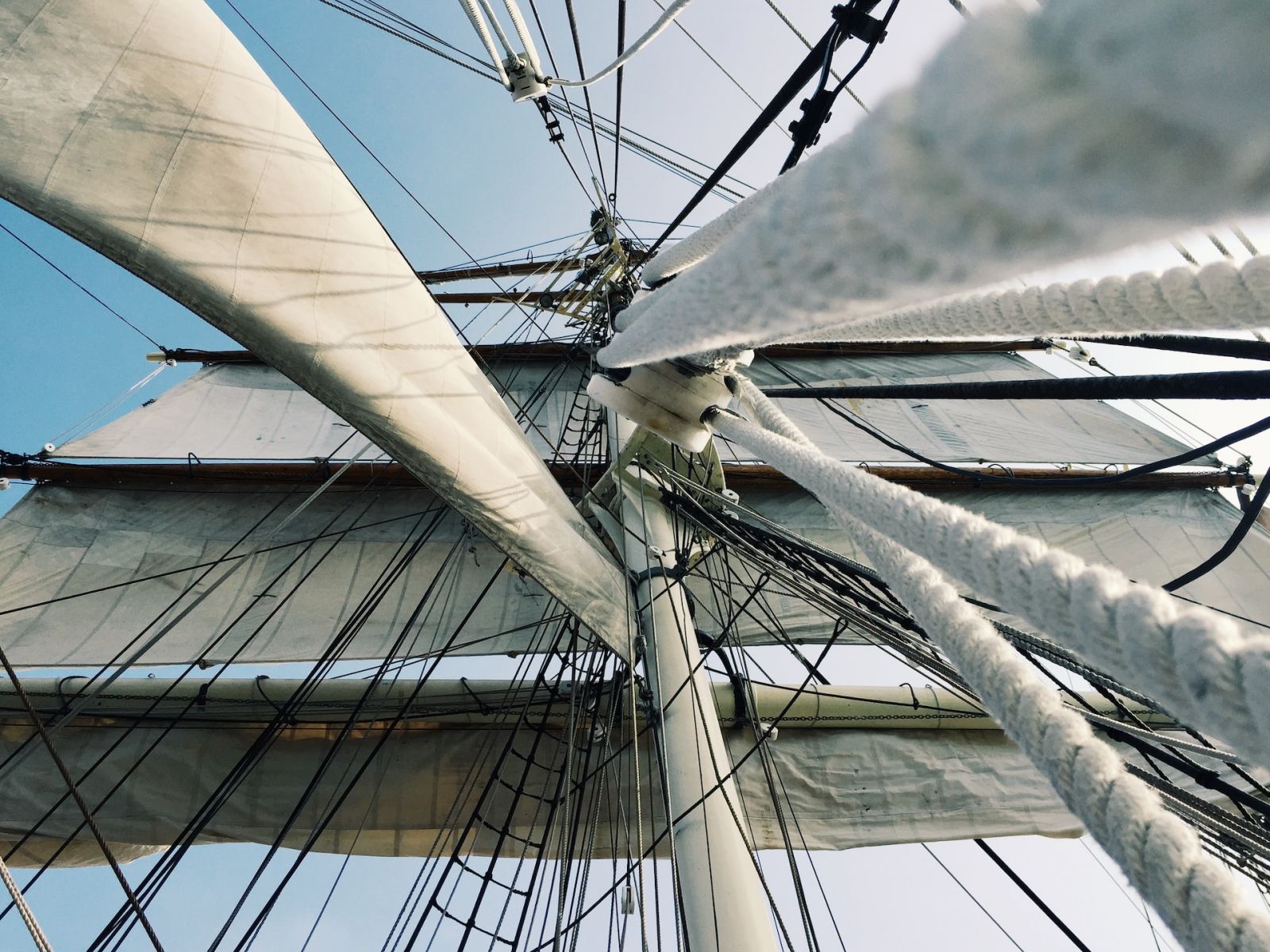
Traditional fabrics used to make sails
In the early days of sailing, natural materials like cotton and flax were used to make sails. These fabrics were durable, breathable, and held up well in various weather conditions. However, they would eventually wear out and lose their shape due to the constant exposure to UV rays and seawater.
While traditional fabrics like cotton and flax were once commonly used for sailmaking, they have largely been replaced by synthetic materials like polyester and nylon due to their superior strength, durability, and resistance to mildew and rot. However, some sailors and sailmakers still use cotton and other natural fibers for certain applications, such as traditional sailmaking or historical recreations.
Modern fabrics used to make sails
Modern sail materials, such as Dacron, Mylar, and laminates, are more resilient and longer-lasting than traditional fabrics. These materials are lightweight, strong, and resistant to UV rays and water damage.
Dacron : Dacron is a popular material for sails because of its durability, UV resistance, and ease of maintenance. It's a type of polyester fabric that is often used for making cruising sails. Dacron offers excellent shape retention and resistance to stretch, making it ideal for both beginners and experienced sailors.
Laminate materials : Laminate sails are made by bonding multiple layers of materials like Mylar, polyester, and Kevlar. These sails offer better shape and performance compared to their fabric counterparts, making them popular among racers. However, they tend to be more delicate and may not be suitable for long-term cruising.
Mylar films : Mylar films are used in laminate sails for their excellent strength-to-weight ratio and shape retention. These films are often sandwiched between other materials, such as polyester or Kevlar, to enhance the sail's resistance to stretch and load handling. However, Mylar sails can be susceptible to delamination and abrasion, requiring extra care and regular inspection.
Sail stitching for shape and durability
Sail stitching is an essential aspect of sail construction, helping to maintain the sail's shape and durability. Various stitching techniques can be used, such as zigzag, straight, and triple-step sewing. The choice of stitching type depends on the sail's purpose and expected loads. In addition, using UV-resistant thread ensures that the stitching lasts longer under harsh sun exposure.
Leave a comment
You may also like, how do sails actually work: full beginners guide.
The sails are your boat's primary driving force. Your boat is designed to sail , and with good wind it will be faster and more comfortable than using the engine. …
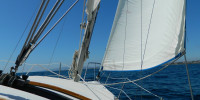
Sail Names: Explained for Beginners (With 15 Examples)
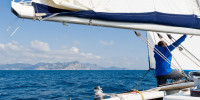
How To Trim Sails: The Ultimate Guide (with Cheat Sheet)

How To Reef Your Sails (Mainsail, Jib, Furling, Loose)
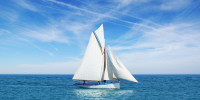
How Much Do New Sails Cost?
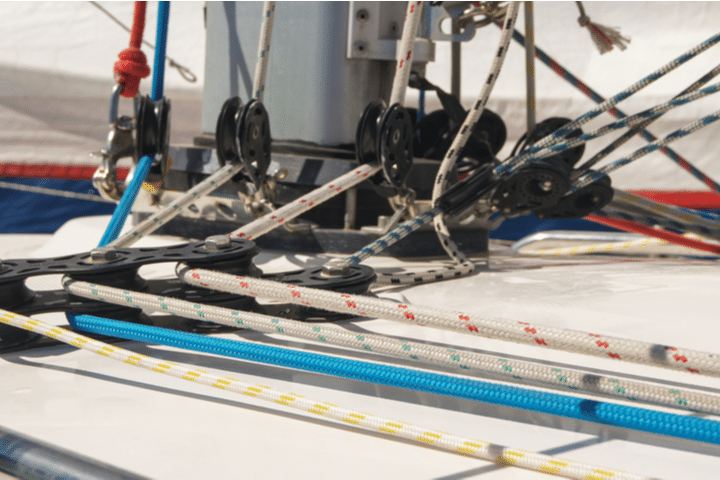
A Guide to the Different Parts of a Sailboat

Table of Contents
Last Updated on November 29, 2023 by Boatsetter Team
When you use Boatsetter, you have the opportunity to choose from a myriad of different sailboat rentals from all over the United States and beyond . A sailboat is a perfect way to relax on the water, either on a solo adventure or on an excursion with friends and family.
When you rent a sailboat with Boatsetter, you will have the option to book a captained sailboat to enjoy your day out on the water or book bareboat to hone your sailing skills. Either way, you may be interested in the intricacies of a sailboat and its different parts. If this sounds like you, you have come to the right place. In this article, we go in-depth about the different parts of a sailboat so that you can be more knowledgeable about whatever boat you may choose and come away from reading this feeling more confident about the whole sailing experience.
A basic sailboat is composed of at least 12 parts: the hull , the keel , the rudder , the mast, the mainsail, the boom, the kicking strap (boom vang), the topping lift, the jib, the spinnaker, the genoa, the backstay, and the forestay. Read all the way through for the definition of each sailboat part and to know how they work.
Explore sailboats for rent near you or wherever you want to go
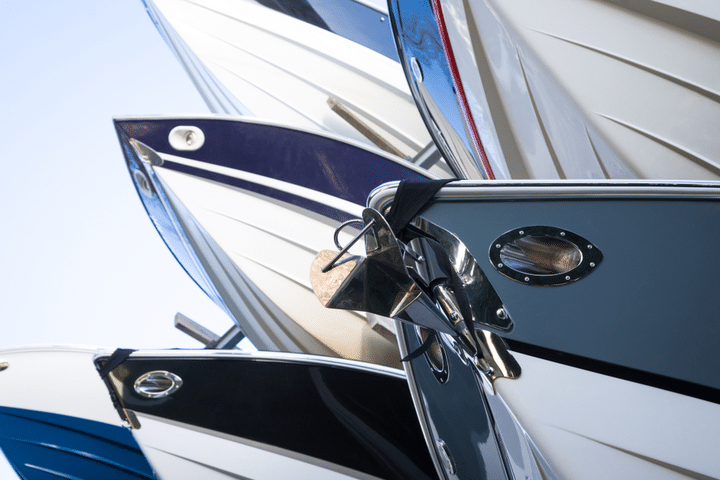
In short, the hull is the watertight body of the ship or boat. There are different types of hulls that a sailboat may have, and these different hulls will often affect the speed and stability of the boat.
Displacement Hulls
Most sailboats have displacement hulls , like round bottom hulls, which move through the water by pushing water aside and are designed to cut through the water with very little propulsion. The reason these are called displacement hulls is that if you lower the boat into the water, some of the water moves out of the way to adjust for the boat, and if you could weigh the displayed water, you would find that it equals the weight of the boat, and that weight is the boat’s displacement. One thing to know about displacement hulls is that boats with these hulls are usually limited to slower speeds.
Planing Hull
Another type of hull is a planing hull. These hulls are designed to rise and glide on top of the water when enough power is supplied. When there is not enough power behind the boat, these boats often act as displacement hulls, such as when a boat is at rest. However, they climb to the surface of the water as they begin to move faster. Unlike the round bottom displacement hulls, these planing hulls will often have flat or v-shaped bottoms. These are very common with motor-driven water vessels, such as pontoon boats, but they can also be found on smaller sailboats which allow them to glide quickly over the water.
Finally, sailboats can differ depending on the number of hulls that they have. There are three options: monohulls (one hull), catamarans (two hulls), and trimarans (three hulls).
Monohulls , which have only a single hull, will usually be the typical round bottom displacement hull or occasionally the flat bottomed or v-shaped planning hull. Catamarans have two hulls with a deck or a trampoline in between, with the extra hulls providing increased stability. Finally, trimarans have three hulls — a main hull in the middle and two side hulls used for stability. These trimarans have gained popularity because of their excellent stability and ability to go at high speeds.
When evaluating a sailboat , it is important to pay attention to the type of hull that the boat has because the type of hull a sailboat has can drastically change the sailing experience, especially when it comes to stability and speed.
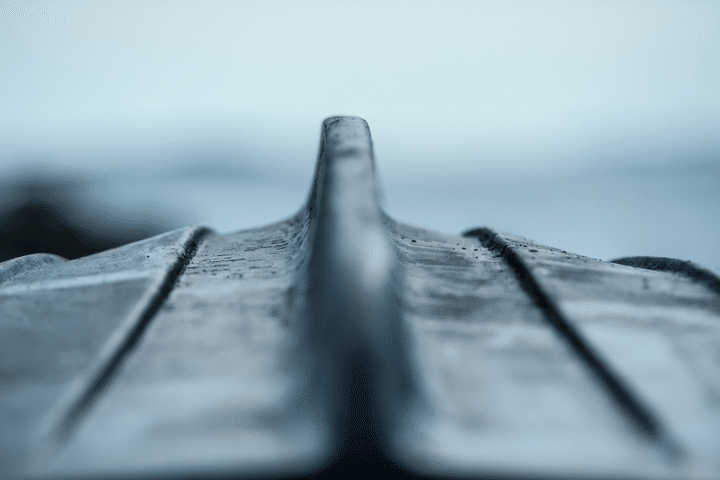
All sailboats have a keel, a flat blade sticking down into the water from the sailboat’s hull bottom. It has several functions: it provides counterbalance, life, controls sideways movement, holds the boat’s ballast , and helps prevent the boat from capsizing. When a boat leans from one side to the other, the keel and its ballast counteract the movement and prevent the boat from completely tipping over.
As with hulls, there are a number of different types of keels, though the two most common types of keels on recreational sailboats are the full keel or the fin keel. A full keel is larger than a fin keel and is much more stable. The full keel is generally half or more of the length of the sailboat. However, it is much slower than the fin keel. A fin keel, which is smaller than the full keel, offers less water resistance and therefore affords higher speeds.
A more recent feature on sailboats is the “winged keel,” which is short and shallow but carries a lot of weight in two “wings” that run sideways from the keel’s main part. Another more recent invention in sailing is the concept of the canting keels, which are designed to move the weight at the bottom of the sailboat to the upwind side. This invention allows the boat to carry more sails.
The Rudder
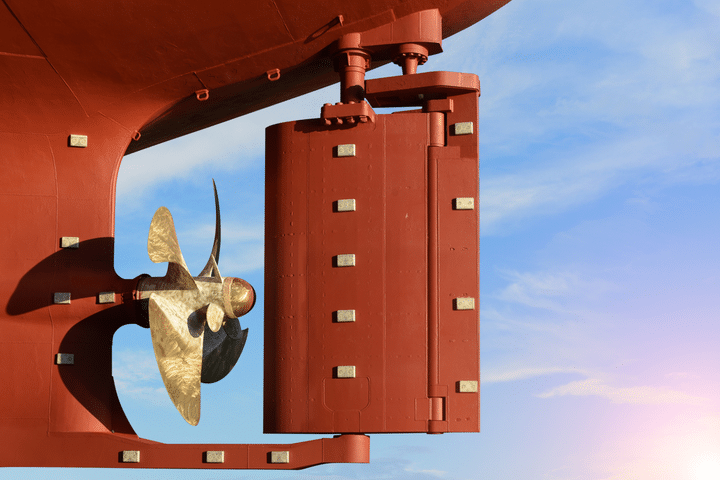
A rudder is the primary control surface used to steer a sailboat. A rudder is a vertical blade that is either attached to the flat surface of the boat’s stern (the back of the boat) or under the boat. The rudder works by deflecting water flow. When the person steering the boat turns the rudder, the water strikes it with increased force on one side and decreased force on the other, turning the boat in the direction of lower pressure.
On most smaller sailboats, the helmsman — the person steering the boat — uses a “ tiller ” to turn the rudder. The “tiller” is a stick made of wood or some type of metal attached to the top of the rudder. However, larger boats will generally use a wheel to steer the rudder since it provides greater leverage for turning the rudder, necessary for larger boats’ weight and water resistance.
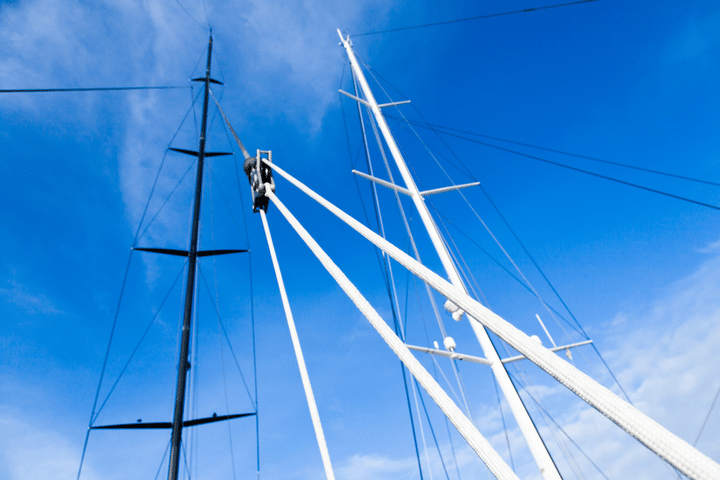
The mast of a sailboat is a tall vertical pole that supports the sails. Larger ships often have multiple masts. The different types of masts are as follows:
(1) The Foremast — This is the first mast near the bow (front) of the boat, and it is the mast that is before the mainmast.
(2) The Mainmast — This is the tallest mast, usually located near the ship’s center.
(3) The Mizzen mast — This is the third mast closest to the stern (back), immediately in the back of the mainmast. It is always shorter than the mainmast and is typically shorter than the foremast.
The Main Sail
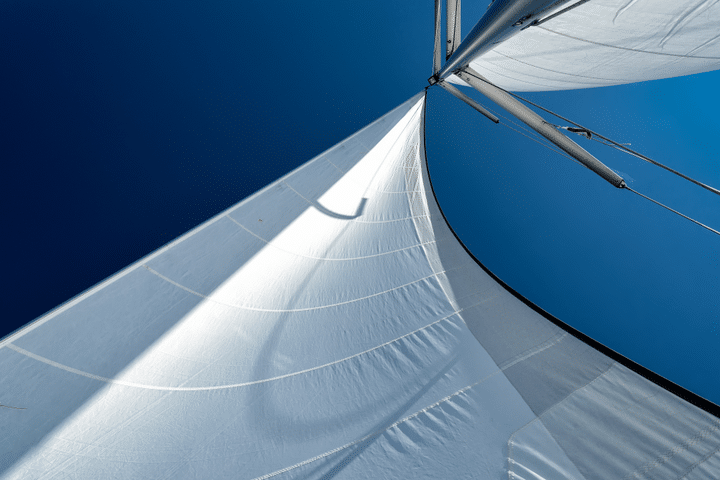
The mainsail is the principal sail on a sailboat, and it is set on the backside of the mainmast. It is the main source that propels the boat windward.
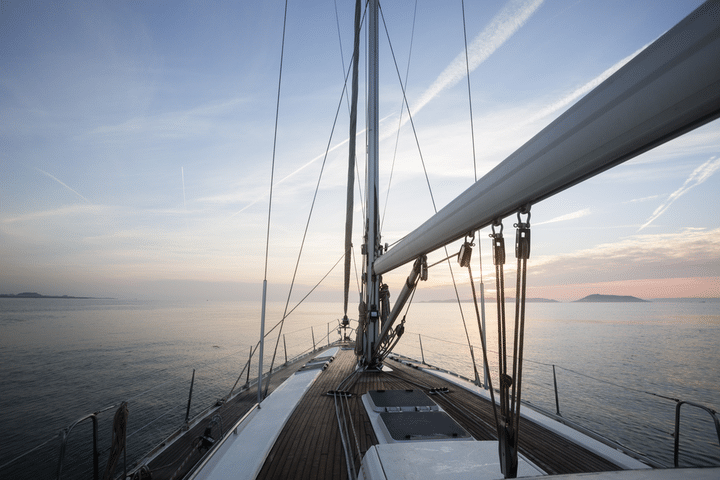
A boom is a spar (a pole made of wood or some other type of lightweight metal) along the bottom of a fore-and-aft rigged sail, which greatly improves the control of the angle and the shape of the sail, making it an indispensable tool for the navigation of the boat by controlling the sailes. The boom’s primary action is to keep the foot (bottom) of the sail flatter when the sail angle is away from the centerline of the sailboat.
The Kicking Strap (Boom Vang)
The boom vang is the line or piston system on a sailboat used to exert a downward force on the boom, enabling one to control the sail’s shape. The vang typically runs from the base of the mast to a point about a third of the way out the boom. It holds the boom down, enabling it to flatten the mainsail.
The Topping Lift
The topping lift is a line that is a part of the rigging on a sailboat, which applies an upward force on a spar (a pole) or a boom. Topping lifts are also used to hold a boom up when it’s sail is lowered. This line runs from the free end of the boom forward to the top of the mast. The line may run over a block at the top of the mast and down the deck to allow it to be adjusted.
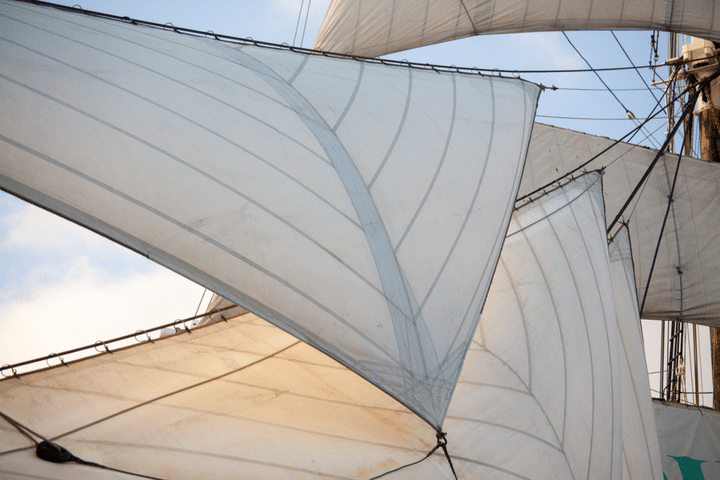
A jib is a triangular staysail set ahead of the foremost mast of a sailboat. Its tack is fixed to the bowsprit, the bow, or the deck between the bowsprit and the foremost mast. Jibs and spinnakers are the two main types of headsails on modern boats.
The Spinnaker
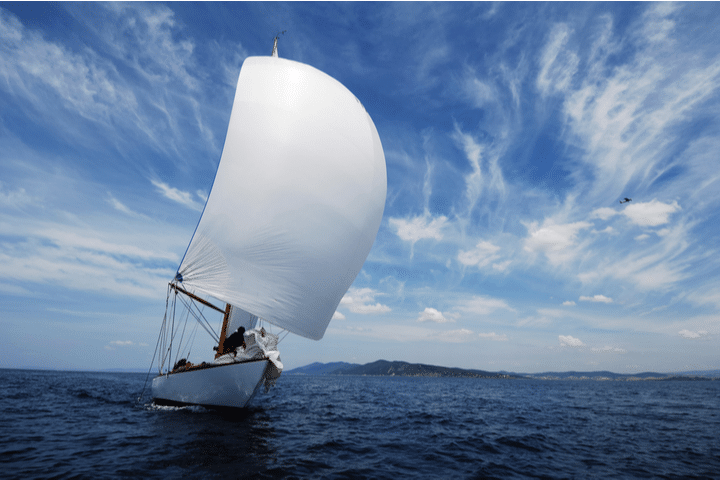
A spinnaker is a type of sail designed specifically for sailing off the wind from a reaching downwind course. The spinnaker fills up with wind and balloons out in front of the sailboat when it is deployed. This maneuver is called “flying.” The spinnaker is constructed of very lightweight material, such a nylon fabric and on many sailing vessels, it is very brightly colored.
Another name for the spinnaker is the “chute” because it often resembles a parachute, both in the material it is constructed from and its appearance when it is full of wind.
People often use the term genoa and jib as if they were the same thing, but there is a marked difference between these two types of sails. A job is no larger than a foretriangle, the triangular area formed by the mast, the deck or bowsprit, and the forestay. On the other hand, a genoa is larger than the jib, with part of the sail going past the mast and overlapping the mainsail. These two sails, however, serve very similar purposes.
The Backstay
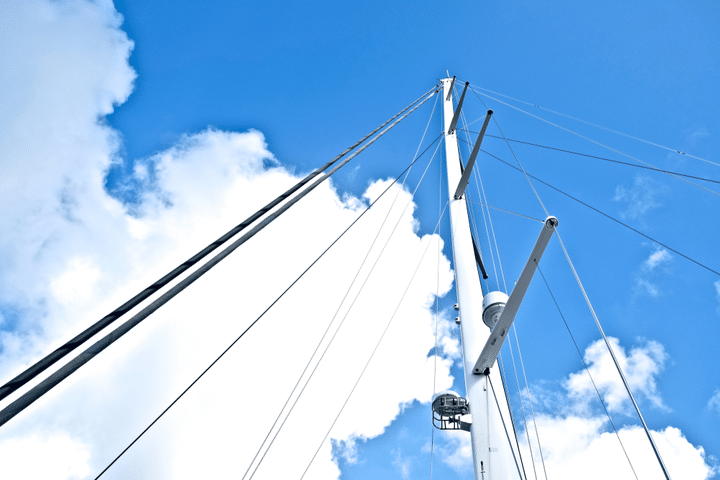
The backstay is a standing rigging that runs from the mast to the transom (the vertical section at the back of the boat), counteracting the forestay and the jib. The backstay is an important sail trip, control and directly affects the mainsail’s shape and the headsail.
There are two general categories of backstays:
1) A permanent backstay is attached to the top of the mast and may or may not be readily adjustable.
2) A running backstay is attached about two-thirds up the mast and sometimes at multiple locations along the mast. Most modern sailboats will have a permanent backstay, and some will have permanent backstays combined with a running backstay.
The Forestay
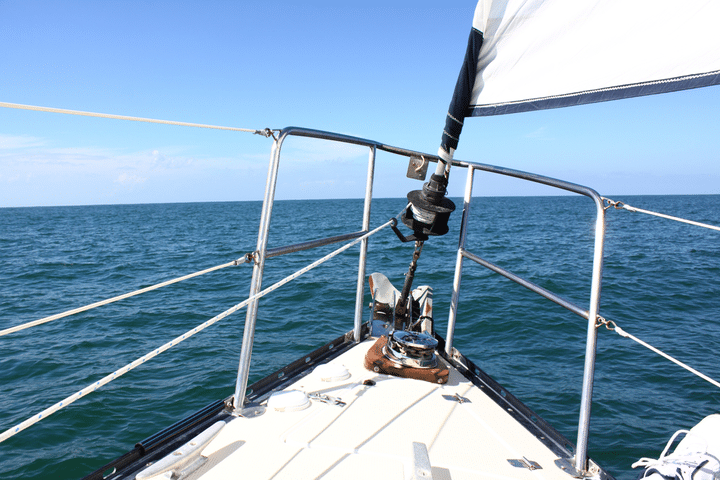
A forestay is a piece of standing rigging that keeps the mast from falling backward. It is attached at the very top of the mast, or at certain points near the top of the mast, with the other end of the forestay being attached to the bow (the front of the boat). Often a sail, such as a jib or a genoa, is attached to the forestay.
A forestay might be made from stainless steel wire, stainless steel rod or carbon rod, or galvanized wire or natural fibers.
Parts of a sail
Sails are vital for sailboats, made up of complex parts that improve performance and maneuverability. In this section, we’ll take a closer look at the different parts of that make up the sails.
Luff – The luff is a vertical sail part that maintains its shape and generates lift by interacting with the wind. It attaches securely with a bolt rope or luff tape for easy hoisting.
Leech – The leech controls air flow and reduces turbulence. Battens or leech lines are used to maintain shape and prevent fluttering.
Foot – The foot of a sail connects the luff and leech at the bottom edge. It helps define the sail’s shape and area. The outhaul is used to adjust its tension and shape.
Head – The sail’s head is where the luff and leech meet. It has a reinforced section for attaching the halyard to raise the sail.
Battens -The b attens are placed horizontally in sail pockets to maintain shape and optimize performance in varying wind conditions. They provide structural support from luff to leech.
Telltales – Sailors use telltales to adjust sail trim and ensure optimal performance.
Clew – The clew is important for shaping the sail and connecting the sheet, which regulates the angle and tension, producing energy. It’s located at the lower back corner of the sail.
Sailing is a favorite pastime for millions of Americans across the country. For some, there is nothing better than gliding across the water propelled by nothing more than the natural force of the wind alone. For both experienced and non-experienced sailors alike, Boatsetter is the perfect place to get your ideal sailboat rental from the mouthwatering Florida keys to the crystal blue waters of the Caribbean .
Smaller sailing boats are perfect for a single day out on the water, either by yourself or with friends and family. In comparison, larger sailing boats and sailing yachts can allow you days of luxury on longer excursions full of adventure and luxury.
Whatever your sailing dreams are, it is always good to know, for both the experienced sailor and the novice, all about the sailboat’s different parts. In this article, we learned all about the boat’s hull, the keel, the rudder, the mast, the mainsail, the boom, the kicking strap (boom vang), the topping lift, the jib, the spinnaker, the genoa, the backstay, and the forestay, which make up the basic parts of any sailboat you might find yourself on.
About us
Boatsetter is the go-to app for boat rentals and on-water experiences. Whatever the adventure, we’ve got a boat for that—Set sail , start the party , go yachting , make your trophy catch , and hone your watersports skills! Download the Boatsetter app ( App Store | Google Play ). Make sure to follow @boatsetter on Instagram, and tag us in all your boat day pictures for the chance to be featured.
Rent. List. Share—Only at Boatsetter

Boatsetter empowers people to explore with confidence by showing them a world of possibility on the water. Rent a boat, list your boat, or become a Boatsetter captain today.
Browse by experience

Explore articles

FAQ: Boatsetter Owner App Booking Inspection Forms
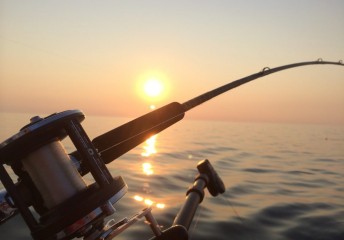
Trolling with Live or Dead Bait: 5 Tricks from Fishermen
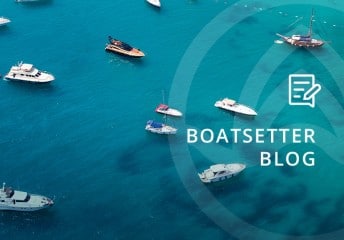
6 Ways Boating Benefits our Health
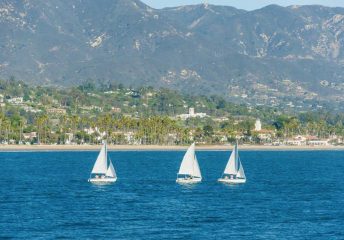
Santa Barbara Sailing and Boating Guide
Get your card today

- Pre-paid code

- Buy a Gift Card
Parts of a Sailboat & Sailing Terminology
A sailboat consists of several key components that work together to harness wind power and navigate through water. Anyone learning to sail or interested in the mechanics of sailboats should know what these parts are called and what they do.
Main parts of a sailboat
While not all sailboats have exactly the same structure, there are a few features that are found on almost every sailboat:
- Boom : A horizontal pole that is attached to the mast. It holds the bottom of the mainsail.
- Cleats : Fittings used to secure lines.
- Cockpit : The recessed area where the crew sits and controls the boat.
- Forestay and Backstay : Steel cables (stays) that support the mast from the front and back.
- Halyard : A line used to raise sails.
- Jib / Headsail : A smaller sail located in front of the mast.
- Keel : A large beam that runs along the bottom of the hull from bow to stern, which prevents the boat from sliding sideways through the water.
- Mainsail : The large, primary sail attached to the mast and boom.
- Mast : A vertical pole that supports the sails.
- Rudder : Used to steer the sailboat, controlled by a tiller or steering wheel.
- Sheets and Halyards : Lines (ropes) used to control and adjust the sails.
- Tiller or Wheel : Used to control the rudder for steering.
- Outhauls : Control the shape of the sail’s foot
- Vangs : Control the vertical angle of the boom
- Winches : Used to adjust sail tension and control lines.
- Shrouds : Cables that support the mast laterally.
- Rig : The arrangement of masts, sails, and supporting rigging that propels the vessel. This refers to standing rigging (the fixed rigging that supports the mast) and running rigging (the adjustable rigging used to control the sails).
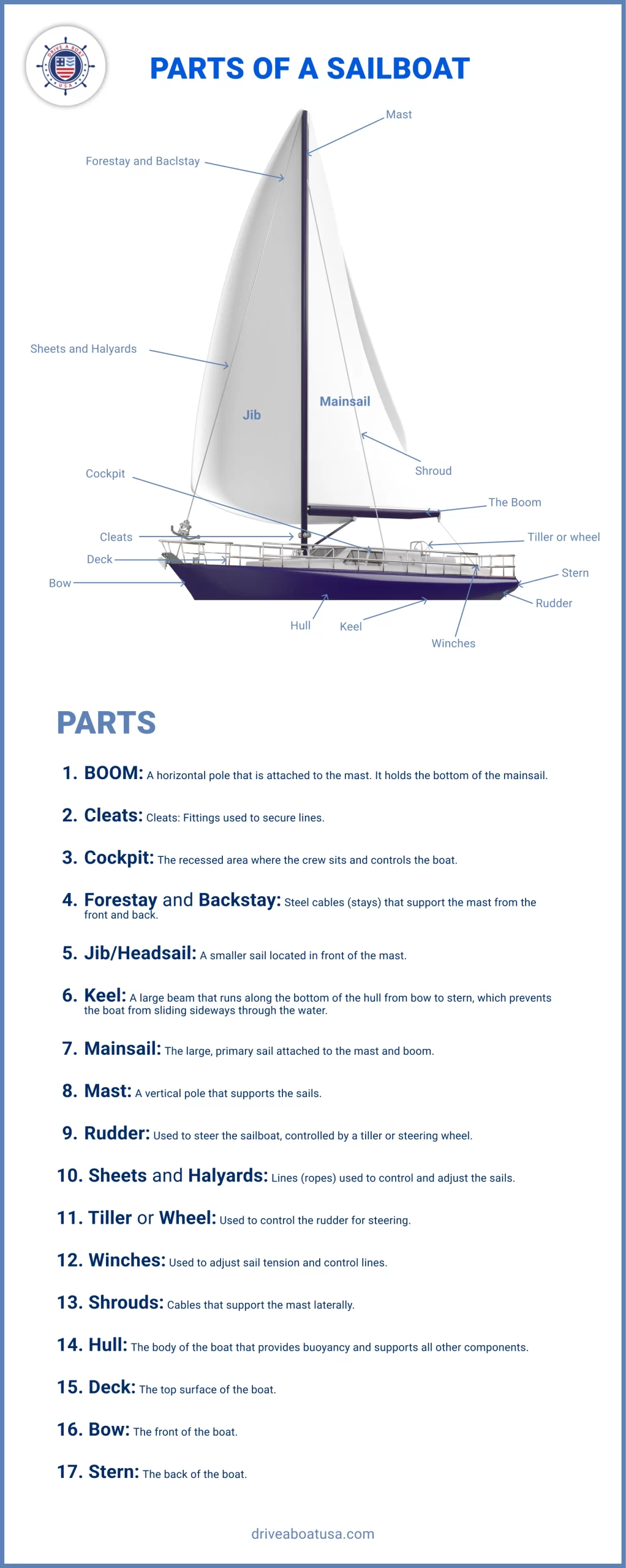
Types of rig
The choice of rig depends on factors such as the size of the boat, intended use, and sailing conditions. Each rig configuration has its own advantages in terms of performance, ease of handling, and versatility.
- Sloop: Single mast with a mainsail and one headsail, the most common modern rig
- Cutter: Similar to a sloop but with two headsails
- Ketch: Two masts, with the shorter mast (mizzen) forward of the rudder post
- Yawl: Two masts, with the shorter mast aft of the rudder post
- Schooner: Two or more masts, with the shorter mast forward
- Catboat: Single mast stepped far forward with one sail
All parts of a sailboat work together to allow the sailboat to harness wind power, maintain stability, and navigate through water efficiently.
Parts common to all boats
Sailboats also share several parts that are common to all boats :
- Hull : The body of the boat that provides buoyancy and supports all other components.
- Deck : The top surface of the boat.
- Bow : The front of the boat.
- Stern : The back of the boat.
Sailing terminology
Sailing terms are fundamental to communication while on board a sailing vessel, and are used frequently to describe parts of the boat, sailing maneuvers, and wind directions. Anyone learning to sail or participating in sailing activities should understand what these terms mean before they start.
- Port: The left side of the boat (facing forward from within the boat).
- Starboard : The right side of the boat (facing forward from within the boat).
- Aft: Towards the back (stern) of the boat.
- Windward: The direction from which the wind is blowing.
- Leeward: The direction opposite to windward.
- Tacking: Turning the bow of the boat through the wind to change direction.
- Jibing: Turning the stern of the boat through the wind to change direction.
Drive A Boat USA boating safety course for sailors
There’s plenty to learn about when it comes to taking to the water in a sailboat! Find out everything you need to know about navigation lights , marine distress signals , PFD regulations , and more with a state-specific safe boating course from Drive A Boat USA!
Remember, you need a boating license to take to the water legally across the United States. Boaters in New York , California and Florida can earn their NASBLA and U.S. Coast Guard approved license online today from Drive A Boat USA!
- USA Boating
Latest Posts
- Everything You Need to Know About Safe Boating with Dogs
- All About Vessel Safety Checks (VSC) in the U.S.
- Common Causes of Boat Fires
- Tips and Tricks for Docking Your Boat
- Diver Down Flag: What It Looks Like and When To Use It
- August 2024
- February 2024
- December 2023
- October 2023
- September 2023
- January 2023
- November 2022
- Get certified now
- Replacement California Boater Card
- Mastering the Mast: A Comprehensive Dive into the World of Sailboat Masts and Their Importance
A mast is not just a tall structure on a sailboat; it's the backbone of the vessel, holding sails that catch the wind, driving the boat forward. Beyond function, it's a symbol of adventure, romance, and humanity's age-old relationship with the sea.
The Rich Tapestry of Sailboat Mast History
From the simple rafts of ancient civilizations to the majestic ships of the Renaissance and the agile sailboats of today, masts have undergone significant evolution.
- The Humble Beginnings : Early masts were basic structures, made from whatever wood was available. These rudimentary poles were designed to support basic sails that propelled the boat forward.
- The Age of Exploration : As ships grew in size and began journeying across oceans, the demands on masts increased. They needed to be taller, stronger, and able to support multiple sails.
- Modern Innovations : Today's masts are feats of engineering, designed for efficiency, speed, and durability.
A Deep Dive into Types of Boat Masts
There's no 'one size fits all' in the world of masts. Each type is designed with a specific purpose in mind.
- Keel Stepped Mast : This is the traditional choice, where the mast runs through the deck and extends into the keel. While providing excellent stability, its integration with the boat's structure makes replacements and repairs a task.
- Deck Stepped Mast : Gaining popularity in modern sailboats, these masts sit atop the deck. They might be perceived as less stable, but advancements in boat design have largely addressed these concerns.
Materials and Their Impact
The choice of material can profoundly affect the mast's weight, durability, and overall performance.
- Aluminum : Lightweight and resistant to rust, aluminum masts have become the industry standard for most recreational sailboats.
- Carbon Fiber : These masts are the sports cars of the sailing world. Lightweight and incredibly strong, they're often seen on racing boats and high-performance vessels.
- Wood : Wooden masts carry the romance of traditional sailing. They're heavier and require more maintenance but offer unparalleled aesthetics and a classic feel.
Anatomy of a Sail Mast
Understanding the various components can greatly improve your sailing experience.
- Masthead : Sitting atop the mast, it's a hub for various instruments like wind indicators and lights.
- Spreaders : These are essential for maintaining the mast's stability and optimizing the angle of the sails.
- Mast Steps and Their Critical Role : Climbing a mast, whether for repairs, adjustments, or simply the thrill, is made possible by these "rungs." Their design and placement are paramount for safety.
Deck vs. Yacht Masts
A common misconception is that all masts are the same. However, the requirements of a small deck boat versus a luxury yacht differ drastically.
- Yacht Masts : Designed for grandeur, these masts are equipped to handle multiple heavy sails, sophisticated rigging systems, and the weight and balance demands of a large vessel.
- Sailboat Masts : Engineered for agility, they prioritize speed, wind optimization, and quick adjustments.
Maintenance, Repairs, and the Importance of Both
Seawater, winds, and regular wear and tear can take their toll on your mast.
- Routine Maintenance : Regular checks for signs of corrosion, wear, or structural issues can prolong your mast's life. Using protective coatings and ensuring moving parts are well-lubricated is crucial.
- Common Repairs : Over time, parts like spreaders, stays, or even the mast steps might need repair or replacement. Regular inspections can spot potential problems before they escalate.
Read our top notch articles on topics such as sailing, sailing tips and destinations in our Magazine .
Check out our latest sailing content:
Costing: The Investment Behind the Mast
While the thrill of sailing might be priceless, maintaining the mast comes with its costs.
- Regular Upkeep : This is an ongoing expense, but think of it as insurance against larger, more costly repairs down the line.
- Repairs : Depending on severity and frequency, repair costs can stack up. It's always advisable to address issues promptly to avoid more significant expenses later.
- Complete Replacement : Whether due to extensive damage or just seeking an upgrade, replacing the mast is a significant investment. Consider factors like material, type, and labor when budgeting.
Upgrading Your Mast: Why and How
There comes a time when every sailor contemplates upgrading their mast. It might be for performance, compatibility with new sail types, or the allure of modern materials and technology.
- Performance Boosts : New masts can offer better aerodynamics, weight distribution, and responsiveness.
- Material Upgrades : Shifting from an old wooden mast to a modern aluminum or carbon fiber one can drastically change your sailing experience.
- Compatibility : Modern sails, especially those designed for racing or specific weather conditions, might necessitate a mast upgrade.
The Impact of Weather on Masts
Weather conditions significantly influence the longevity and performance of your mast. From strong winds to salty sea sprays, each element poses unique challenges. Regularly washing the mast, especially after sailing in saltwater, can help prevent the onset of corrosion and wear.
Customization and Personal Touches
Every sailor has a unique touch, and this extends to the mast. Whether it's intricate carvings on wooden masts, personalized masthead designs, or innovative rigging solutions, customization allows sailors to make their vessel truly their own.
The Role of Sails in Mast Design
It's not just about the mast; the type and size of sails greatly influence mast design. From the full-bellied spinnakers to the slender jibs, each sail requires specific support, tension, and angle, dictating the rigging and structure of the mast.
Safety First: The Role of Masts in Overboard Incidents
A mast isn't just for sailing; it plays a crucial role in safety. In overboard situations, the mast, especially when fitted with steps, can be a lifeline, allowing sailors to climb back onto their boat. Its visibility also aids in search and rescue operations.
The Rise of Eco-Friendly Masts
As the world grows more eco-conscious, the sailing community isn't far behind. New materials, designed to be environmentally friendly, are making their way into mast production. They aim to provide the strength and durability of traditional materials while reducing the environmental footprint.
The Intricate World of Rigging
The mast serves as the anchor for a complex system of ropes, pulleys, and cables – the rigging. This network, when fine-tuned, allows sailors to adjust sails for optimal wind capture, maneuverability, and speed. Mastery over rigging can elevate a sailor's experience and prowess significantly.
Historical Significance: Masts in Naval Warfare
In historical naval battles, the mast played a pivotal role. Damaging or destroying an enemy's mast was a strategic move, crippling their mobility and rendering them vulnerable. The evolution of masts in naval ships offers a fascinating glimpse into maritime warfare tactics of yesteryears.
The Science Behind Mast Vibrations
Ever noticed your mast humming or vibrating in strong winds? This phenomenon, known as aeolian vibration, arises from the interaction between wind and the mast's
structure. While it can be a mesmerizing sound, unchecked vibrations over time can lead to wear and potential damage.
Future Trends: What Lies Ahead for Sailboat Masts
With technological advancements, the future of masts is bright. Concepts like retractable masts, integrated solar panels, and smart sensors for real-time health monitoring of the mast are on the horizon. These innovations promise to redefine sailing in the years to come.
Paying Homage: Celebrating the Mast
Across cultures and ages, masts have been celebrated, revered, and even worshipped. From the Polynesians who viewed them as spiritual totems, to modern sailors tattooing mast symbols as badges of honor, the mast, in its silent grandeur, continues to inspire awe and respect.
Conclusion: The Mast’s Place in Sailing
In the grand scheme of sailing, the mast holds a place of reverence. It's not just a structural necessity; it's a testament to human ingenuity, our quest for exploration, and the sheer love of the sea.
How often should I inspect my mast?
At least twice a year, preferably before and after sailing season.
Can I handle repairs myself?
Minor repairs, yes. But for major issues, it's best to consult a professional.
Is there an average lifespan for a mast?
With proper care, masts can last decades. Material and maintenance quality play a huge role.
How do I know if it's time to replace my mast?
Constant repairs, visible wear, and decreased performance are indicators.
What's the most durable mast material?
Carbon fiber is incredibly strong and durable, but aluminum also offers excellent longevity.
So what are you waiting for? Take a look at our range of charter boats and head to some of our favourite sailing destinations.
Mast Queries Answered
I am ready to help you with booking a boat for your dream vacation. contact me..

Denisa Nguyenová
Parts of a sailboat | Boating Test Guide to Sailboat Parts

Learn about the various parts of a sailboat in our ultimate boating test guide for sailboat parts
Welcome to our comprehensive guide on the parts of a sailboat! Whether you’re preparing for your boating license or simply brushing up on your sailing knowledge, understanding the anatomy of a sailboat is crucial. At [Your Website Name], we provide the most current and detailed boating test content available, making us your go-to resource for mastering sailboat parts and terminology. Whether you’re a novice or seasoned sailor, this guide will equip you with essential knowledge for navigating the waters confidently.
Table of Contents
Parts of a sailboat, simple parts of a sailboat, parts of the sail, anatomy of a sailboat, parts of a sail ship, what are the sails on a sailboat called, parts of a small sailboat, what are the parts of a sailboat labeled.
A sailboat is composed of several essential parts that work harmoniously to navigate through water using wind power. At its core is the hull, the main body that provides buoyancy and stability. Rising from the hull is the mast, a tall vertical spar that supports the sails, which are fabric sheets designed to catch and utilize wind energy for propulsion. The rigging, consisting of ropes, wires, and chains, supports and controls the sails’ position and tension. The boom, a horizontal spar attached to the bottom edge of the mainsail, aids in adjusting the sail’s angle. Beneath the hull, either a keel or a centerboard provides stability and prevents sideways movement. At the stern, the rudder directs the boat’s course, while the deck and cockpit provide platforms for crew and passengers, with winches and cleats facilitating the handling of ropes and lines essential for sail control and safety.
Here is a list of the several parts of a sailboat that work together to navigate through wind and water:
- Hull : The main body of the boat, which provides buoyancy and stability.
- Mast : A tall vertical spar or pole that supports the sails.
- Sails : Fabric sheets that catch wind and propel the boat forward.
- Rigging : The system of ropes, wires, and chains that support and control the sails.
- Boom : A horizontal spar attached to the bottom edge of the mainsail, used to control the sail’s position.
- Keel or Centerboard : A fin-like structure beneath the hull that prevents the boat from sliding sideways (keel) or can be raised or lowered (centerboard).
- Rudder : A flat, movable piece typically located at the stern (back) of the boat that steers the boat.
- Deck : The horizontal surface of the boat where crew and passengers stand or sit.
- Cockpit : A sunken area in the deck where the helm (steering wheel or tiller) and controls are located.
- Winches and Cleats : Devices used to control and secure ropes and lines.
These parts vary in size and configuration depending on the type and size of the sailboat, its intended use, and design.
In a boat test guide related to parts of a sailboat, potential answers could include:
- Hull : The main body of the boat that provides buoyancy and stability.
- Mast : A vertical spar or pole that supports the sails.
- Sails : Fabric sheets that catch wind to propel the boat.
- Rigging : Ropes, wires, and chains that control the position and tension of the sails.
- Boom : A horizontal spar attached to the bottom edge of the mainsail.
- Keel or Centerboard : Provides stability and prevents sideways movement.
- Rudder : Controls the boat’s direction at the stern.
- Deck and Cockpit : Platforms for crew and passengers.
- Winches and Cleats : Devices used for handling ropes and lines.
- Bow and Stern : The front and rear ends of the boat respectively.
These answers cover the fundamental components of a sailboat that are typically tested in boating certification exams.
In addition to understanding the parts of a sailboat , you will be expected to answer the following questions on your boating test. Here’s a brief summary of each part of a sailboat and how they might be relevant on a boater exam:
- Hull : The main body of the boat, typically quizzed on buoyancy, construction materials, and types (e.g., monohull, catamaran).
- Mast : Vertical spar supporting sails, tested on its parts (like the head, halyards, and spreaders) and types (e.g., single mast, multiple masts).
- Sails : Fabric sheets catching wind, assessed on types (e.g., mainsail, jib), sail parts (like luff, leech, and foot), and trim adjustments.
- Rigging : Ropes, wires, and chains controlling sail position and tension, quizzed on types (standing vs. running rigging), parts (like shrouds and stays), and basic knots.
- Boom : Horizontal spar attaching to the mainsail’s bottom edge, tested on its parts (like gooseneck and outhaul) and safety considerations.
- Keel or Centerboard : Provides stability and prevents sideways movement, quizzed on types (fixed vs. retractable), maintenance, and effects on sailing performance.
- Rudder : Controls boat direction at the stern, assessed on types (like spade vs. skeg rudders), operation, and emergency steering techniques.
- Deck and Cockpit : Platforms for crew and passengers, quizzed on safety features, equipment storage, and navigation instruments.
- Winches and Cleats : Devices for handling ropes and lines, tested on types (self-tailing vs. standard winches), usage, and safety precautions.
- Bow and Stern : Front and rear ends of the boat respectively, quizzed on docking procedures, anchoring techniques, and emergency procedures involving these areas.
These summaries provide a foundational understanding of sailboat parts and how they might be tested in boater certification exams.
The simple parts of a sailboat include:
- Hull : The main body of the boat that provides buoyancy and houses the internal components.
- Mast : A vertical spar that supports the sails and may have additional features like spreaders and halyards.
- Sails : Fabric sheets that catch wind to propel the boat, including the mainsail and headsails like jibs.
- Keel or Centerboard : Provides stability and prevents the boat from drifting sideways.
- Rudder : A vertical blade at the stern that steers the boat by changing its direction in the water.
- Deck : The upper surface of the hull, where crew members walk and work.
- Cockpit : An open area in the aft of the boat where the helm (steering wheel) and crew often sit.
- Winches and Cleats : Devices used to handle lines and secure them in place.
- Bow and Stern : The front and rear ends of the boat, respectively, important for docking and anchoring.
Understanding these basic parts is fundamental for operating and maintaining a sailboat safely and effectively.

The main parts that make up a sail on a sailboat include:
- Mainsail : The largest and primary sail on a sailboat, typically attached to the mast and boom.
- Headsail (Jib or Genoa) : A smaller sail located forward of the mast, used to aid in steering and balance.
- Spinnaker : A large, lightweight sail used for downwind sailing, often brightly colored and flown from a pole.
- Boom : A horizontal spar attached to the bottom edge of the mainsail, used to control the angle and shape of the sail.
- Mast : The vertical spar to which the sails are attached, providing height and support for the sails.
- Sail Battens : Stiffeners inserted into the sail to maintain its shape and improve performance.
- Sail Tracks and Cars : Systems on the mast and boom that allow for adjustment and control of the sails’ position.
Understanding these parts of a sail is essential for managing and maneuvering a sailboat effectively in various wind conditions and points of sail.
The anatomy of a sailboat encompasses several key components essential for sailing. At its core is the hull, the boat’s main body that floats on water, supporting the deck where crew and equipment are stationed. Rising from the deck is the mast, a vertical spar that supports the sails and rigging. The sails, made of fabric panels, catch the wind to propel the boat forward, while the boom, a horizontal spar attached to the mast, helps control the mainsail. Rigging, consisting of both standing and running rigging, supports the mast and allows sailors to adjust the sails. Below the waterline, the keel provides stability and prevents sideways drift, while at the stern, the rudder, controlled by a tiller or wheel, directs the boat’s course. Additional components like winches assist in adjusting sail tension. Understanding this anatomy is fundamental for sailors, enabling them to effectively navigate, maneuver, and maintain their sailboat while on the water.
The anatomy of a sailboat refers to its structural components and features that enable sailing. Here are the main parts:
- Hull : The main body of the boat that floats on water.
- Deck : The upper surface of the hull that provides a platform for crew and gear.
- Mast : A vertical spar that holds the sails and rigging.
- Boom : A horizontal spar attached to the mast and used to control the mainsail.
- Sails : Fabric panels that catch the wind to propel the boat.
- Rigging : The system of wires and ropes (standing and running rigging) that support the mast and control the sails.
- Keel : A fin-like structure at the bottom of the hull that provides stability and prevents sideways drift.
- Rudder : A vertical blade at the stern (back) of the boat used for steering.
- Tiller or Wheel : Controls connected to the rudder for steering.
- Winches : Mechanical devices used to adjust the tension in the rigging and sails.
Understanding the anatomy of a sailboat is crucial for sailors to effectively navigate, control, and maintain their vessel while sailing.
A sail ship, also known as a sailing ship or sailboat, consists of several key parts that enable it to navigate using wind power. These parts include:
- Hull : The main body of the ship that floats on water.
- Mast : A tall vertical spar that supports the sails.
- Sails : Large fabric panels that capture wind energy to propel the ship.
- Boom : A horizontal spar attached to the bottom of the mainsail to control its position.
- Rigging : The system of ropes, wires, and chains that support the mast and control the sails.
- Keel : A heavy fin or plate attached to the hull’s bottom to prevent the ship from sliding sideways and provide stability.
- Rudder : A vertical blade at the ship’s stern (back) that steers the ship.
- Deck : The upper surface of the ship where crew and passengers stand or move about.
- Winches : Mechanical devices used to adjust the tension of the rigging and sails.
- Bow : The front of the ship.
- Stern : The rear of the ship.
Understanding these parts is essential for sailors to effectively navigate, maneuver, and maintain their sail ship during voyages. Each component plays a crucial role in harnessing wind power and ensuring safe and efficient sailing.
On a sailboat, the sails are named based on their position and function. The mainsail is the largest and most essential sail, positioned on the main mast. The jib, a smaller triangular sail, sits forward of the mast and often works in tandem with the mainsail. A genoa is a larger foresail that overlaps the mast and jib, providing extra propulsion in stronger winds. Additionally, a spinnaker is a large, colorful sail used for downwind sailing, typically flown from a spinnaker pole. Stay sails are smaller sails positioned between masts or between the mast and bowsprit, helping to optimize sail configuration for various wind conditions and maneuvers on the sailboat.
On a sailboat, the sails are generally referred to by their specific names based on their location and function. Here are the main types of sails found on a sailboat:
- Mainsail : The largest and most essential sail on a sailboat, typically located on the main mast.
- Jib : A smaller triangular sail that is forward of the mast, often used in conjunction with the mainsail.
- Genoa : A larger foresail that overlaps the mast and jib, providing additional propulsion in stronger winds.
- Spinnaker : A large, colorful sail used for downwind sailing, typically flown from a spinnaker pole.
- Stay sails : Smaller sails set between masts or between the mast and bowsprit.
These sails work together to harness wind power efficiently, allowing the sailboat to navigate and maneuver effectively in various wind conditions.

A small sailboat typically consists of several key parts:
- Mast : A vertical pole that supports the sails and rigging.
- Boom : A horizontal pole attached to the mast and used to control the bottom edge of the mainsail.
- Sails : Includes the mainsail and jib or genoa, which are the primary sails for propulsion.
- Rigging : The network of ropes, wires, and chains that support the mast and sails, including shrouds and stays.
- Tiller or Wheel : The steering mechanism used by the skipper to control the direction of the rudder.
- Keel or Centerboard : Provides stability and prevents the boat from sliding sideways through the water.
- Cockpit : The area where the skipper and crew sit or stand while sailing.
- Deck : The top surface of the boat, providing a stable platform for crew and equipment.
These parts work together to make up the basic structure and functionality of a small sailboat, enabling it to sail efficiently in various wind and water conditions.
Here are the labeled parts of a sailboat:
- Hull : The main body of the boat that floats on the water.
- Bow : The front of the boat.
- Stern : The rear of the boat.
- Keel : The fin-like structure underneath the hull that provides stability and prevents the boat from sliding sideways.
- Rudder : A vertical blade at the stern used for steering.
- Tiller or Wheel : The mechanism used to steer the rudder.
- Boom : A horizontal pole attached to the mast that controls the bottom edge of the mainsail.
- Sails : Includes the mainsail and jib or genoa, the primary sails for propulsion.
- Rigging : The network of ropes, wires, and chains that support the mast and control the sails.
- Deck : The top surface of the boat, providing a platform for crew and equipment.
These parts are essential for sailing and navigation, each serving a specific function to ensure the boat operates effectively in various conditions on the water.
The engine cutoff switch (kill switch) lanyard is a crucial safety device for PWC operators, ensuring that the engine shuts off in case of an emergency or operator ejection. By wearing the lanyard, boaters significantly reduce the risk of accidents and injuries, making watersports safer for everyone involved.
For the most comprehensive and up-to-date boat test guides, including essential information on safety equipment like the engine cutoff switch lanyard, look no further than Wavve Boating. We’re committed to providing the best resources to help boaters navigate the waters safely and confidently.
When you’re ready to hit the water, be sure to download the Wavve Boating App for easy-to-use navigation, directions to top boating destinations, and plenty of more tools to help you get the most out of your time on the water.
New to boating? Check out this article on how to drive a boat next!

Related Posts

When are you allowed to depart from the United States Coast Guard navigation rules? Boating Test Guide

Do you have to have insurance on a boat? Boat Insurance Requirements

Who must wear a life jacket (personal flotation device/PFD) while on a personal watercraft (PWC)? Boating Test Guide

What is the primary cause of boating fatalities? Boating Test Guide for Accidents and Fatalities


My Cruiser Life Magazine
Illustrated Guide to Sailboat Parts [Updated 2023]
The lingo of sailing is baffling to many newcomers. While the actual sailing is pretty easy, it’s hard to wrap your mind around the bookwork when it seems like every little thing on a boat goes by its own nautical term.
Here are a few names for parts of a sailboat that you might not have thought about before. For even more nautical word play, check out our complete guide to sailing terms .

Parts of Sailboat Hulls
The boat’s hull is its main body. Most are made of fiberglass, but there are a few aluminum sailboat models out there too. Wood is more traditional but more difficult to maintain than these modern alternatives. Sailboat hulls are displacement hulls, which means they sit low in the water and move relatively slowly. The hull’s job is to displace water, so you stay afloat!
Bow The forward “pointy end” of the boat.
Stern The rear end of the boat.
Transom If the stern of a boat has a flat section, it is called the transom. (I wrote about it in detail here: What Is the Transom on a Boat )
Canoe Stern or Double-Ender Some boats lack a transom; instead, their stern comes to a point like a bow. This is a “double ender” or a canoe stern.
Port and Starboard Sides Port is the left side, and starboard is the right side.
Freeboard This is the height of the sides of the boat above the water.
Deck The upper portion of the boat that you walk on.
Sheer Sheer is the curve of the deck when viewed from the side. Some boats have none, and some boats have a lot.
Cabin Coach Roof Most sailboats have a raised coach roof on top of the cabin area.
Bottom of a Sailboat – Keels and Things
There are tons of parts on a sailboat that you only ever see if it’s out of the water. Boats are hauled out at boatyards by giant cranes, or a special machine called a travel lift .
Keel The boat’s keel is the underwater feature that counters the effects of wind pressure on the sails. It keeps the boat from tipping over, but it also keeps the boat going in a straight line as it moves through the water. If a boat has no keel, the wind will push it downwind.
A keel is heavy–it is weighted with thousands of pounds of ballast (usually lead). So when someone refers to a “keelboat,” they mean that it is a big boat with a weighted keel built for cruising. The built-in weight of a keel keeps the boat from capsizing. Also, the water flow over the curved surface of the keel helps the boat sail into the wind.
Smaller boats with centerboards or daggerboards are on the opposite end of the spectrum from keelboats. These aren’t weighted and could tip over (capsize) in the wrong conditions.
Types of Keels
Full Keel A classic and time-tested design, full keel boats are favorites among passage-making and ocean-crossing cruisers. They’re stable and comfortable at sea and very safe. However, they have a reputation for being slow compared to more modern designs.
Modified Full Keel The modification is a cut-away forefoot. That means it looks like a full keel, but there isn’t as much keel up near the bow. This reduces the underwater “wetted surface area” and makes the design a little bit faster while preserving the other good things about full keel designs.
Fin Keel The fin keel looks like a shark’s fin pointed downward. Some are narrow and very deep, while others are longer and shallow. Fin keels are bolted to the bottom of an otherwise flat-looking hull design. The fin has a foil shape that creates a lifting force as water flows over it. In addition to its ballasted weight, this opposes the sails and leeway. Most modern sailboats have some version of a fin keel.
Bulb Keel The ballast should be placed as low as possible to lower the boat’s center of gravity. The bulb keel is a fin keel with a lead bulb added to the bottom. The bulb has an efficient shape, making it more efficient than just the fin alone.
Wing Keel Like a bulb, a wing keel works by adding more weight and hydrodynamic force to the bottom of the keel. As a result, the wings look like a little airplane mounted on the bottom of a fin keel.
Swing Keel A swing keel is a fin that pivots up and into the boat, meaning that you can have a very shallow draft when you are docking or anchoring but also a very deep draft when you are sailing in open waters. This heavy keel requires a powerful and complicated electric or hydraulic-electric system.
Lifting Keel A lifting keel is similar to a swing keel, only the keel lifts up into the hull vertically.
Bilge Keels A bilge keel boat has two fin keels mounted at 45-degree angles below the hull. The advantage is that the boat can “dry out.” This makes them very popular in harbors around England, where the massive tidal range means that the harbor is only mud for half the day.
Centerboard Centerboards look like swing keels, but the “keel” part is just a board. It isn’t weighted with lead or iron, so it doesn’t change the ballast of the boat any. They are often found on smaller sailboats like sailing dinghies, but there are also large cruising boats that have full keels or long-fin keels with centerboards, too.
Daggerboard A daggerboard is like a centerboard, only it doesn’t swing. Instead, it goes straight up and down like a dagger into its sheath. They’re not only common on very small sailing dinghies but also large cruising catamarans.
Canting Keel Canting keels are some of the latest technology items in racing, so they aren’t found on cruising boats yet. They move from side to side, allowing the crew to precisely control the forces made by the keel.
Types of Rudders – What Steers a Sailboat
As with keels, you’ll see various types of rudders on sailboats. The rudder is one of the most critical parts of a sailboat’s equipment, so the differences in rudders are mostly about how protected it is from damage.
Rudder The rudder is the thing that steers the sailboat. It’s mounted on the back of the boat, sometimes looking a bit like a second keel. When the operator turns the steering wheel or tiller, it moves the rudder one way or the other. That, in turn, turns the yacht’s bow left or right.
Transom-Hung Rudder The most basic type of rudder is hung on the transom. It’s usually controlled with a tiller instead of a wheel. You can see a transom-hung rudder above the water.
Keel-Mounted Rudder On a full keel boat, the rudder will be mounted on the back edge of the keel. This protects it completely from damage since anything the boat might hit will hit the keel first.
Skeg-Mounted Rudder The rudder might be mounted to a skeg if a boat has a fin keel. A skeg is a small fixed surface that holds the rudder and supports it. In the case of a full skeg, it also protects the rudder as a full keel would.
Spade Rudder Spade rudders have no skeg, so the entire underwater surface moves when you turn the wheel. Most modern yachts have spade rudders because they are incredibly effective. They are easily damaged, however, which is why some offshore sailors still prefer skeg-hung rudders.
Bottom of Sail Boat – Running Gear
Running gear is the generic name given to all equipment under the boat that connects to the engine and moves the boat under power. It consists of the propeller, prop shaft, and supports.
Propeller Also called the prop or screw, the prop is what converts the engine power into thrust. The water flow over its blades creates a pushing force that moves the boat. Since the sailboat doesn’t use the propeller when it is sailing, sailboats often have folding or feathering props that stop moving.
Prop Shaft The metal shaft that connects the engine to the propeller is called the prop shaft.
Cutlass Bearing Where the prop shaft exits the hull, a rubber cutlass bearing keeps it centered and rotating freely.
Saildrive A saildrive is a common arrangement on modern sailboats that uses a vertical drive leg with the propeller. The saildrive installs on the back of the engine and includes the transmission. It’s like the lower unit of an outboard motor, but you cannot raise it out of the water.
Up Top – Types of Sailboat Designs
Aft Cockpit The “classic” design of the modern sailboat, if there is such a thing, is called the aft cockpit. This layout has the cockpit in the rear-most section of the hull, behind the cabin.
Center Cockpit The center cockpit sailboat has the cockpit closer to the mast. That leaves a lot of space in the rear of the hull for a huge stateroom. This design means that the cockpit will be closer to the boat’s center, making handling easier. But it is also higher, making more windage and motion at sea.
Pilot House A pilot house sailboat has a second helm inside a protected area. These are popular in colder climates, where the pilot house provides a warm place to steer the boat from. The rear cockpit is usually smaller than a typical aft cockpit, but it’s still where the sail handling occurs. A pilot house has a raised level, so the salon typically surrounds the interior helm to utilize that space and visibility when not underway.
Deck Salon Like a pilot house, a deck salon has big windows and better visibility than a typical sailboat cabin. But it lacks a true interior helm. Many, however, have nav stations with forward visibility and autopilot controls, making it a comfortable place to sit and keep watch during a passage.
Flush Deck Most sailboats have a raised coach roof where the interior cabin is. But some designers make their decks flush with the sides of the boat, making a wide open deck that is easy to move around on.
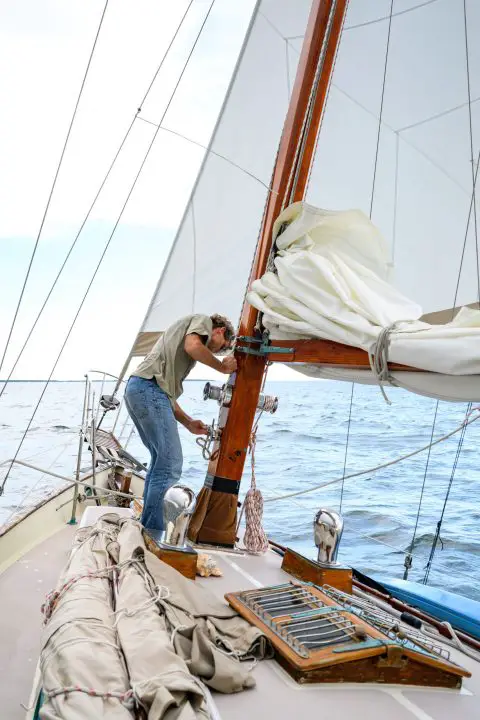
On Deck Sailboat Components – Sailboat Front
The deck of a sailboat is all about safety at sea. Most modern cruising boats are rigged such that there are few things you might need to go “out on deck” or “go forward” for. Instead, these things are rigged back to the cockpit, so you can stay safe and dry while doing your thing.
Since the wet pitching deck of a sailboat at sea is tricky, many of the things you’ll find there are safety-related.
Handholds Places to grab should be located all over the boat, so there’s never a risk of not having something to hold onto to stabilize yourself.
Lifelines Lifelines run the perimeter of the boat and provide a last-ditch safety device. You can grab them, and they should be high enough that they’ll keep you from going overboard.
Stantions The stands that lifelines attach to.
Bow Pulpit The solid rail around the front of the boat provides a safe handhold and a starting point for the lifelines.
Stern Pushpit The same, but on the stern of the boat.
Bulwarks The raised edges of the deck on the sides so that you can’t slip overboard on accident.
No-Skid Decks In areas where people will be walking, the deck is treated with a special product to make the deck “no-skid.” That way, it isn’t slippery, even when wet.
Harness Sailing harnesses are designed to clip onto the boat and keep a sailor onboard even if the boat takes a huge wave or the sailor slips. The harness is the staple of offshore safety.
Jack Lines Jack lines are temporary lines secured on the deck where sailors can attach their harnesses.
Safety Rails Many boats also have extra rails and handholds located in spots where sailors might work on deck, like around the base of the mast.
At the bow of the sailboat, you’ll find her ground tackle.
Bowsprit The bowsprit is the spar that extends from the deck forward of the bow. They’re used on sailboats to gain more sail area since getting the sail farther forward means you can fit a bigger sail. Some have just a spar, while others have a bow platform that is part of the deck.
Ground Tackle The generic word for the anchor, chain, and all the equipment needed to use it.
Anchor The anchor is “the hook” that digs into the seabed and keeps the boat in the same place. Anchors are safety devices since they allow you to stop in shallow water. But they also provide access to areas with no marinas since you can anchor offshore and go in on your dinghy.
Windlass A winch that pulls up the anchor and chain. They can be manual, with a handle, or electric, with a button.
Anchor Rode The generic name for the anchor line. It can be a chain or rope.
Snubber A short length of rope that attaches to the chain to secure it to the boat.
Cleat A horn-shaped piece of deck hardware used to secure a line or rope.
Dorade A large vent opening on the deck of a boat which is designed to let air in but not water.
Hatch Hatches are upward-facing windows that you can open to increase ventilation in the cabin.
Locker A generic term for a cabinet or compartment on a boat.
Going Aloft – Basic Boat Parts of a Sailing Rig
The rig of a boat is the mast and all of its associated parts. If you’re wondering about the many different kinds of rigs that are out there, check out our rundown on sailing terms . There you’ll find definitions for boats with just one mast or multiple masts, like sloop rig and what a boat with two sails in front might be called. It’s a cutter, if you’re wondering.
Spar A generic name for a mast, boom, or any other long pole used to hold a sail. It can be wood or metal or vertical or horizontal.
Mast A vertical spar upon which a sail is hoisted.
Boom A horizontal pole that holds a sail and gives it shape.
Standing Rigging The wires or rope that holds the mast upright.
Stay Standing rigging that goes fore to aft. The head stay runs from the masthead to the bow, and the backstay runs from the masthead to the stern.
Shroud Standing rigging that goes to the sides of the boat. From the masthead to each side runs a cap shroud. Some masts also have intermediate and lower shrouds.
Running Rigging All lines that are used for sail handling are called running rigging.
Halyard A halyard hoists a sail to the top. Each halyard is named for the sail it hoists, i.e., main halyard, jib halyard, spinnaker halyard.
Sheet The sheet controls the sail. If you ease the sheet, the sail is loosened. If you winch the sheet in, it is tightened. Like all running rigging, each sheet is named for the sail it controls, i.e., main sheet, jib sheet, etc.
Traveler If a sail has a boom, the traveler can be used to adjust it from side to side. The sheet is attached to the traveler. Most main sail travelers are located near or in the cockpit.
Gooseneck Fitting The articulating attachment that holds a boom on a mast.
Topping Lift A line that holds the rear end of a boom up. It runs from the masthead to the boom.
Vang A control line pulls the boom down and puts pressure on the sail to keep it flatter. Large boats may have hydraulic or solid vangs.
Blocks The rest of the world would call this a pulley, but sailors call it a block.
Fairleads Deck organizers that keep the lines tidy and running in the direction they should go on deck.
Furler Wraps the sail around the stay so that it doesn’t not have to be raised and lowered each time. Instead, you pull on the sheet and the sail unrolls or “unfurls.”
On Deck – Back of Sailboat
On most boats, the cockpit is located at the back.
Cockpit The main operations center and party central on a sailboat. This is where the skipper sits at the helm, and the linesmen control the sheets.
Coaming The cockpit is protected from waves and splashes by the coaming, the tall walls that enclose it. It also makes the cockpit safe since you are unlikely to get swept overboard from here.
Lazarette The main storage locker in the cockpit.
Helm The station where the skipper steers the boat from.
Tiller If a boat doesn’t have a wheel, it will have a tiller. A tiller is just a handle connected to the rudder, and the skipper pushes or pulls it to steer. Even if a boat has a wheel, it probably has an emergency tiller in case the steering system breaks.
Winch Winches provide a mechanical advantage to make it easier to haul in lines. In the cockpit, all the sheets have winches.
Rope Clutch A clutch locks a rope in place so it can be taken off a winch, even when loaded.
Jammer A jammer does the same as a clutch, but it’s a simpler device found on smaller boats.
Weathervane Steering A weathervane is used to steer the boat like an autopilot but uses wind direction and mechanical linkages. As a result, they use no power and never complain about their workload. They mount on the stern of the boat and are controlled by simple lines to the cockpit. Windvanes are often referred to by their brand name, i.e., Monitor or Hydrovane
Davits Arms on the back of the boat that lift the dinghy or tender.
Swim Platform A flat area on the transom that allows you easy access in and out of the water. A standard feature on newer boats but not on older ones that just had long swim ladders.
Catamaran Sailboat Parts Explained
For the most part, the components of a catamaran share the same terms and labels that they would on a monohull. Cats often have a few extra features with other names, however.
Hulls A catamaran is made with two hulls connected together. Each hull has an interior, just like a monohull sailboat does. The cabins and heads are usually located in the hulls, and sometimes the galley is also down below.
Owner’s Version A catamaran layout that is made for private owners. Usually, one hull will be dedicated to the owner’s stateroom with a private door, a huge head with a walk-in shower, and a large berth.
Charter Version It has more staterooms and heads than an owner’s version does. Usually, a charter cat has at least two staterooms and heads in each hull.
Bridge Deck The deck connects the two hulls, which usually has the salon and cockpit. If the design is “galley up,” the galley will be on the bridgedeck with the salon.
Cockpit Just like on a monohull, the cockpit is the operations center. But catamarans have huge cockpits, and there is usually a large outdoor dining table and entertainment area as well.
Forward Cockpit Some designs have lounge seating forward of the salon on the bridgedeck.
Flybridge Some designs have the main helm mounted on top of the salon on an upper level. It’s almost the catamaran equivalent of a center cockpit.
Trampolines Forward of the salon, the bridge deck stops, and a trampoline connects the hulls over the water. This is a great place to hang out, but it’s an integral safety feature for a catamaran. The trampolines allow any water to immediately drain away, not weighing the boat down on the bow. This prevents a pitchpole when a boat capsizes by tipping forward into the water.
Cross Beam and Dolphin Striker Since there is no center bow to mount the head stay and foresail, catamarans use a cross beam that connects the hull. A piece of rigging keeps this in place, and it’s called the dolphin striker. No dolphins were hurt in the rigging of these boats, however.
Anchor Bridle Instead of a single snubber line on the anchor, catamarans use a wide bridle that connects each hull bow to the anchor line.
Parts of a Sail Boat FAQs
What are parts of a sailboat called.
Sailing is a challenging hobby, and one reason it’s so difficult for beginners is because every part of a sailboat has its own name. From each wire and rope to every piece of deck hardware, a beginner must learn the basics before they can even start.
What is the front part of a sailboat called?
The front part of a sailboat is called the bow. Many boats also have a spar extending forward of the hull, called the bowsprit.
What are the 5 basic parts of every sailboat?
Every sailboat has at least these five parts, but most boats have many more. Hull Keel Rudder Rigging Sails
Matt has been boating around Florida for over 25 years in everything from small powerboats to large cruising catamarans. He currently lives aboard a 38-foot Cabo Rico sailboat with his wife Lucy and adventure dog Chelsea. Together, they cruise between winters in The Bahamas and summers in the Chesapeake Bay.
Leave a comment
Your email address will not be published. Required fields are marked *
Save my name, email, and website in this browser for the next time I comment.
- Types of Sailboats
- Parts of a Sailboat
- Cruising Boats
- Small Sailboats
- Design Basics
- Sailboats under 30'
- Sailboats 30'-35
- Sailboats 35'-40'
- Sailboats 40'-45'
- Sailboats 45'-50'
- Sailboats 50'-55'
- Sailboats over 55'
- Masts & Spars
- Knots, Bends & Hitches
- The 12v Energy Equation
- Electronics & Instrumentation
- Build Your Own Boat
- Buying a Used Boat
- Choosing Accessories
- Living on a Boat
- Cruising Offshore
- Sailing in the Caribbean
- Anchoring Skills
- Sailing Authors & Their Writings
- Mary's Journal
- Nautical Terms
- Cruising Sailboats for Sale
- List your Boat for Sale Here!
- Used Sailing Equipment for Sale
- Sell Your Unwanted Gear
- Sailing eBooks: Download them here!
- Your Sailboats
- Your Sailing Stories
- Your Fishing Stories
- Advertising
- What's New?
- Chartering a Sailboat
The Parts of a Sailboat (of which there are a great many!)
Some parts of a sailboat are very small and cheap, but are far from insignificant. Take the humble clevis pin for example; find one of these on the foredeck and you've cause to be concerned for the security of your rig!
If we were going to discuss all the parts of a sailboat here, it would be a very long article indeed - but relax, that's not going to happen.
Let's make a start with...
The Parts of a Sailboat Above Deck
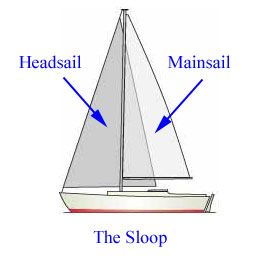
Dacron is the usual choice of sailcloth for cruisers although laminated sails are becoming more common, and moulded sails are the first choice for racing sailors.
Read more about sails...
The Rigging
The standing rigging , generally made up in 1x19 stainless-steel wire, supports the mast.
The forestay and backstay secure the mast in the fore-and-aft plane, and the shrouds secure it athwartships.
The ends of the stays and shrouds are secured to the structural elements of the hull via chainplates.
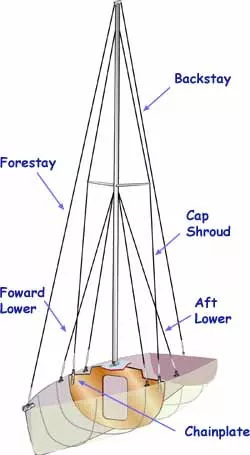
The running rigging is the collective name for the lines (halyards, sheets, topping lifts, uphauls, downhauls etc) that control the sails. Their working ends are attached either directly to the sails or, in the case of the headsail, to the boom.
Read more about sailboat rigging...
These are the rigid struts, generally fabricated in alloy, wood or carbon fibre whose job it is to deploy the sails. For example:
- The spinnaker pole;
- The whisker pole;
- The bowsprit;
- The boomkin.
Read more about sailboat masts...
The Cockpit
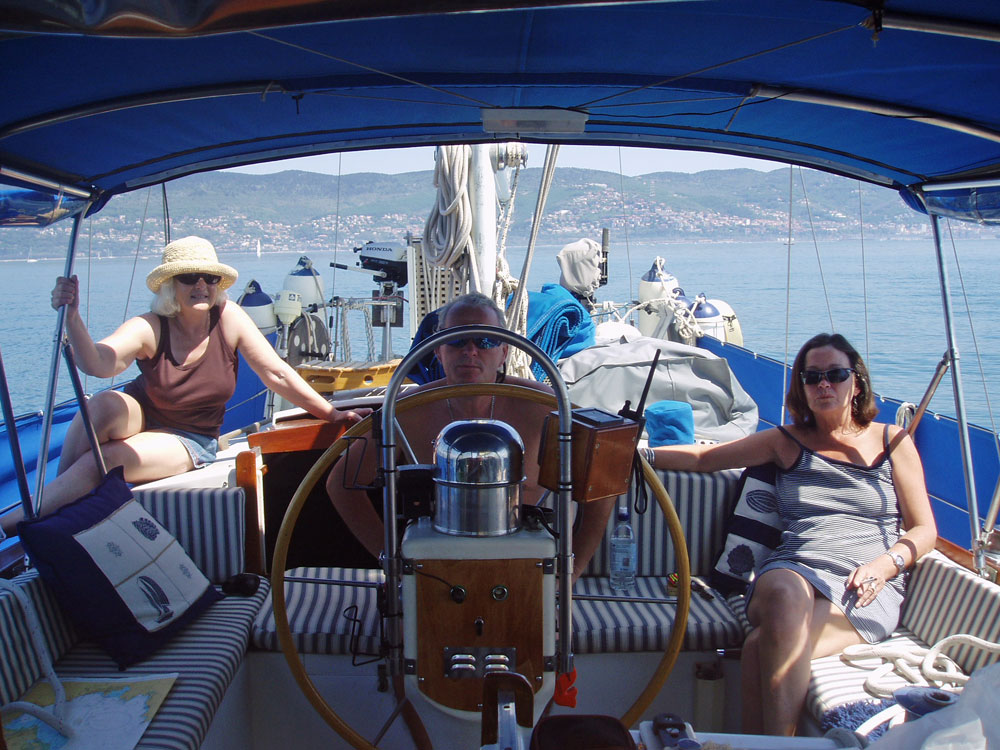
Like many cruising boats, the Ted Brewer designed Whitby 42 ketch pictured above has a centre-cockpit, which allows for the provision of a sumptuous aft-cabin below. Nevertheless, aft-cockpit boats have a great following with seasoned cruisers too. So what the aft versus centre-cockpit pro's and con's?
Tillers and Wheels
Smaller boats tend to be tiller-steered while larger ones, as in the image above, have wheels. Tillers are attached directly to the rudder stock; wheels are located remotely and operate the tiller through chain or hydraulic linkage.
Each approach has their devotees, but what are the arguments for and against?
The Parts of a Sailboat Below the Waterline
Keels & rudders.
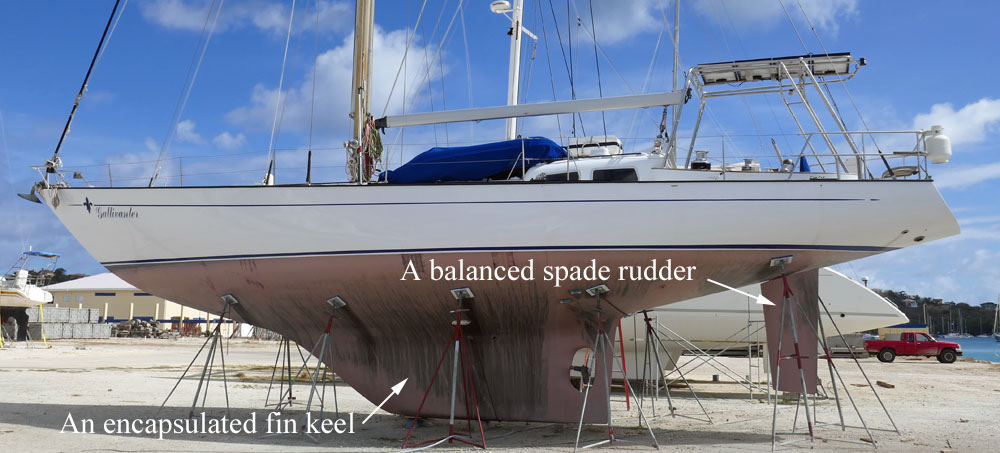
Keels provide three key attributes in varying amounts depending on their design : directional stability, ballast, and lift to windward.
Rudders provide steerage and a small contribution towards lift to windward. They are either:
- Outboard or inboard rudders, which can be
- Unbalanced, balanced or semi-balanced, and be
- Keel-hung, skeg-hung, transom-hung or spade rudders.
Rudder types are discussed here...

Driven by the boat's diesel engine, the propeller allows good progress to be made when the wind is not cooperating.
Under sail though the propeller is redundant and the fixed blades provide nothing but unwanted drag. This is greatly reduced if the blades can fold aft in a clamshell arrangement or feather in self-alignment with the water flow.
Sailboat propellers are either 2 or 3-bladed - and you can read more about them here...
Below Decks

There's no 'standard' layout for the below-decks accommodation on a sailboat, although the one shown above is a popular choice.
Some layouts work well for offshore sailing whereas others are much less suitable - here's why some succeed where others fail...
Recent Articles
Pearson 33 for sale
Sep 04, 24 03:29 PM
Apla 42 Sailboat Specs & Key Performance Indicators
Aug 30, 24 02:51 AM
Ovni 445 Sailboat Specs & Key Performance Indicators
Aug 29, 24 03:44 AM
Here's where to:
- Find Used Sailboats for Sale...
- Find Used Sailing Gear for Sale...
- List your Sailboat for Sale...
- List your Used Sailing Gear...
Our eBooks...

A few of our Most Popular Pages...

Copyright © 2024 Dick McClary Sailboat-Cruising.com
Sail Parts Names: A Comprehensive Guide
by Emma Sullivan | Aug 16, 2023 | Sailboat Racing

== Short answer sail parts names ==
Sail parts names include the mainsail, jib, spinnaker, mast, boom, halyard, sheet, and clew. These components play crucial roles in controlling and manipulating a sail’s shape and position to optimize performance and maneuverability.
1) Understanding Sail Parts Names: A Comprehensive Guide
Understanding Sail Parts Names: A Comprehensive Guide
Sailing is a fascinating and adventurous activity, but it can also be quite technical and complex. As a novice sailor , learning about the different parts of a sail and their functions is vital to ensuring safe and enjoyable sailing experiences. In this comprehensive guide, we will delve into the intricate world of sail parts names, providing you with an in-depth understanding of each component. So sit back, relax, and prepare to embark on an enlightening journey through the sails !
1) Mainsail: The mainsail is the largest and most essential sail on a yacht or sailboat . It is typically located at the back or middle of the vessel and plays a crucial role in driving the boat forward by capturing wind power. The mainsail consists of several key components:
– Head: This is the topmost point of the mainsail where it attaches to the mast.
– Luff: The luff refers to the leading edge of the mainsail running vertically along its length. It connects to the mast using either slides or bolt ropes.
– Leech: The leech is the aft edge or trailing edge of the mainsail which allows for controlled airflow over its surface.
– Foot: Located at the lower edge of the mainsail, perpendicular to both luff and leech, it represents its base.
– Battens: Battens are stiff strips inserted into pockets along the length of a sail’s trailing edge (leech). They add stability and help maintain proper shape when sailing close-hauled.
2) Jib/Genoa: Another important sail found on most yachts or sailboats is called either a jib or genoa, depending on its size. These sails are positioned towards the bow (front) area and contribute significantly to steering and controlling boat speed.
– Headstay/Forestay: A wire or cable that supports this front-facing sail from connecting directly to the bow of the boat.
– Tack: This refers to the bottom forward corner of the jib or genoa where it attaches to the boat.
– Clew: The aft bottom corner of a jib/genoa is known as the clew. It is responsible for adjusting and controlling the shape of these sails .
3) Spinnaker: For those seeking more excitement and speed, the spinnaker sail comes into play. This large, colorful sail is specially designed for downwind sailing and adds an element of thrill to your sailing adventures.
– Tri-radial Cut: A popular design choice, creating three panels that converge at predetermined points on the sail , enhancing its strength while maintaining shape in varying wind conditions.
– Chutes (or Sheets): The lines running from either side of the spinnaker leading back to adjustable blocks located near the cockpit. These enable control over the angle at which wind fills in and powers up this specialized sail .
4) Bowsprit: Not a sail per se, but a critical component nevertheless. The bowsprit extends forward from a vessel’s bow (front) and provides additional support for headsails such as jibs or genoas when deployed.
Understanding these Sail Parts Names will greatly assist you in effectively communicating with fellow sailors and understanding instructions during your ventures on water. Now armed with this comprehensive guide, you are truly ready to set sail with confidence! Happy sailing!
Note: Including witty remarks can add a touch of humor to engage readers further.
2) How to Navigate the Seas of Sail Parts Names: Step-by-Step Breakdown
Sailing can feel like a whole new world with its own language. As you embark on your sailing journey, understanding the various sail parts names is crucial for effective communication and smooth sailing. Fear not! We’ve got you covered with this step-by-step breakdown to help navigate the seas of sail parts names with ease.
1. Main Sail: Let’s start with the most prominent sail on any sailing vessel – the main sail. It is typically located at the rear of the boat, attached to the mast and boom. The main sail provides the primary source of propulsion and can be adjusted using lines called halyards and sheets (more on those later).
2. Jib/Genoa: Moving forward, we have another essential part of a sailboat – the jib or genoa. This triangular-shaped sail is situated at the front of the boat and helps balance out the driving force provided by the main sail. It connects to a forestay, stretching from bow to masthead.
3. Mast: The mast is a tall vertical structure that supports all your sails, providing stability and strength to your vessel. It holds up everything else, so it should never be overlooked! Attachments on the mast include spreaders (horizontal bars) that keep shrouds (supporting wires) in place.
4. Boom: Moving downward from the mast, we encounter an essential component – the boom. The boom extends horizontally at or near deck level and holds out the lower edge of your main sail via a system known as a gooseneck.
5. Headsail Furler: If you’re particularly lucky, your jib/genoa might be attached to a headsail furler mechanism, making it easy to roll or unfurl whenever needed. This handy device eliminates tedious manual handling of large head sails .
6. Halyards: These lines are used to raise or lower sails along their respective tracks attached to the mast . The main halyard raises the main sail, while the jib/genoa halyard does the same for the forward sails.
7. Sheets: Sheets are essential lines used to control the trim or angle of your sails relative to wind direction. The mainsheet controls the main sail, and jib/genoa sheets adjust the position and tightness of those sails . Knowing how to handle these lines is crucial for adjusting sail shape and optimizing performance.
8. Outhauls and Cunningham: These lines aid in controlling tension and shaping of your main sail . Outhauls adjust the foot (bottom edge) tension, while cunningham lines control tension along the luff (leading edge).
9. Cleats: Finally, don’t forget about cleats! These conveniently shaped devices secure lines by providing a quick way to fasten or release them as needed. A cleat hitch allows you to lock a line securely in place with minimal effort.
By familiarizing yourself with these sail parts names, you’ll be well-equipped to communicate effectively with crewmates and handle various sailing maneuvers confidently. So hoist those sails, trim those sheets, and navigate smooth sailing waters like a seasoned sailor!
Remember, practice makes perfect when it comes to understanding sail parts names and their functions within your unique sailing vessel design—bon voyage on your journey towards becoming a seasoned sailor!
3) Sail Parts Names FAQ: Your Burning Questions Answered
Ah, the world of sailing ! Whether you’re a seasoned sailor or just dipping your toes into this exhilarating sport, understanding the various parts that make up a sail can be quite perplexing. Fear not, dear reader! We have compiled a comprehensive list of frequently asked questions to shed some light on the mysterious world of sail parts names.
1. What is the purpose of a luff?
Picture this: you’re out on the open water , wind fiercely blowing against your sails. The luff is that glorious central part of the sail that runs parallel to the mast. Its primary purpose is to allow for optimal airflow through its sleek design, harnessing and maximizing the power of the wind .
2. What on Earth is a headboard?
No, we’re not referring to an office supply mishap here! The headboard in sailing lingo refers to a vital component located at the topmost corner of the mainsail – it’s like the crown jewel of your sail. This sturdy piece helps maintain proper shape and tension while keeping your vessel steady even when facing gusty winds.
3. Can you demystify what exactly battens are?
Oh, those elusive battens! These slender pieces are inserted into pockets within a sail’s body perpendicular to its leech or trailing edge. Think of them as tiny superheroes with one major mission: maintaining proper shape and stability during those intense maneuvers on choppy waters. They prevent sagging and help distribute wind pressure evenly across your sail .
4. Tell me more about clews; they sound intriguing!
Clews may sound like something out of a seafaring adventure novel but fear not; they are real and critically important in sailing! Clews refer to corners located at both bottom edges (foot & leech) on any given sail – be it mainsail or jib . These clever little corners allow for easy attachment to various points on the boat, ensuring that your sail is securely in place.
5. What’s the secret behind a cunningham?
Ah, the cunningham – a well-kept secret among sailors! This clever contraption allows for fine-tuning and adjusting the tension of your mainsail. Located at the luff’s lowest point, usually close to the tack (the lowest corner of any sail), it allows you to tweak the shape of your sail to perfection according to wind conditions or personal preference.
6. Could you unravel the mystery behind telltales?
Telltales are small strips of material placed strategically on both sides of a sail – they may seem insignificant, but trust us when we say they hold profound importance! These humble indicators provide vital feedback about airflow across your sail’s surface. By observing how these telltale strips flutter or remain stagnant, experienced sailors gain invaluable insights into making optimal adjustments and keeping their vessel gliding smoothly through diverse winds.
Now armed with this newfound knowledge of sail parts names, you can confidently converse with fellow seafarers and give any landlubber a run for their money! So hoist those sails high, catch that favorable breeze, and set forth on your next sailing adventure with a newfound appreciation for each nuanced piece that makes up this awe-inspiring sport.
4) Demystifying the Vocabulary of Sailing: Unveiling Sail Parts Names
Title: Demystifying the Vocabulary of Sailing: Unveiling Sail Parts Names
Introduction:
When it comes to sailing, the world seems to have its own secret language. From bowlines to clews, and from jibs to halyards, understanding the various sail parts can seem overwhelming for beginners. But fear not! In this blog post, we are here to demystify the vocabulary of sailing and unveil the names of sail parts that will help you navigate the seas like a true sailor. So grab your life jacket, set sail with us, and let’s unravel this linguistic adventure!
1) The Mast – Rising Above All:
At first glance, you’ll notice a tall vertical structure looming over any sailboat. Yes, that’s the mast! Standing tall and sturdy, it serves as the backbone of your vessel. Raising your sails high into the air is made possible by securing them to this majestic mast.
2) The Boom – Not Just an Onomatopoeic Sound:
The second key component is called the boom. Known for its distinctive “Boom!” sound during sail adjustments (hence its name), this horizontal pole extends outward from the mast’s bottom end. The boom helps maintain proper shape and tension in your mainsail.
3) Mainsail – Your Mighty Power Source:
Let’s move on to arguably one of the most important components—the mainsail. This large triangular-shaped sail spreads across most of your boat ‘s length like a mighty banner catching wind powerfully. It can be adjusted using various lines or halyards to optimize speed and maneuverability.
4) Jib – Your Trusty Sidekick:
Introducing your vessel’s loyal companion, known as the jib! Smaller than the mainsail but equally important, this triangular or trapezoidal-shaped fore-sail attaches near the front of your boat (the bow). Providing extra propulsion when sailing against wind (or “upwind “), the jib is crucial for controlling speed and balance.
5) Halyard – Hoisting Your Sails:
Think of the halyards as the magical lines responsible for raising and lowering your sails. They connect to each corresponding sail at various points called “tack” or “clew.” The main halyard handles raising and lowering the mainsail, while a separate jib halyard performs this action for the jib. Pay attention to these lines, as they play a significant role in control and smooth operation.
6) Clew – Securing Sail Corners:
Moving on to more intricate details, let’s focus on clews. Picture these as the corners of your sails, farthest away from the mast. Clews are often reinforced with metal rings or grommets and connected to their respective sheets—lines that control their tension. Adjusting these helps fine-tune the shape of your sails according to wind conditions.
Conclusion:
By decoding this sailing language bit by bit, we have managed to demystify some essential terms associated with sail parts for you. Whether familiarizing yourself with words like mast, boom, mainsail, jib, halyard, or clew—it’s beneficial to grasp their functions within a sailboat system.
So next time you embark on a sailing adventure or engage in conversation with seasoned sailors, speak confidently! Incorporate these newfound vocabulary gems into your repertoire and bask in the glory of being an informed sailor ready to commandeer any open waters safely and effortlessly.
5) Mastering Sail Parts Names: A Beginner’s Guide for Aspiring Sailors
Title: Unmasking the Veiled Secrets of Sail Parts Names: A Comprehensive Guide for Novice Sailors
Introduction: Aspiring sailors, are you ready to embark on a thrilling journey into the world of sailing ? Before you set sail and let the wind carry you away, it’s essential to familiarize yourself with the intricate anatomy of a sail. In this extensive guide, we will dive deep into the mysterious realm of sail parts names, equipping you with invaluable knowledge that will make you a true connoisseur of sailing terminology. So loosen your grip on reality and tighten your knot-tying skills as we unravel the enigma of these fascinating components!
1) The Mast: Reaching New Heights Let’s start at the top with the majestic mast – an upright structure that stands tall and proud, defying gravity. This vertical behemoth serves as both a support system and a vital channel for raising your sails towards salvation! As its towering presence casts a shadow over adventurous sailors like yourself, embrace its strength and elegance.
2) Boom: Controlling Your Sailing Symphony Ahoy, maestro! Allow us to introduce the conductor of your sailing symphony – the boom. Like a baton guiding an orchestra, this horizontal spar attaches securely to the bottom edge of your mainsail. With unrivaled precision, it dictates how harmoniously or wildly your sails dance in tandem with nature’s rhythms. So wield it wisely, for it holds the power to tame or unleash Poseidon’s fury!
3) Halyard: The Puppeteer Holding The Strings Ever wondered how those enchanting sails ascend effortlessly to touch the heavens? Meet their master manipulator – the halyard! Hidden from plain sight but vitally important nonetheless, this rope-like lifeline hoists your sails aloft in answer to nature’s whimsical commands . Packed with potential energy and anticipation, every tug empowers mere mortals to defy gravity’s earthly grasp!
4) Jib: Guardian of Sailing’s Frontline Venture forward, eager seafarers, and lay eyes upon the jib – the unsung hero guarding your sailing endeavors upfront. Poised at the bow, this triangular sail complements its illustrious sibling (the mainsail) by capturing wind from the opposite side. Unyielding in its duty, it bolsters speed, provides stability, and adds a touch of elegance to your adventurous odyssey.
5) Sheets: The Dancefloor for Sailing Serenades As your sails flutter to the rhythm of zephyrs and gales alike, their graceful movements are orchestrated by none other than the sheets. These humble yet pivotal ropes control the trim and angle of your sails, embracing a mesmerizing pas de deux with every shift in wind direction. So tie them tight – like dance partners entwined in perfect harmony – and let them guide you through uncharted waters with effortless grace.
Conclusion: Now that you’ve been initiated into the secret society of sailors who speak the language of sails, you possess a powerful arsenal of knowledge. Embrace this newfound expertise as you navigate unexplored horizons alongside fellow enthusiasts who share your fervor for adventure upon the open seas . With mastery over sail parts names firmly under your belt, set forth confidently towards thrilling experiences that will forever enrich both mind and soul. Bon voyage!
6) Everything You Need to Know About Sail Parts Names: From Bow to Stern
If you’ve ever been on a sailboat or even just admired one from afar, you know that the art of sailing involves much more than wind in the sails. Sailboats are finely-tuned machines with numerous parts and components working together to navigate the vast blue expanse. Understanding sail parts names is essential for anyone wanting to set foot (or rather, set sail) into the world of sailing. From bow to stern, let’s dive into everything you need to know about these crucial elements.
1. Bow: Let’s start at the front! The bow is the forward-most part of a sailboat ‘s hull, designed to cut through water efficiently and minimize drag. It is important to note that when we refer to port and starboard sides (left and right), it is from facing toward the bow.
2. Mast: Rising tall above everything else, the mast is like the backbone of a sailboat . It supports all vertical rigs such as sails and booms while also transmitting forces between them and the hull.
3. Boom: Moving toward the stern brings us to one of the most recognizable sail parts – the boom. It extends horizontally from beneath the mast, parallel to the deck, effectively holding down one edge of a mainsail.
4. Mainsail: This expansive triangular-shaped sail affixed along its leading edge (luff) attaches directly or indirectly to both mast and boom. Controlled by halyards (ropes used for raising and lowering sails), sheets (ropes used for adjusting position), and various lines called reefing lines (used for reducing area during strong winds), it powers much of a boat ‘s propulsion.
5. Headsail or Jib: Positioned ahead of or abaft (closer towards stern) from where you’re standing, headsails come in different variations like jibs or genoas depending on their size relative to your mainsail or particular rig type you’re carrying. These sails help balance the forces produced by the mainsail while enhancing maneuverability and performance .
6. Shrouds: Supporting the mast laterally on both port and starboard sides, shrouds consist of steel or synthetic cables, often reinforced with turnbuckles to adjust tension. These vital components keep the mast upright and prevent excessive side-to-side movement.
7. Stay: While shrouds resist lateral forces, stays control fore-and-aft (front-to-back) motion of the mast. Leading from either bow or stern to various points on a mast, these wire ropes provide stability and help distribute loads under different sailing conditions.
8. Winch: Behind every victorious sailor is a trusty winch! Used to trim or ease sheets, halyards, and other lines wrapped around it, winches provide mechanical advantage through gears and handle rotations. They make managing heavy loads a breeze!
9. Tiller or Wheel: Commanding at the helm requires more than just a firm grip; one needs either a tiller or wheel depending on the boat design. The tiller is typically found in smaller boats and directly connects to the rudder for steering control.
10. Rudder: Attached to the stern (back) of a sailboat below waterline, rudders steer boats when turned left or right via their connection with tillers or wheel mechanisms controlled by sailors’ hands.
Understanding these sail parts names allows sailors to communicate efficiently and effectively onboard while also empowering them to troubleshoot problems that may arise during those thrilling moments out at sea. So whether you’re about to embark on your first sailing adventure or simply have an admiration for these majestic vessels, knowing your way around a sailboat is both practical and fascinating!
Recent Posts

- Sailboat Gear and Equipment
- Sailboat Lifestyle
- Sailboat Maintenance
- Sailboat Racing
- Sailboat Tips and Tricks
- Sailboat Types
- Sailing Adventures
- Sailing Destinations
- Sailing Safety
- Sailing Techniques

What is a Sailboat Mast?

Last Updated by
Daniel Wade
June 15, 2022
A sailboat mast is the towering pole mounted to the deck. It attaches the length of the sail to the boat and supports the shape of the sail.
Sailboat masts are the most distinct feature of sailing vessels, and they hold the sails in place. Masts are often taller than the length of the boat. Most modern sailboat masts are made of aluminum, though traditional boats use wood. Sailboat mast type varies based on what type of sail plan they support.
Table of contents
Parts of the Mast
The mast itself is simply a pole and won't function without several essential parts. Starting from the deck is the mast boot, which keeps water from draining down the mast and into the cabin. The long wires connected to the mast on each side are the stays, and they keep the mast upright under tremendous force. The boom connects to the mast using a gooseneck fitting. Halyard lines, which run to the top of the mast, are used to raise and lower the sail.
Single-Mast Rigs
Single mast sailboats are what most people picture when they think of modern sailing craft. Single mast boats are popular because they're inexpensive to produce and relatively easy to operate singlehanded. The most common kinds of single-mast rigs are sloops, cutters, and catboats.
Sloop rig boats are the most common kind of sailboat today. Sloops feature a single mast mounted somewhere on the forward 3/5 of the deck, but some boat designs differ slightly. Generally speaking, a sloop mast lies somewhere in the middle to the forward-middle of the deck.
Sloop masts are rigged for a large mainsail and a jib. Bermuda-rigged sloops utilize a tall single mast and triangular sail. Gaff-rigged sloops, which are less common, use a much shorter mast and a larger four-point mainsail.
Catboat Mast
Catboats are unique vessels common to New England and feature a forward-mounted single mast and a long boom. Unlike sloop-rigged boats, catboats are only rigged for a single sail. Catboat masts are generally mounted almost at the very front of the boat, and they're often short and quite thick.
Catboats are almost often gaff-rigged. Gaff-rigged sail plans make the most of short masts and are relatively easy to control in a single-mast configuration. Gaff-rigged catboat masts are shorter than Bermuda-rigged boats of similar size but generally taller than similar gaff-rigged craft.
Cutter Mast
Cutter-rigged sailboats feature a tall single mast and multiple headsails. Visually, cutters are easy to mistake for sloops. But the mast of a cutter is usually taller than a comparably-sized sloop, as it utilizes multiple headsails instead of a single jib.
Gaff-rigged cutters are much more common than gaff-rigged sloops in many areas. Cutters are easy to distinguish from sloops, even when the sails are stowed. This is because cutters often feature a long bowsprit and two front stays (forestay and jib stay).
Multi-Mast Rigs
Mult-mast rigs are less common than single-mast configurations. That said, multi-mast sailboats are often elegant and seaworthy. Though they offer more than just good looks—multiple masts offer speed and precise control for experienced sailors. Most of these vessels feature two masts, which are often shorter than masts on comparably-sized single-mast craft. The most common variations are yawl rigs, ketch rigs, and schooner rigs.
Yawls are robust multi-mast vessels that vary in length from 20 feet to well over 50 feet. A yawl features a long forward mainmast and a short mizzen mast located towards the back of the boat. Yawls are often gaff-rigged and were once used as utility boats.
Yawl rigged sailboats can use the mizzen mast and sail as a form of self-steering. The yawl is easy to distinguish from other two-masted vessels, as the mizzenmast is comparably short—often about half the size of the mainmast. Additionally, the mizzen mast is positioned aft of the rudder post.
Ketch Masts
At first glance, a ketch can be mistaken for a yawl. But the ketch features two similarly-sized masts and a much larger mizzen. The mizzen mast on a ketch is positioned forward of the rudder post. Ketch-rigged boats are often gaff-rigged as well, utilizing topsails on both masts. Some ketch-rigged boats have triangular sailplanes, mitigating the need for topsails.
Like the yawl, the ketch utilizes a headsail, a mainsail , and a mizzen sail, which is comparable in size to the mainsail. Ketch-rigged boats can be sailed with one or more aft sails stowed.
Schooner Masts
Schooners are among the most elegant multi-mast sailboat types. Schooners are visibly closer to ketches than yawls. But upon closer inspection, a schooner will have a shorter foremast and a longer (or almost equally-sized) mast behind it.
Schooner masts are tall and thick but usually shorter than similarly-sized single mast boats. This is because two-masted vessels distribute the sail plan over two masts and don't need the extra length to make up for lost sail area. Schooners are usually gaff-rigged and often utilize topsails and topmasts that extend the height of the mast.
Tall Ship Masts
Tall ships are the classic large sailing vessels that dominated the oceans for hundreds of years before the age of steam. Famous vessels such as the U.S.S. Constitution and the H.M.S. Victory feature this enormous and complex rig configuration.
Tall ships have three or more enormous masts, which are often made from entire tree trunks. Some of the largest tall ships have five or more masts. Tall ships are usually 100 feet in length or greater, as the size and complexity of these square-rigged ships make them only practical at scale. Tall ships utilize one or more mainmasts, mizzenmasts, a foremast, and a gaff-rigged jigger mast aft of the mizzenmast.
Sailboat Mast Materials
Sailboat masts are usually made out of aluminum or certain varieties of wood. Up to the 1950s, virtually all sailboat masts were made of wood. That changed around the same time that fiberglass boats became popular. Today, aluminum is the most common mast material.
Aluminum Sailboat Masts
The most common modern mast material is aluminum. Aluminum masts are lightweight, hollow, and easy to manufacture. These relatively inexpensive masts hold up well to salt water. Aluminum masts are also strong for their weight.
One downside to aluminum masts is galvanic corrosion, which occurs frightfully fast when saltwater comes into contact with aluminum and another metal (such as steel or copper). Aluminum masts are most common on Bermuda-rigged sloops.
Wood Sailboat Masts
Wood is the traditional material for sailboat masts, and it's still used today on many custom boats. Wood masts are heavy but strong, and a well-maintained wood mast can last over a hundred years. Wooden masts are common on gaff-rigged boats, as wood is an ideal material for shorter masts.
The most common mast wood comes from the Fir family. Douglas fir is common, but regional varieties (such as British, Columbian, and Yellow fir) are perfectly suitable. Some sailboats (particularly tall ships) use pine or redwood as a mast material. Some varieties of cedar (such as Port Orford cedar, Oregon cedar, and white cedar) are also excellent materials for building masts and spars.
Carbon Fiber Masts
Carbon fiber masts are a new arrival to boatbuilding, and they offer some advantages to wood and aluminum masts. Carbon fiber is lightweight and extremely strong, which makes it ideal for tall-masted racing sailboats. Vessels that compete in America's Cup races utilize the most premium carbon fiber masts in the industry.
Unlike wood (and aluminum to some extent), carbon fiber masts aren't particularly flexible. The rigidity of carbon fiber makes it strong, but stiffness is also a weakness. Under the right conditions, carbon fiber masts can break violently and are impossible to repair once broken.
Mast Maintenance
It's essential to maintain your mast and all of its accompanying hardware. Mast stays, lines, and halyards should be inspected regularly, adjusted, and replaced at regular intervals. Wooden masts should be varnished and checked for signs of rot.
Aluminum masts are generally low-maintenance, but signs of corrosion warrant immediate repair. Work with your local boat mechanic or sailing expert to develop a comprehensive maintenance plan. And remember, preventative maintenance is always cheaper and easier than repairs.
Related Articles
I've personally had thousands of questions about sailing and sailboats over the years. As I learn and experience sailing, and the community, I share the answers that work and make sense to me, here on Life of Sailing.
by this author
Sailboat Parts
Learn About Sailboats
Most Recent

What Does "Sailing By The Lee" Mean?
October 3, 2023

The Best Sailing Schools And Programs: Reviews & Ratings
September 26, 2023
Important Legal Info
Lifeofsailing.com is a participant in the Amazon Services LLC Associates Program, an affiliate advertising program designed to provide a means for sites to earn advertising fees by advertising and linking to Amazon. This site also participates in other affiliate programs and is compensated for referring traffic and business to these companies.
Similar Posts

Affordable Sailboats You Can Build at Home
September 13, 2023

Best Small Sailboat Ornaments
September 12, 2023

Discover the Magic of Hydrofoil Sailboats
December 11, 2023
Popular Posts

Best Liveaboard Catamaran Sailboats
December 28, 2023


Can a Novice Sail Around the World?
Elizabeth O'Malley

4 Best Electric Outboard Motors

How Long Did It Take The Vikings To Sail To England?

10 Best Sailboat Brands (And Why)
December 20, 2023

7 Best Places To Liveaboard A Sailboat
Get the best sailing content.
Top Rated Posts
© 2024 Life of Sailing Email: [email protected] Address: 11816 Inwood Rd #3024 Dallas, TX 75244 Disclaimer Privacy Policy

Basic Sailing Terminology: Sailboat Parts Explained
Sailing is a timeless activity that has captivated the hearts of adventurous souls for centuries. But, let’s face it, for beginners, sailing can be as intimidating as trying to navigate through a dark, labyrinthine maze with a blindfold on. The vast array of sailing terminology, sailboat parts and jargon can seem like a foreign language that only the most experienced seafarers can comprehend.
Fear not, intrepid sailor, for this comprehensive guide on basic sailing terminology for beginners will help you navigate the choppy waters of sailing jargon with ease. From learning the difference between the bow and stern to mastering the intricacies of sail trim, this article will equip you with all the knowledge you need to confidently take to the seas. So hoist the mainsail, batten down the hatches, and let’s set sail on this exciting journey of discovery!
Parts of a Sailboat
Before you can begin your sailing adventure, it’s important to familiarize yourself with the different parts of a sailboat. From the sleek bow to the sturdy keel, each component plays a vital role in keeping your vessel afloat and propelling you forward through the waves.

- Hull The main body of the boat that sits in the water and provides buoyancy and stability.
- Bow The front of the boat that meets the water and helps to determine its direction.
- Stern The rear of the boat where the rudder and motor are located.
- Deck The flat surface of the boat that you stand on, which can include various features such as seating, storage compartments, and hatches.
- Cockpit The recessed area of the deck where the skipper and crew sit or stand while sailing, which allows for easy access to the sail controls and provides protection from the wind and waves.
- Keel The long, fin-shaped structure beneath the waterline that helps to keep the boat stable and upright.
- Rudder The flat, vertical surface located at the stern of the boat that is used to steer and control the direction of the boat.
- Tiller or wheel The mechanism used to steer the boat, either in the form of a tiller (a handle attached to the rudder) or a wheel (similar to the steering wheel of a car).
- Mast The tall, vertical pole that supports the sails and allows you to catch the wind and move through the water.
- Boom The horizontal pole extending off the bottom of the mast that holds the bottom edge of the mainsail.
- Mainsail The large, triangular-shaped sail attached to the mast and boom that captures the wind’s power to propel the boat forward.
- Jib The smaller, triangular-shaped sail attached to the bow that helps to steer the boat and balance the force of the mainsail.
- Rigging The network of ropes and cables that hold the mast and sails in place and help control their movement.
Sail Terminology
Understanding the terminology associated with sails is critical to becoming a successful sailor. Here are 12 of the most important sail terms you should know, along with brief explanations for each:

- Luff The forward edge of a sail that is attached to the mast, allowing you to adjust the sail’s shape and angle to catch more wind.
- Leech The aft edge of a sail that is attached to the boom, which helps to control the sail’s shape and release the wind as needed.
- Foot The lower edge of a sail that is attached to the boom, which helps to control the sail’s shape and power.
- Head The top of a sail that is attached to the mast and controls the sail’s overall shape and angle.
- Battens The long, thin strips inserted into the pockets of a sail to help maintain its shape and stiffness.
- Clew The bottom corner of a sail that is attached to the boom or sheet, which helps to control the sail’s shape and power.
- Tack The bottom forward corner of a sail that is attached to the boat or a line, which helps to control the sail’s shape and power.
- Sail Area The total area of a sail, which is measured in square feet or meters.
- Sail Draft The curve or depth of a sail, which affects its performance and power.
- Sail Shape The overall form and contour of a sail, which is critical for catching the wind effectively.
- Reefing The process of reducing the sail area by partially lowering or folding the sail, which can be necessary in strong winds or heavy seas.
- Furling The process of rolling or folding a sail to reduce its size or stow it away, which is often used when entering or leaving port or in rough conditions.
Wind Direction and Sail Positioning
Understanding wind direction and sail positioning is crucial for successful sailing. Here are the key terms you need to know:
Types of Wind

- Apparent Wind The wind that is felt on the boat, which is a combination of the true wind and the wind generated by the boat’s movement.
- True Wind The actual direction and strength of the wind.
Points of Sail
You can find a detailed explanation of the points of sail here

- Close-Hauled Sailing as close to the wind as possible, with the sail set at a sharp angle to the boat.
- Beam Reach Sailing perpendicular to the wind, with the sail set at a right angle to the boat.
- Broad Reach Sailing with the wind at a diagonal angle behind the boat, with the sail angled away from the boat.
- Running Sailing directly downwind, with the sail on one side of the boat.
Other Terms
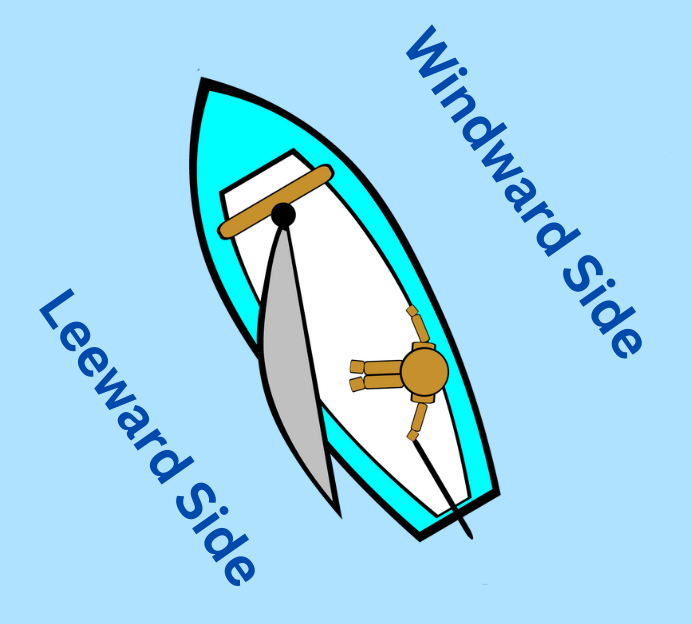
- Windward The side of the boat that is facing the wind.
- Leeward The side of the boat that is sheltered from the wind.
- Sail Trim Adjusting the sail and rigging to maximize the power and efficiency of the sailboat.
Navigation Terminology
Navigating a sailboat requires an understanding of a variety of nautical terms. Here are some of the most important terms you should know:
- Starboard Side The right side of a boat
- Port Side The left side of a boat
- Compass A device used for determining the boat’s heading or direction.
- Bearing The direction from the boat to a specific point on land or water.
- Chart A map or nautical publication that displays water depths, navigational aids, and other important information for safe navigation.
- Latitude The angular distance between the equator and a point on the earth’s surface, measured in degrees, minutes, and seconds.
- Longitude The angular distance between the prime meridian and a point on the earth’s surface, measured in degrees, minutes, and seconds.
- Course The direction in which the boat is traveling.
- Plotting The process of marking a course on a chart or map.
- Waypoint A specific point on a navigational chart or map that serves as a reference point for plotting a course.

- Tacking This maneuver involves turning the bow of the boat through the wind in order to change direction. To tack , the sailor will turn the helm towards the wind until the sails begin to luff, then quickly steer the boat in the opposite direction while adjusting the sails to catch the wind on the new tack.
- Jibing This maneuver is similar to tacking, but involves turning the stern of the boat through the wind. To jibe, the sailor will steer the boat downwind until the sails begin to luff, then quickly turn the stern of the boat in the opposite direction while adjusting the sails to catch the wind on the new tack.
- Heading up This maneuver involves turning the boat closer to the wind in order to sail upwind. To head up, the sailor will turn the helm towards the wind while simultaneously trimming the sails in to maintain speed and prevent the boat from stalling.
- Falling off This maneuver involves turning the boat away from the wind in order to sail downwind. To fall off, the sailor will steer the helm away from the wind while simultaneously easing the sails out to catch more wind and accelerate the boat.
- Docking This maneuver involves bringing the boat alongside a dock or other fixed object in order to moor or disembark. To dock, the sailor will typically approach the dock at a slow speed while using lines and fenders to control the boat’s position and prevent damage.
Knots and Lines
Learning the right knots and lines to use is essential for any sailor. Here are some of the most important knots and lines to know:
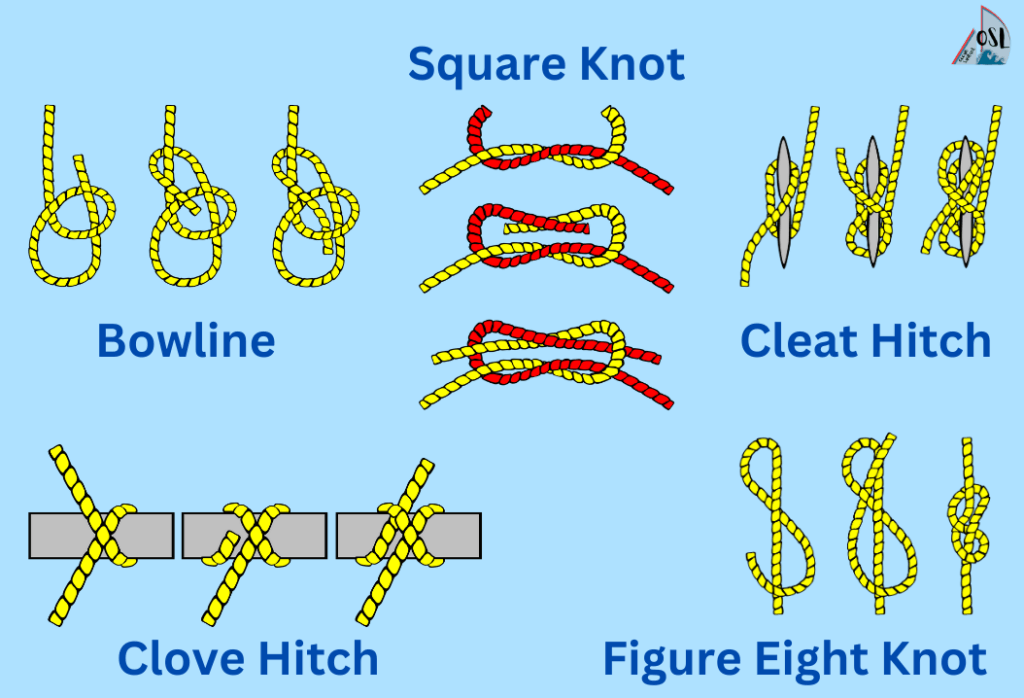
- Bowline This is a versatile knot used for many purposes, including attaching a line to a fixed object, such as a mooring or cleat.
- Square Knot A simple knot used to join two lines of the same diameter.
- Clove Hitch A quick and easy knot for attaching a line to a post or piling.
- Figure-Eight Knot A knot used to stop the end of a line from unraveling.
- Cleat Hitch A knot used to secure a line to a cleat.
- Sheet Bend A knot used to join two lines of different diameters.

- Main Halyard A line used to raise the mainsail.
- Jib Sheet A line used to control the angle of the jib.
- Mainsheet A line used to control the angle of the mainsail.
- Jib Furling Line A line used to furl the jib.
Sailing Safety
- Personal Flotation Devices (PFDs) These are the life jackets or vests that you must wear when on board to ensure your safety. Choose a PFD that fits you properly and is appropriate for your body weight.
- Tethers and Harnesses These are designed to keep you attached to the boat and prevent you from falling overboard. Make sure to clip yourself onto the boat when you’re on deck or going up to the mast.
- Man Overboard ( MOB ) Drill This is a critical safety procedure to practice with your crew. Learn how to quickly identify and recover someone who has fallen overboard.
- Emergency Position Indicating Radio Beacon (EPIRB) An EPIRB sends a distress signal and your location to rescue services in an emergency. Make sure it’s properly registered and in good working condition.
- Navigational Lights Ensure your boat has the required navigational lights and know how to use them properly. These lights help other boats see you in low-light conditions.
Remember that safety is always the top priority when sailing, and it’s essential to take it seriously.
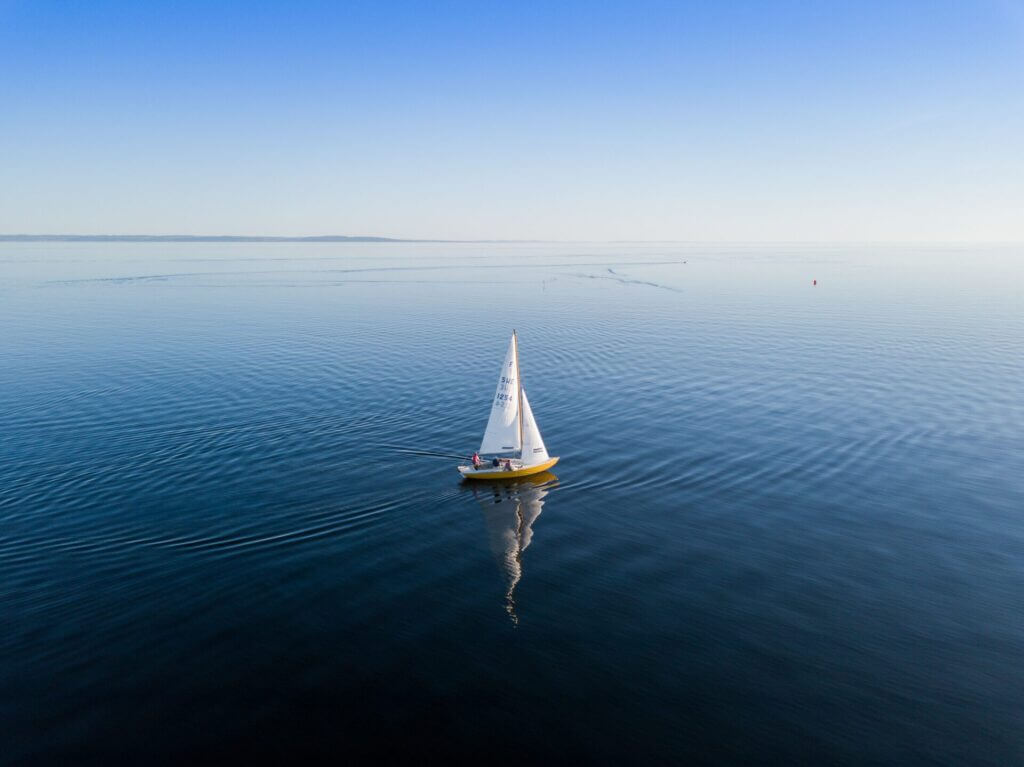
Sailing Terminology Conclusion
As we come to the end of our sailing terminology crash course, it’s important to remember that the world of sailing is vast and varied. Learning even the basics can be a daunting task, but with practice and perseverance, you’ll be able to hoist your sails and set a course for adventure.
Whether you’re a seasoned sailor or just starting out, understanding the terminology is crucial to ensure a safe and enjoyable voyage. From the parts of the boat to the knots and lines, each aspect plays a significant role in the overall sailing experience.
So, as you prepare to embark on your next sailing adventure, keep in mind the importance of safety, navigation, and proper etiquette on the water. And remember, when all else fails, just hoist the Jolly Roger and hope for the best! (Just kidding, don’t actually do that.) Happy sailing!
What is the difference between apparent wind and true wind?
Apparent wind is the wind felt by the sailor on the boat, while true wind is the wind direction and speed relative to the ground.
What are the points of sail?
The points of sail are the directions that a sailboat can travel in relation to the wind. They include upwind, close-hauled, beam reach, broad reach, and downwind.
What does it mean to be “on a reach”?
Being “on a reach” means sailing with the wind coming from the side of the boat, at a perpendicular angle to the boat’s direction.
What is tacking?
Tacking is the maneuver used to turn the boat’s bow through the wind, allowing the boat to change direction while still sailing upwind.
What is jibing?
Jibing is the maneuver used to turn the boat’s stern through the wind, allowing the boat to change direction while sailing downwind.
What is the difference between windward and leeward?
Windward is the side of the boat that is facing into the wind, while leeward is the side of the boat that is sheltered from the wind.
What is a boom vang?
A boom vang is a line used to control the position of the boom, which helps control the shape and position of the sail.
What is a cleat?
A cleat is a device used to secure a line to the boat, allowing the sailor to adjust the tension of the line without having to hold onto it constantly.
What is a winch?
A winch is a mechanical device used to control lines and adjust sails. It typically consists of a drum and handle that can be turned to wind or unwind a line.
Similar Posts

Mainsail Furling Systems – Which one is right for you?
With the variety of options of mainsail furling systems available, including slab, in-boom, and in-mast systems, it can be challenging to determine which one best suits your needs. In this comprehensive guide, we will explore the pros and cons of each system, enabling you to make an informed decision that aligns with your sailing requirements….

Anchoring Tips for Beginners
Are you ready to set sail on a journey to become anchoring aficionados? Anchoring a sailing yacht may seem like a simple task, but let me tell you, it’s no small feat. It requires a blend of nautical knowledge, careful planning, and a dash of luck (and a pinch of salt, if you ask any…
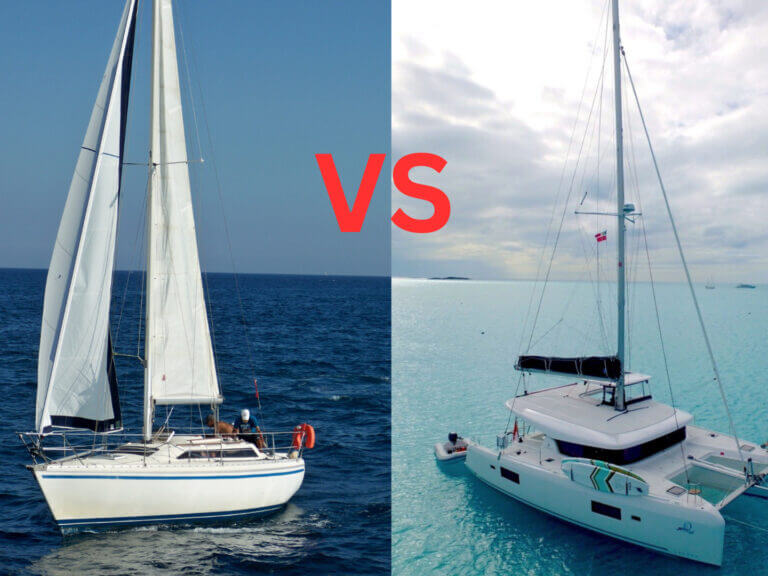
Monohulls vs. Catamarans: Which One is Best for You?
If you’re considering purchasing a sailboat, you might be wondering which type of vessel is best suited for your seafaring adventures. Fear not, for we’re here to help you weigh the differences between monohulls vs. catamarans to make an informed decision. Now, before we dive into the nitty-gritty details of hull design, sail handling, and…
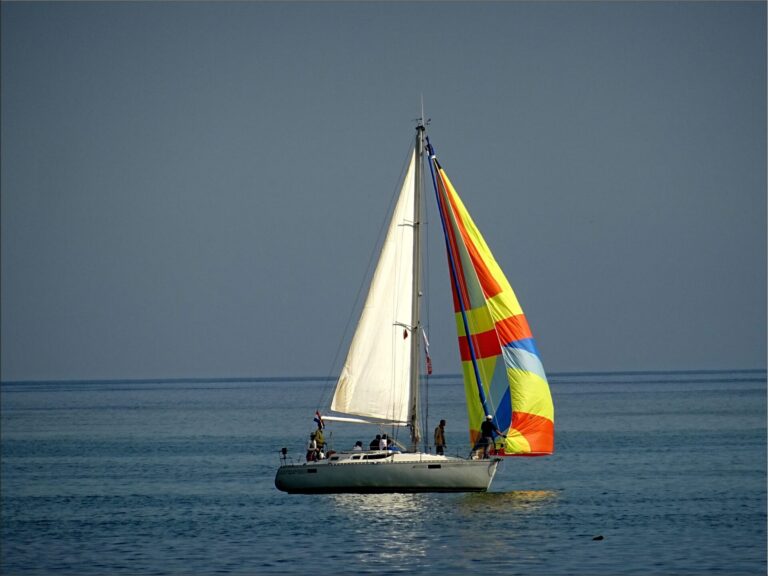
Types of Sails: A Comprehensive Guide
In the enchanting world of sailboat dynamics, where the dance between wind and water takes center stage, the significance of sails cannot be overstated. Like the wings of a bird, these meticulously crafted sails unfurl to catch the slightest whisper of breeze, converting it into a powerful forward thrust that carries us through the vast…
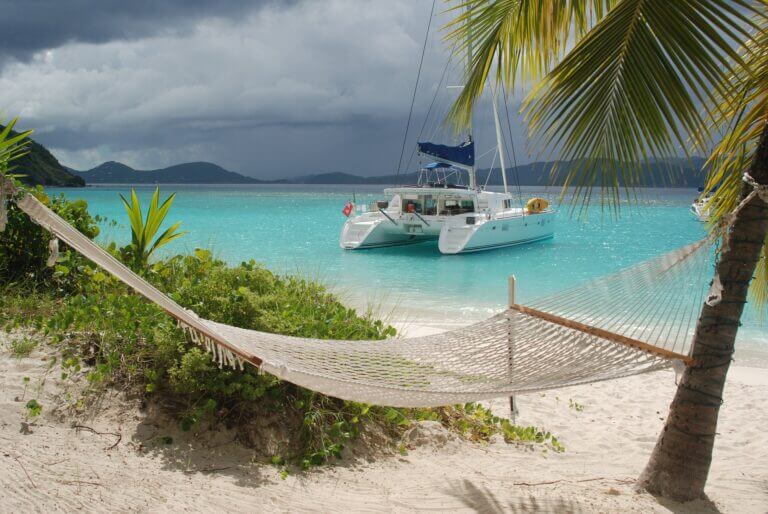
Advantages of Catamaran Sailboat Charter
A catamaran sailboat charter is an exciting way to explore the beauty of the sea. Whether you are an experienced sailor or a first-timer, booking a catamaran sailboat charter has a lot of advantages that you can enjoy. In this article, we will discuss the advantages of booking a catamaran sailboat charter, so that you…

How Does a Marine Toilet Work?
Have you ever wondered how a marine toilet works? If you’re planning to embark on a boating adventure or just curious about the mechanism of a marine toilet, this article is for you. Marine toilets work similarly to the ones on land with a bowl, a seat, and a flushing mechanism that uses water. However,…

Dwyer Mast & Rigging offers a wide range of parts and hardware commonly used on sailboat masts and booms including bails, chainplates and stemheads, cleats, clevis pins, connecting hardware and fasteners, eye straps and mast eyes, gooseneck assemblies, halyard organizer plates, mast steps and bases, hinges, spreaders, and more.

Stemhead - Small

Stemhead - Large

T Chainplate

SKU: DH7409
Chainplate Cover - 1/8" by 1.5" Slot

SKU: DH7408

SKU: DH7401
Chainplate Cover - 9/32" by 1-5/8" Slot

Chainplate Cover - 1/8" by 1" Slot

Rudder Stop

Gudgeon for Pintle w/ 3/8" pin

SKU: DH3890
Gudgeon - 4 hole

Gudgeon - 2 hole

SKU: DH394S
DH394S Pintle 1.75" Wide 3/8" Pin

SKU: DH394L
DH394L Pintle 1.75" Wide 3/8" Pin

SKU: DH393S
DH393S Pintle 1.25" Wide 3/8" Pin

SKU: DH393L
DH393L Pintle 1.25" Wide 3/8" Pin

SKU: DH391S
DH391S Pintle 3/4" Wide 5/16" Pin

SKU: DH391L
DH391L Pintle 3/4" Wide 5/16" Pin

SKU: DH390S
DH390S Pintle 1/2" Wide 5/16" Pin

SKU: DH390L
DH390L Pintle 1/2" Wide 5/16" Pin

Gooseneck fork

HD Gooseneck Universal - 3/4"

SKU: DH3160
Gooseneck Universal - 1"

Gooseneck Universal - 3/4"

SKU: DH418S20
Gooseneck Slide - 3/8" Groove to fit DM-20
Parts of a Sailboat
The allure of sailing lies in the harmonious dance between wind and water, propelling sailboats on mesmerizing voyages across the open seas. However, before one can hoist the sails and embark on a maritime journey, it is essential to understand the intricacies of a sailboat’s anatomy.
In this article, we will delve into the captivating world of sailboats, unravelling the essential parts that compose these graceful vessels, allowing them to gracefully navigate the vast expanse of the ocean.
From the towering mast that reaches for the heavens to the delicate rigging that weaves the sails into the wind’s embrace, each component plays a vital role in the enchanting symphony of sailing. Whether you are an aspiring sailor or a seasoned mariner, join us on this enlightening voyage as we uncover the secrets behind the anatomy of a sailboat.
Hull and Deck
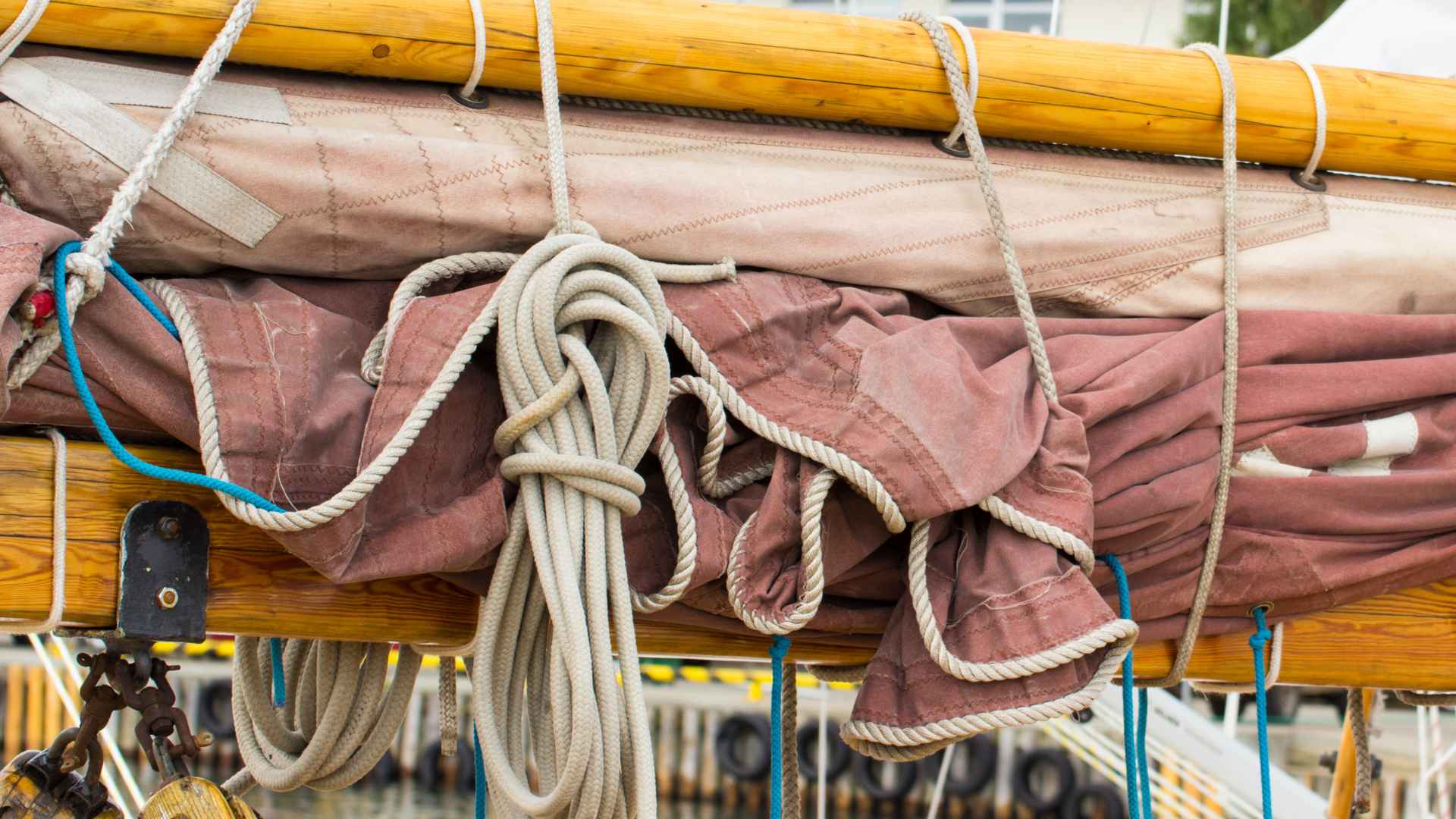
The hull of a sailboat is its foundational structure, serving as the backbone of the vessel. It is the part of the boat that interacts directly with the water, providing buoyancy and stability as it glides through the waves. Understanding the hull is essential for any sailing enthusiast, as it forms the basis of a sailboat’s design and performance.
The hull is typically made of a sturdy and watertight material, such as fiberglass, wood, aluminum, or even carbon fiber in high-performance racing boats. Its shape and design are carefully crafted to optimize the boat’s performance in different water conditions, ensuring a smooth and efficient sailing experience.
One of the primary functions of the hull is to provide buoyancy, allowing the boat to float on the water’s surface. It displaces water equal to its own weight, creating an upward force that keeps the boat afloat. This buoyancy is essential for the stability and safety of the sailboat.
Stability is another crucial aspect of the hull. Sailboats are designed to resist tipping over or capsizing, and the hull’s shape plays a significant role in achieving this stability. Sailboats can have either a monohull or a multihull design. Monohull sailboats have a single hull, while multihull sailboats, such as catamarans or trimarans, have two or more hulls. Each design has its advantages and characteristics, influencing the boat’s stability, speed, and comfort.
In addition to providing buoyancy and stability, the hull also houses various compartments and storage areas, including the cabin, where sailors can find shelter and accommodation during longer journeys. The deck, which is the upper surface of the hull, provides a platform for crew members to move around and perform various tasks while aboard the sailboat.
The hull and deck work together harmoniously to create a seaworthy vessel, capable of withstanding the forces of wind and waves. Whether you’re a seasoned sailor or a curious novice, understanding the importance of the hull is the first step toward unlocking the secrets of sailing and embracing the wonders of the open water.
What are the different hull types, such as monohull and catamaran, and their characteristics?
When it comes to sailboats, there are different hull types to choose from, each with its own unique characteristics and advantages. The two main types of sailboat hulls are monohull and catamaran. Let’s explore these hull types and their distinguishing features:
Monohull sailboats have a single hull, which is a single, continuous structure that runs from bow to stern. Monohulls are the most common type of sailboats and have been used for centuries. They offer several advantages:
- Versatility: Monohulls are versatile and well-suited for various sailing conditions, from calm coastal waters to rough offshore passages.
- Excellent upwind performance: Monohulls generally perform well when sailing upwind due to their ability to cut through the water and tack efficiently.
- Comfortable heeling: Monohulls have a natural tendency to heel, or lean to one side, which some sailors find enjoyable and exhilarating.
- Ample storage space: Monohulls often provide more interior space, including cabins, galleys, and storage compartments, making them suitable for longer journeys or living aboard.
Catamaran:
Catamarans have two hulls connected by a bridge or deck, creating a wide and stable platform. Catamarans have gained popularity in recent years, particularly for cruising and charter purposes. Here are some key characteristics:
- Stability: Catamarans offer exceptional stability, both at anchor and underway. The wider platform reduces heeling and provides a more comfortable experience, particularly for those prone to seasickness.
- Spaciousness: Catamarans generally have a larger interior living space, including multiple cabins, saloons, and outdoor areas. This extra space makes them popular for long-term cruising and leisure activities.
- Shallow draft: Catamarans have a shallower draft compared to monohulls, allowing them to navigate in shallower waters and access anchorages that may be inaccessible to deeper-draft boats.
- Speed potential: Due to their design and reduced drag, catamarans can achieve higher speeds, particularly reaching or running with the wind. This makes them popular among performance-oriented sailors.
Both monohulls and catamarans have their merits and are suitable for different sailing preferences and conditions. Ultimately, the choice between them depends on factors such as personal preferences, intended use (racing, cruising, chartering), and the specific requirements of your sailing adventures.
Whichever hull type you choose, the hull is the backbone of your sailboat, providing stability, buoyancy, and the foundation for an enjoyable and safe sailing experience.
What is the purpose and features of the deck?
The deck of a sailboat is the horizontal surface that covers the top of the hull. It serves several important purposes and is designed with various features to enhance functionality and safety. Let’s explore the purpose and key features of the deck:
- Cockpit: The cockpit is a designated area on the deck where the helmsperson controls the sailboat. It typically includes a steering wheel or tiller, compass, and various controls for sails, such as sheets and halyards. The cockpit provides a comfortable and secure space for the helmsperson to maneuver the boat and adjust while maintaining a clear view of the surroundings.
- Hatches: Hatches are openings on the deck that provide access to the interior compartments of the sailboat. They allow for ventilation, natural light, and access to storage areas, cabins, and engine compartments. Hatches are typically fitted with watertight seals to prevent water from entering the boat in rough seas or during heavy rain.
- Winches: Winches are mechanical devices mounted on the deck used to handle lines (ropes) on a sailboat. They provide mechanical advantage and make it easier to control and adjust the tension of the sails. Winches are commonly used for raising and trimming sails, adjusting the tension of halyards, and controlling the position of lines such as sheets and reefing lines.
- Cleats and Clutches: Cleats and clutches are deck fittings used to secure lines in place. Cleats are usually metal or plastic fixtures with two or more horns where lines can be wrapped or tied off to keep them secure. Clutches are cam-shaped devices that grip lines when engaged, allowing for easy adjustment and locking of lines without the need for tying knots.
- Toe Rails and Lifelines: Toe rails are raised ridges or rails running along the edge of the deck, primarily designed to provide foot support and prevent crew members from slipping overboard. Lifelines are horizontal safety lines that run along the perimeter of the deck, usually supported by stanchions. They serve as a barrier and help prevent crew members from falling off the boat.
Other deck features may include cleats, padeyes (attachment points for lines and hardware), handrails for stability, and various equipment for anchoring, such as anchor rollers and windlasses.
The deck is an essential component of a sailboat, providing a safe and functional platform for the crew. Its design and features are carefully considered to ensure comfort, control, and accessibility during sailing adventures.
Mast and Rigging

The mast is a fundamental component of a sailboat, serving as the vertical structure that supports the sails and plays a crucial role in the propulsion of the boat. Let’s delve into the characteristics and functions of the mast:
- Structure and Material: The mast is typically a tall, vertical spar made of materials such as aluminum, carbon fiber, or wood. It is designed to withstand the forces exerted by the wind on the sails and transfer them to the hull.
- Height and Length: The height and length of the mast can vary depending on the size and type of sailboat. Larger sailboats generally have taller masts to accommodate larger sail areas and provide more power and speed. Smaller sailboats, like dinghies or day sailors, have shorter masts.
- Step: The mast is stepped or secured at the bottom to the deck or keel of the sailboat. The step provides stability and ensures that the mast remains in an upright position.
- Spreaders: Spreaders are horizontal crossbars attached to the mast to prevent it from bending excessively under the pressure of the sails. They also help maintain the correct angle and shape of the shrouds (rigging wires that support the mast from the sides) and aid in distributing the forces evenly.
- Masthead and Headboard: The masthead is the topmost part of the mast, where various components, such as the sheaves for halyards (lines used to raise and lower sails) and the attachment point for the forestay (rigging wire that supports the front of the mast), are located. The headboard is a plate or fitting attached to the top of the mainsail, which slides into a track on the mast and helps secure the sail in position.
- Mast Tracks: Mast tracks are vertical grooves or slots running along the front of the mast. They allow the sails to be raised, lowered, and adjusted to different heights by means of halyards and sail slides.
The mast, along with its accompanying rigging, is an integral part of a sailboat’s propulsion system. It provides support for the sails, allowing them to capture the energy of the wind and transfer it into forward motion. The mast’s height, step, spreaders, and other components work together to ensure stability, proper sail shape, and efficient power transfer, contributing to the sailboat’s performance and maneuverability.
Let’s explore the various types of masts commonly found on sailboats:
Single-masted:.
- Single-masted rigs are the most common and versatile type of sailboat rigging. They feature a single mast that rises vertically from the deck.
- Single-masted rigs can support a variety of sail configurations, including a mainsail and one or more headsails (jibs or genoas).
- This rig is suitable for different types of sailboats, ranging from small day sailors to larger cruising and racing vessels.
Double-Masted:
- Double-masted rigs, also known as ketch or yawl rigs, consist of two masts: a main mast and a smaller mizzen mast located aft of the main mast.
- The mizzen mast is shorter than the main mast and is often positioned near the stern.
- Double-masted rigs provide additional sail area and flexibility in sail combinations, allowing for better balance and maneuverability.
- These rigs are commonly found on cruising sailboats and can handle a wide range of wind conditions.
Fractional Rigs:
- Fractional rigs are characterized by a mast that is shorter than the boat’s overall length.
- The mast is positioned further aft, and the forestay (rigging wire that supports the front of the mast) is attached at a point lower than the masthead.
- Fractional rigs offer increased control and versatility, making them popular on performance-oriented sailboats and racing yachts.
- They allow for easy adjustment of sail shape and balance, optimizing performance in different wind conditions.
Each type of rig offers its own advantages and characteristics. Single-masted rigs are versatile and suitable for various sailing applications. Double-masted rigs provide additional sail area and enhance maneuverability. Fractional rigs offer enhanced control and performance for competitive sailing. The choice of rig type depends on factors such as the boat’s size, intended use, and personal preferences of the sailor.
It’s important to note that there are additional rig variations beyond the ones mentioned here, including schooners, sloops, cutters, and more. Each rig type has its own unique features, and sailors often select the rig that best suits their sailing style, preferences, and the specific demands of their sailing adventures.
What are the key rigging components such as shrouds, stays, halyards, and sheets, and their functions?
Rigging refers to the network of wires, lines, and fittings that hold and control the sails on a sailboat. It plays a crucial role in maintaining the integrity of the mast and ensuring efficient sail handling. Let’s take a closer look at the components of rigging:
- Shrouds: Shrouds are thick stainless-steel wires or cables that extend from the mast to the sides of the boat. They provide lateral support and prevent excessive side-to-side movement of the mast. Shrouds help maintain the integrity and stability of the mast.
- Stays: Stays are like shrouds but are positioned fore and aft to control the forward and backward movement of the mast. The forestay is a forward-facing stay that connects the mast to the bow of the boat. Backstays, or backstay in the case of a single-masted rig, connect the top of the mast to the stern of the boat. Stays help counterbalance the forces exerted by the sails and provide additional support and stability to the mast.
- Halyards: Halyards are lines (ropes) used to raise and lower the sails. They are typically attached to the head (top) of the sails and run through pulleys or blocks. The main halyard is used to raise the mainsail, while jib halyards are used for headsails. Spinnaker halyards are used for spinnaker sails. By adjusting the tension of the halyards, sailors can control the position and shape of the sails.
- Sheets: Sheets are lines used to control the trim and shape of the sails. They are attached to the clew (lower aft corner) of the sails and run through blocks or winches. The mainsheet controls the mainsail, while jib sheets control the headsails. Spinnaker sheets are used for controlling spinnaker sails. By adjusting the tension and angle of the sheets, sailors can optimize the sail shape and adjust the power and efficiency of the sails.
- Blocks and Pulleys: Blocks and pulleys are essential components of the rigging system. They consist of one or more grooved wheels with a central axle. Lines are threaded through these wheels to change the direction and increase mechanical advantage when tensioning or releasing the rigging. Blocks and pulleys allow for smooth and efficient movement of the lines and reduce the effort required to control the sails.
These rigging components work together to hold and control the sails, allowing sailors to adjust their position, shape, and tension. By manipulating the shrouds, stays, halyards, and sheets, sailors can optimize the performance of their sailboat and adapt to changing wind conditions. Understanding and effectively using the rigging is crucial for safe and efficient sail handling.
Sails and Sail Controls
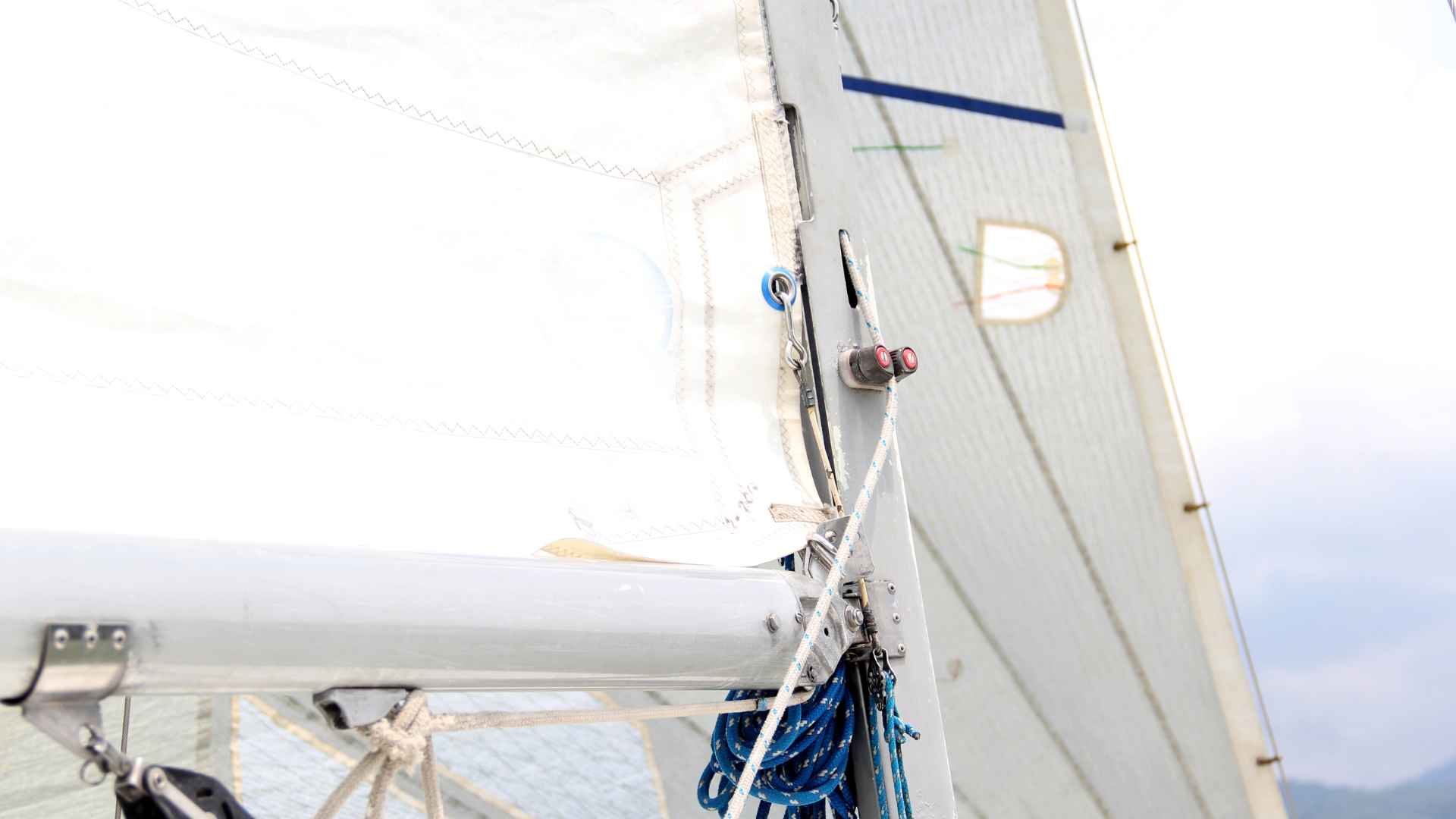
Sails, with their billowing canvas catching the wind, are the beating heart of a sailboat. They serve as the primary means of propulsion, transforming the invisible force of the wind into forward motion. The elegance and power of sails have allowed sailors to explore the world’s oceans for centuries, harnessing nature’s energy to embark on incredible journeys.
Sails come in various shapes and sizes, each designed to suit different sailing conditions and purposes. The mainsail is the largest and most significant sail, typically positioned behind the mast. It captures the wind from behind the boat and drives the vessel forward. Attached to the mast and boom, the mainsail can be adjusted to optimize its shape and angle to the wind, maximizing the boat’s speed and efficiency.
In addition to the mainsail, sailboats often have headsails, such as jibs or genoas, located near the bow of the boat. Headsails are smaller and more maneuverable than the mainsail, enhancing the sailboat’s performance and allowing it to sail closer to the wind. These sails are typically used in conjunction with the mainsail to provide additional power and control.
Specialty sails, such as spinnakers, are designed for specific sailing conditions and maneuvers. Spinnakers are large, colorful sails shaped like a balloon, which are used when sailing downwind or on a broad reach. They capture the wind from the front of the boat, significantly increasing the sail area and generating extra speed.
Sail controls play a vital role in managing the position, shape, and trim of the sails. Sail controls include various systems and mechanisms that allow sailors to adjust the sails to achieve optimal performance. These controls can include:
- Boom: The boom is a horizontal spar that extends aft from the mast and supports the foot (lower edge) of the mainsail. It helps control the shape and position of the sail.
- Traveler: The traveler is a movable track mounted on the deck or cockpit. It allows for lateral movement of the mainsheet and helps control the angle of the mainsail relative to the boat’s centerline.
- Cunningham: The cunningham is a control line attached to the luff (leading edge) of the mainsail. It allows sailors to tension the sail’s luff, flattening the sail and reducing its draft in stronger winds.
- Outhaul: The outhaul is a control line that adjusts the tension along the foot of the mainsail. By adjusting the outhaul, sailors can control the depth and shape of the sail.
- Reefing System: Reefing systems are used to reduce the area of the sails in strong winds. They allow sailors to partially lower or roll up the sails, reducing their overall size and power.
By skillfully adjusting these sail controls, sailors can optimize the shape, angle, and power of their sails, enabling them to sail efficiently, maintain control in varying wind conditions, and extract maximum speed from their sailboat.
Sails are not only functional but also beautiful, filling the horizon with their graceful forms. They capture the spirit of adventure, freedom, and the timeless allure of the sea. Understanding the intricacies of sails and their controls is essential for harnessing the wind’s power and unlocking the full potential of a sailboat’s performance.
Steering and Navigation
Steering a sailboat and navigating the waters require a combination of skill, knowledge, and the right equipment. Let’s explore the steering system, the role of the rudder, and the essential navigation instruments used on sailboats.
The steering system of a sailboat allows the helmsperson to control the direction of the boat. Depending on the boat’s design, you will find either a tiller or a wheel as the primary steering mechanism. The tiller is a long handle connected directly to the rudder, while the wheel is a circular device linked to a steering mechanism that transfers the movement to the rudder. By manipulating the tiller or turning the wheel, the helmsperson can steer the sailboat left or right, adjusting its course according to the wind and navigational needs.
The rudder, located beneath the waterline at the stern of the sailboat, plays a crucial role in maneuvering the boat. It is a vertical or horizontal fin-like structure that can be rotated from side to side. When the helmsperson steers the boat, the rudder responds, creating resistance against the water and redirecting the boat’s movement. By adjusting the angle of the rudder, the helmsperson can control the boat’s heading, making it possible to tack (change direction across the wind) or jibe (change direction with the wind from behind). The rudder is a fundamental component of sailboat control and is critical for maintaining stability and maneuverability.
In addition to steering, navigation instruments and equipment are essential for safe passage on the water. Here are a few key tools commonly found on sailboats:
- Compass: A compass is a navigational instrument that indicates the boat’s heading in relation to magnetic north. It provides a reliable reference point for maintaining a desired course and navigating with accuracy, even in the absence of electronic devices.
- GPS (Global Positioning System): GPS is a satellite-based navigation system that allows sailors to determine their precise location on the earth’s surface. GPS units on sailboats provide real-time positioning, speed, and course information, enhancing navigational accuracy and safety.
- Depth Sounder: A depth sounder, also known as a depth finder or echo sounder, measures the depth of the water beneath the sailboat. It helps sailors avoid shallow areas or underwater hazards, ensuring safe navigation.
- Charts: Nautical charts are maps specifically designed for navigation on the water. They provide important information about water depths, navigational aids, landmarks, and other details essential for planning and following a safe course. Charts are still a valuable tool, even with the advent of electronic navigation systems.
These are just a few examples of the many navigation instruments and equipment available to sailors. Depending on the complexity of the sailboat and the navigational requirements, additional tools such as radar, AIS ( Automatic Identification System ), wind instruments, and electronic chart plotters can also be found onboard.
Steering the sailboat and navigating the waters require a combination of traditional seamanship skills and modern technology. By mastering the steering system, understanding the role of the rudder, and utilizing navigation instruments effectively, sailors can confidently explore the seas, navigate challenging environments, and reach their destinations safely and efficiently.
Auxiliary Power and Safety Equipment
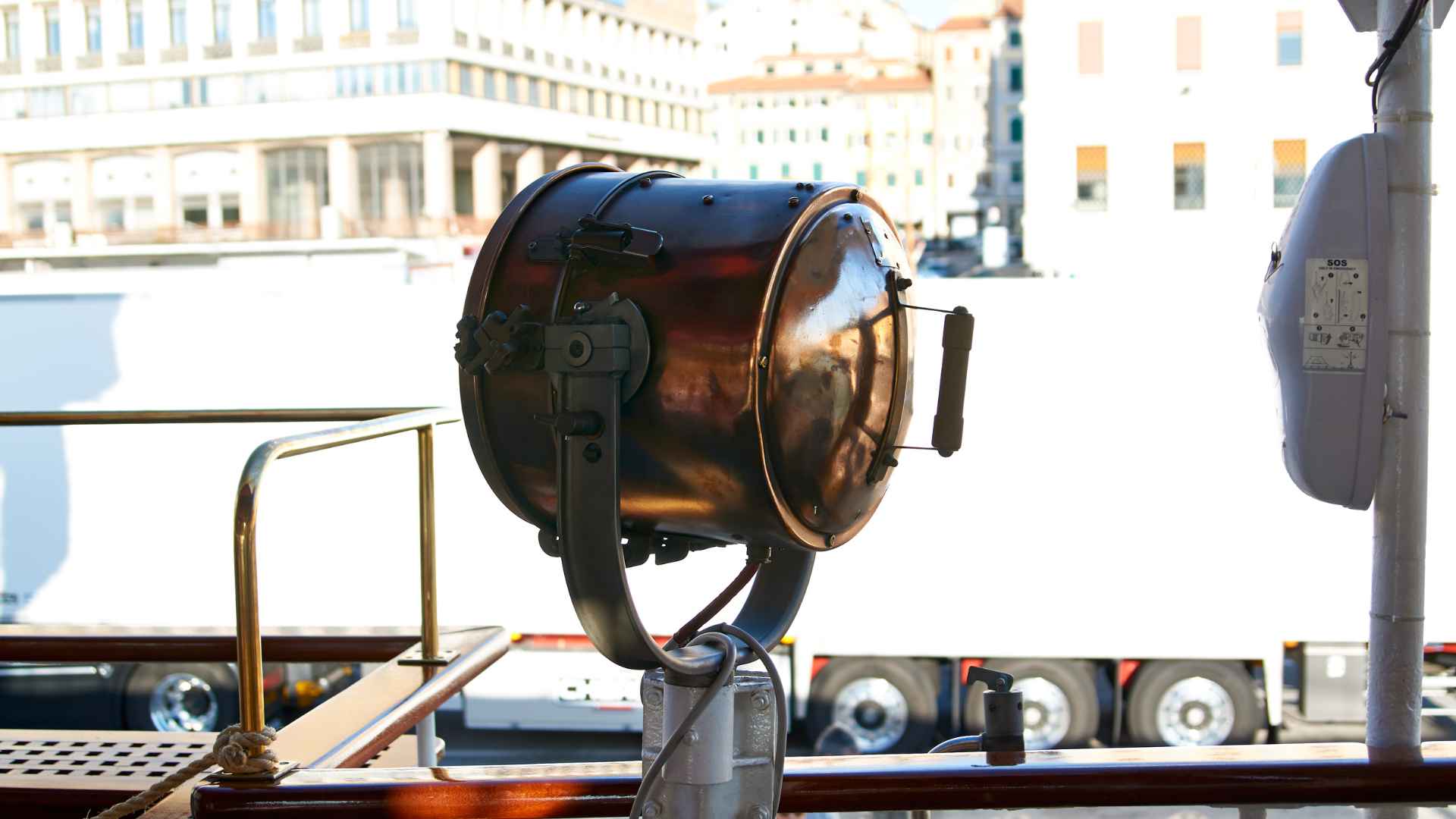
While sailboats primarily rely on the power of the wind to propel them, many sailboats are equipped with auxiliary power systems to provide additional maneuverability when needed. These auxiliary power systems typically consist of either an inboard or outboard engine.
An inboard engine is integrated into the hull of the sailboat and is positioned below deck. It offers advantages such as increased power, better fuel efficiency, and reduced noise compared to outboard engines. Inboard engines are typically larger and provide more torque, making them suitable for larger sailboats or those that frequently navigate in challenging conditions or against strong currents.
On the other hand, outboard engines are portable and mounted externally on the stern of the sailboat. They are versatile, lightweight, and easy to maintain. Outboard engines are popular among smaller sailboats or those that require occasional motorized propulsion.
The auxiliary power system, whether inboard or outboard, serves as a backup when wind conditions are light or during precise maneuvers in tight spaces, such as docking or maneuvering in crowded marinas. It provides sailors with increased control and helps ensure the safety of the vessel and its occupants in situations where sail power alone may be insufficient.
In addition to auxiliary power, ensuring the presence of proper safety equipment is crucial for any sailboat. Safety equipment helps to mitigate risks and ensure the well-being of everyone on board. Here are some essential safety items that should be present on a sailboat:
- Life jackets: Every person on board should have access to a properly fitting life jacket or personal flotation device (PFD). Life jackets are designed to keep individuals afloat and provide buoyancy in case of accidental falls overboard or emergencies.
- Fire extinguishers: Sailboats should be equipped with fire extinguishers suitable for extinguishing different types of fires. It’s important to have them readily accessible in case of a fire onboard.
- Distress signals: Distress signals, such as flares or electronic signaling devices, are crucial for attracting attention and signaling distress in emergency situations. These signals can aid in alerting nearby vessels or rescue services for assistance.
- Navigation lights: Sailboats must have properly functioning navigation lights, especially when operating during low visibility conditions or at night. Navigation lights allow other vessels to identify the sailboat’s position and determine the direction it is heading.
Complying with boating regulations regarding safety equipment is not only a legal requirement but also crucial for the well-being and security of everyone on board. It is essential to regularly inspect and maintain safety equipment to ensure it is in proper working condition and easily accessible in case of an emergency.
By understanding the role of auxiliary power systems and prioritizing the presence of essential safety equipment, sailors can navigate with confidence, knowing they have the necessary resources to handle various situations that may arise during their sailing adventures.
As we continue our journey through the anatomy of a sailboat, we uncover more elements that contribute to the joy and safety of sailing. Join us as we delve further into the intricacies of sailboat components and explore the secrets that make sailing a remarkable and secure experience.
Watch Parts of the boat and what they do | Video
Top 5 FAQs and answers related to What are the parts of a sailboat
What is the purpose of the mast on a sailboat .
The mast is the tall vertical structure on a sailboat that supports the sails. Its main purpose is to capture and harness the power of the wind, providing propulsion to the sailboat.
What are the different types of sails on a sailboat?
Sailboats have various types of sails, including the mainsail, headsail (jib/genoa), and specialty sails like spinnakers. The mainsail is the primary sail attached to the main mast, while the headsail is located at the front of the boat. Spinnakers are large, lightweight sails used for sailing downwind.
What are some important sail controls on a sailboat?
Sail controls play a crucial role in adjusting the shape and angle of the sails for optimal performance. Key sail controls include the boom, traveler, cunningham, outhaul, and reefing systems. The boom holds the foot of the mainsail, while the traveler allows sideways movement of the boom. The cunningham, outhaul, and reefing systems help control the tension and shape of the sails.
What is the purpose of the rudder on a sailboat?
The rudder is a vital component located beneath the waterline at the stern of the sailboat. Its primary purpose is to steer and maneuver the sailboat by redirecting the flow of water, allowing the helmsperson to control the direction of the boat.
What safety equipment should be on a sailboat?
Essential safety equipment on a sailboat includes life jackets or personal flotation devices (PFDs) for all passengers, fire extinguishers, distress signals such as flares or electronic signaling devices, and navigation lights. These items help ensure the safety of the crew and comply with boating regulations.
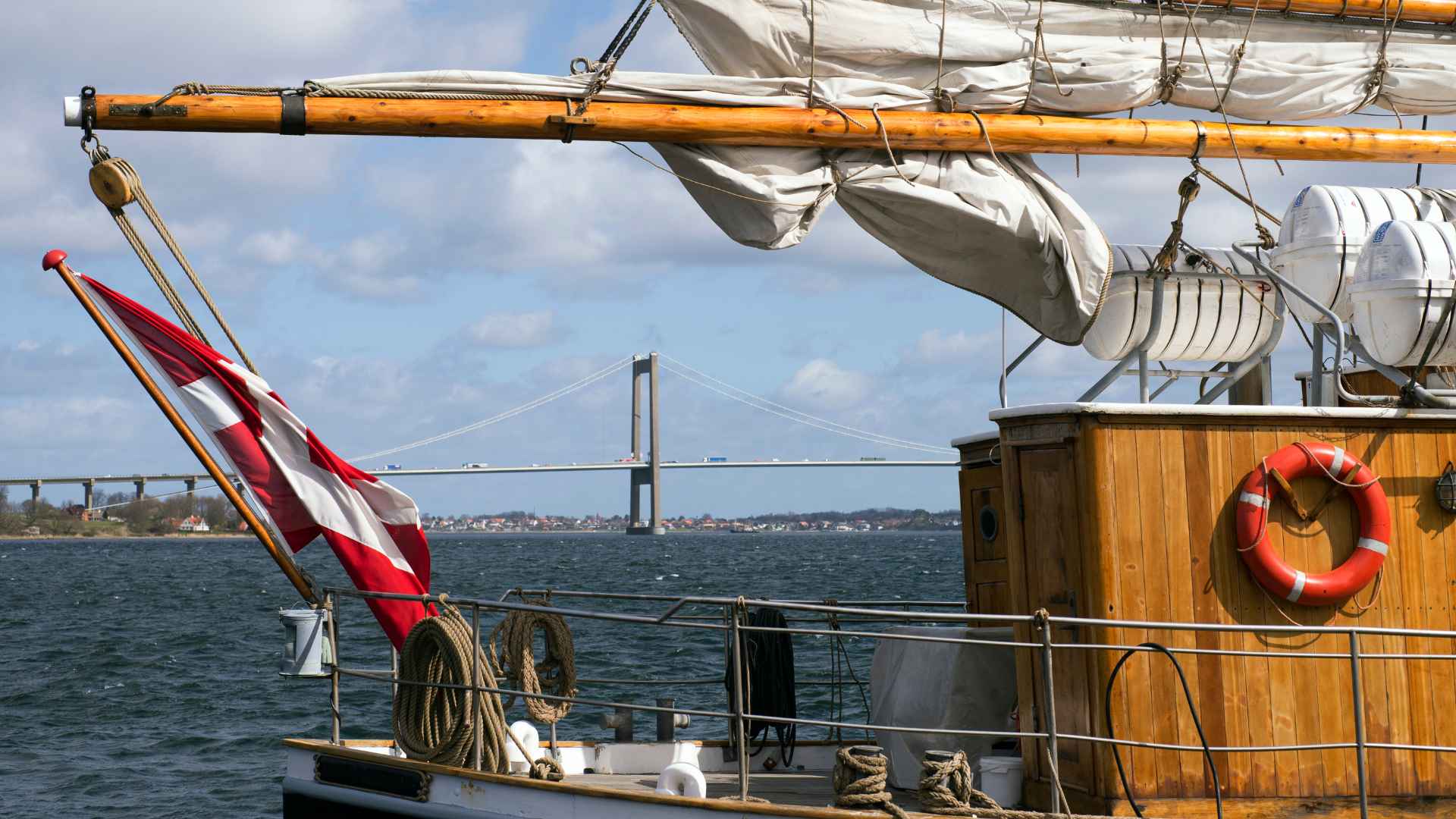
Understanding the various parts of a sailboat is fundamental to appreciating the art and science of sailing. From the sturdy hull and towering mast to the intricate rigging, sails, and navigation equipment, each component plays a vital role in the operation and performance of a sailboat.
We have explored the different types of hulls, the significance of the mast and rigging, and the versatility of sails and sail controls. We have also touched upon the importance of steering systems, the role of the rudder, and the essential safety equipment necessary for a safe and enjoyable sailing experience.
By recognizing the interconnectedness of these parts, we gain a deeper appreciation for the synergy between wind, water, and the intricate machinery of a sailboat. The thrill of harnessing the wind and propelling a vessel through the water becomes all the more captivating.
Whether you aspire to be a sailor, are already familiar with sailboats, or simply have a curiosity for the sea, there is always more to learn and discover. Dive into the world of sailing, explore the intricacies of sailboat design, and embrace the countless adventures that await on the open water.
So, hoist your sails, trim your sheets, and set a course for a lifetime of discovery. Let the wind guide you as you embark on your own sailing journey, where the beauty of nature and the art of sailing unite in a symphony of motion and tranquility.
Share What Are the Parts of a Sailboat and What They Do? Guide with your friends and Leave a comment below with your thoughts.
Read Is Boat Insurance Required in Michigan: Boat Owners Guide until we meet in the next article.
Similar Posts

How Much Is a Used Pontoon Boat?
Ah, the allure of cruising on a pontoon boat – basking in the sun, enjoying refreshing dips in the water, and creating memories with family and friends. But before you set your sights on a specific model, it’s crucial to consider the cost. Unlike shiny new boats, the world of used pontoon boats offers a…

Best Boating Sunglasses: Guide to Choose
Sun, spray, and endless horizons – boating offers a unique combination of relaxation and adventure. But that sunshine can be a double-edged sword. Glistening water creates blinding glare, reducing visibility and making navigating treacherous. To truly enjoy your time on the water, a good pair of boating sunglasses is essential. This guide will help you…

7 Affordable Boating Destinations to Explore: Adventures
Boating is often perceived as a luxury activity, reserved for the wealthy or seasoned sailors. However, with careful planning and a bit of research, anyone can enjoy the thrill of exploring new waters without breaking the bank. Whether you’re looking for serene lakes, vibrant coastal areas, or hidden riverways, there are plenty of affordable boating…

8 Factors to Consider When Choosing an Anchor for Boat
Picture this: you’re on your boat, the wind gently caressing the water’s surface, the sun painting a mesmerizing canvas across the horizon. In this idyllic scene, there’s one unsung hero that stands between you and the unpredictable currents beneath – your boat’s anchor. Anchors are more than just utilitarian devices; they’re the silent guardians of…

Throttle Cable Adjustment Screw in Boats
In the world of boating, the art of control is paramount. The ability to navigate waterways smoothly, efficiently, and safely hinges on the mastery of throttle control. Central to this control is the often-overlooked but essential component—the throttle cable adjustment screw. This article delves deep into the heart of boat operation, unraveling the mysteries of…

Midwest Boat Brokerage: Setting Sail on the Right Course
The vast network of lakes, rivers, and waterways snaking across the Midwest makes it a haven for boaters. Whether you’re a seasoned captain navigating the mighty Mississippi or a weekend warrior exploring the hidden coves of Lake of the Ozarks, finding the perfect vessel is key to unlocking countless aquatic adventures. This is where Midwest…

Sailboat Mast: Everything You Need To Know
Anyone who loves sails and boating needs to know their sailing boat from the inside out. If you are new to the sport, then you are probably wondering about things like a sailboat mast and everything around it.
In this article, we have everything you need to know about a sailboat mast, like what it is, its different types, as well as the material it is made of.
All you have to do is keep reading below to find it all out!
What Is A Sailboat Mast?
A sailboat mast is a tall pole that is attached to the deck. It helps secure the sail’s length to the boat and upholds the sail’s structure.
A sailboat mast is the most defining characteristic of a sailboat, helping keep the sail in place. What’s amazing about it is that it can even be taller than the vessel’s length!
Although conventional sailboats use wood, the majority of the newer sailboat masts are constructed of aluminum. The kind of sailboat mast a vessel has depends on the kind of sail plan supported.
What Are The Parts Of A Sailboat Mast?
The sailing mast is essentially a pole that cannot operate effectively without certain critical components.
Moving from the deck to the rest of the sailboat, we can first see the mast boot, which prevents the water from draining down the mast and flooding the cabin.
The stays are the long cords hooked up on each side of the mast, and they hold the mast up off the ground under massive force.
A gooseneck pipe fitting joins the boom to the mast. The sail is raised and lowered using halyard lines that go to the mast’s highest point.
Types Of Sailboat Masts
Rigs with one mast.
Many people that are not aware of the modern sailboat design envision single-mast sailboats.
The reason why this type of sailboat is so widely known is that these masts are low-cost to construct and fairly simple to operate alone.
Sloops, cutters, and catboats are among the most popular rigs with only one mast.
Sloop Masts
Nowadays, sloop rig vessels are the most popular type of sailing boat. Sloops typically have only one mast positioned somewhere on the front third or the middle of the deck, even though some boat models might vary a bit.
A sloop mast is equipped with a big mainsail and a jib sail (see also ‘ Why Are Sails Made In A Triangular Shape? ‘). A Bermuda-rigged sloop has only one towering mast and a triangle-shaped sail. Other not-so-popular gaff-rigged sloops have a significantly smaller mast and bigger 4-point mainsails.
Catboat Masts
Catboats are distinctive New England boats that have a forward-mounted standard mast and a long boom. A catboat, unlike a sloop-rigged boat, is only equipped with one sail.
It is also typically mounted (more or less) right in front of the boat, and it is commonly short and relatively thick.
Catboats are frequently gaff-rigged. In a single-mast design, gaff-rigged sail designs (see also ‘ The Definition And History Of The Lateen (Triangular) Sail ‘) succeed in making the most out of short masts and are relatively simple to maneuver.
The mast of gaff-rigged catboats is shorter than that of a Bermuda-rigged boat of comparable size, but it is typically taller than that of comparable gaff-rigged crafts.
Cutter Mast
A cutter-rigged sailboat has only one towering mast and several headsails, which is why it can be mistaken for sloops when seen from afar.
However, because cutters use numerous headsails rather than one standard jib (see also ‘ Everything You Need To Know About Sailboat Jibs ‘), their masts are typically taller than those of comparable-sized sloops.
In several places, a gaff-rigged cutter is far more usual than a gaff-rigged sloop. Even at times when its sails are folded, a cutter can be distinguished from a sloop.
This is due to the fact that cutters frequently have a protracted bowsprit and two front stays; the forestay and the jib stay.
Rigs With Multiple Masts
Multi-mast sailboats (see also ‘ Small Sailboats: What Are They Called? ‘) are not as popular as single-mast sailboats. That is why the design and structure of a multi-mast boat usually make it classier and more navigable.
A multi-mast boat provides more than simply great looks. It also provides speed and efficient control for skilled seamen.
Most of these boats have two masts, which seem to be frequently smaller than the masts on comparable-sized single-mast crafts. Yawl, ketch, as well as schooner rigs, are among the most popular types.
Yawls are sturdy multi-mast boats whose length ranges from 20 to more than 50 ft. A yawl has a lengthy forward main mast and a small mizzen mast at the back of the vessel. This type is also frequently gaff-rigged and was previously used as a utility boat.
A yawl-rigged boat can also self-steer by using the mizzen mast and sail. The yawl can be distinguished from many other double-mast vessels by its short mizzen mast, which is frequently half the size of the main mast.
Furthermore, the mizzen mast is located toward the back of the rudder post.
Ketch Masts
Ketch masts can be mistaken for yawls with a quick look. However, ketch masts are equipped with two masts of comparable size and a significantly bigger mizzen mast. A ketch boat’s mizzen mast is located at the front of the rudder post.
Ketch-rigged vessels are frequently gaff-rigged, with topsails on each one of their masts. Triangle-shaped sailplanes on some ketch-rigged vessels prevent the necessity for a topsail.
Ketch masts, much like the yawl ones, have a headsail, a mainsail, and a mizzen sail that are similar in size to the mainsail. Finally, a ketch-rigged vessel can sail while handling more than one rear sail.
Schooner Masts
Schooners are some of the most beautiful multi-mast sailboats. They are clearly more similar to ketches than yawls. However, if you closely look at a schooner, you will see that it will feature a smaller foremast and a longer (or nearly equal-sized) mast behind it.
Schooner masts are large and heavy, but they are generally shorter than single-mast vessels of comparable size.
This is due to the fact that double-masted vessels share the sail plan over 2 masts and do not require the additional length to compensate for the reduced sail space.
Finally, they are typically gaff-rigged, with topsails and topmasts that expand the mast’s length.
Masts Of Tall Ships
Tall ships are those traditional large cruising ships that ruled the seas well before age of steam. Renowned ships with this massive and intricate rig setup include the U.S.S Constitution as well as the H.M.S. Victory.
Tall ships have 3 or more massive masts that are frequently constructed using big tree trunks. Tall ships with 5 or more masts are quite common too.
Tall ships typically are as long as 100 feet or more, since the size and sophistication of these square-rigged vessels render them only useful at scale.
Tall ships have main masts, foremasts, mizzen masts, and gaff-rigged jigger masts at the back of their mizzen masts.
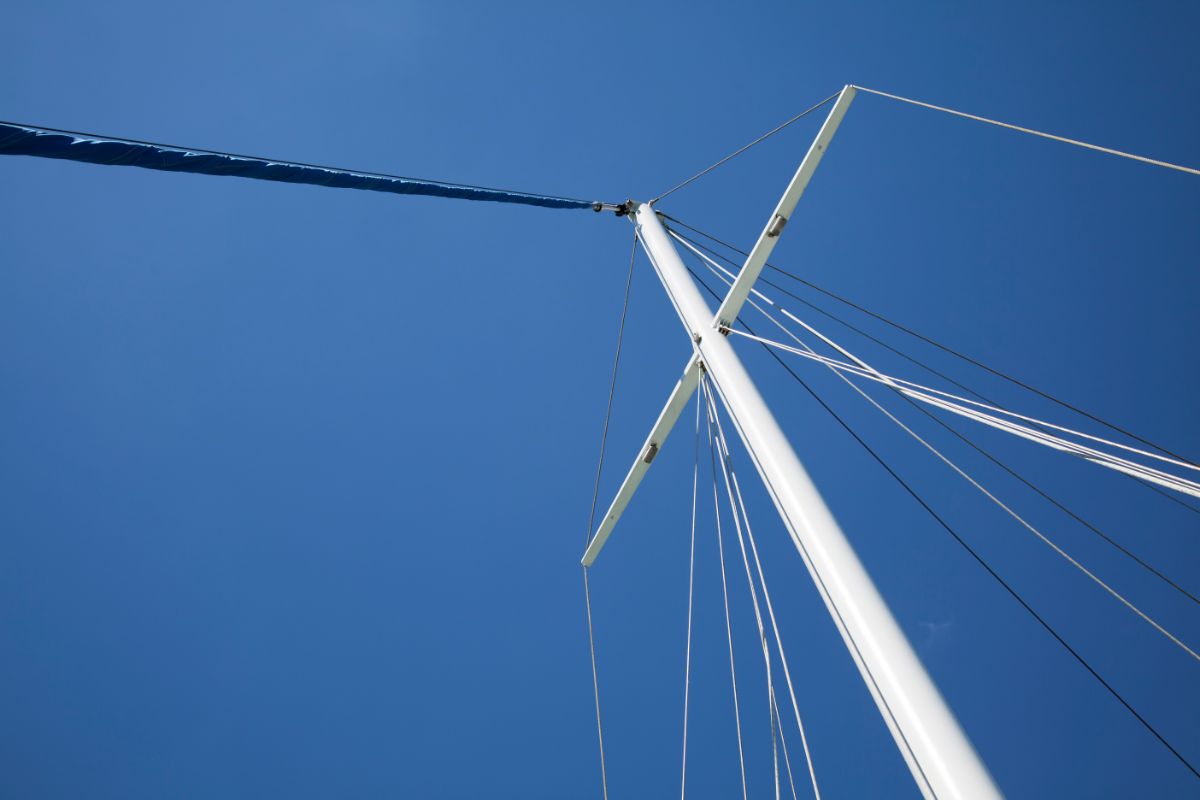
Mast Materials For Sailboats
The masts of sailboats (see also ‘ Two-Mast Sailboat Types ‘) are typically constructed of aluminum or other specific types of wood. Until the 1950s, almost all sailboat masts were constructed of wood.
That began changing around the time that fiberglass vessels rose to fame, with aluminum being now the most used mast material.
Aluminum Masts For Sailboats
Aluminum has become the most popular modern mast material. Aluminum masts are lighter in weight, hollow, and simple to produce. Such reasonably priced masts efficiently withstand seawater. These masts are also heavy for their size.
If there is one drawback to this type of mast that would be galvanic corrosion, which happens extremely quickly once seawater is in contact with aluminum and another metal, like steel and copper.
So, in types like the Bermuda-rigged sloop which are frequently made with aluminum, that is an issue.
Wooden Masts For Sailboats
The typical material for sailboat masts is wood, which is still employed for many specially designed boats nowadays.
Wood masts are big and bulky, yet very sturdy, and proper maintenance can guarantee their lengthy (over 100 years!) lifespan. They are also prevalent on gaff-rigged vessels because wood is best suited for short masts.
The Fir family provides the most popular mast wood. Although Douglas Fir is widely used, regional models (such as British, Columbian, and Yellow Fir) are also ideal.
Several sailboats, especially the tall ships, have masts made of pine and sometimes redwood. Other cedar species like the Port Orford or the Oregon cedar, can also be used for masts and spars.
Carbon Fiber Masts For Sailboats
Carbon fiber masts are a relatively new addition to the boatbuilding industry, and they have a few perks over the wood and aluminum ones.
First of all, carbon fiber is both strong and light, making it perfect for sailboats designed for races and which typically have tall masts. The best top-quality carbon fiber masts in the business are used by ships competing in America’s Cup races.
Maintenance Of Masts
It is critical to maintaining the sailboat masts and all of their associated hardware. Masts’ stays, lines, and halyards must be regularly checked, modified, and replaced on a regular basis. Masts made of wood must be lacquered and inspected for rot.
Masts made of aluminum do not typically require regular checks and maintenance, but any indications of a corrosive environment should be acted upon right away.
Build a clear maintenance schedule with your regional boat repairman or boating specialist. Keep in mind that preventative maintenance is always less expensive and simpler than repair work.
Choosing The Right Mast
For those who own a production boat, the options will be determined by the model and manufacturer.
The important factors to keep in mind for one-off boats without a designer sail plan are:
- the masts step’s features
- the length and displacement of the boat
- the addition of backstays and running backstays
- the quantity and placement of chainplates
If the mast is on a step on deck rather than on the structural beam, an image of the step may be useful to the mast maker.
For those who frequently take part in races, a carbon mast will save them from the extra weight and enhance their performance.
The Bottom Line
We hope that this article was helpful in learning more about a sailboat mast, the different types of mast you can see on vessels, as well as the materials they are made of, and their maintenance requirements.
Masts play a vital role in holding the boats in place, allowing people to keep on sailing to their dream destination, and they are also an eye-catching element of sailboats thanks to their vertical form and their length that often surpasses that of the sailboat itself.
Depending on the use of the boat, you will get a different type of mast, and the material it will be made of, its size, height, and weight, will guarantee the best sailing experience!
Related Posts:

Parts of a Sailing Boat - Basic Sailing Theory
We use technical and analytical cookies to ensure that we give you the best experience on our website.
Parts of a Sailing Boat
The names of different parts of the inside and outside of a sailing boat
Knowing the parts of a sailing boat is essential to sailing with other crew, it allows communications and instructions to be passed around and understood with confidence.
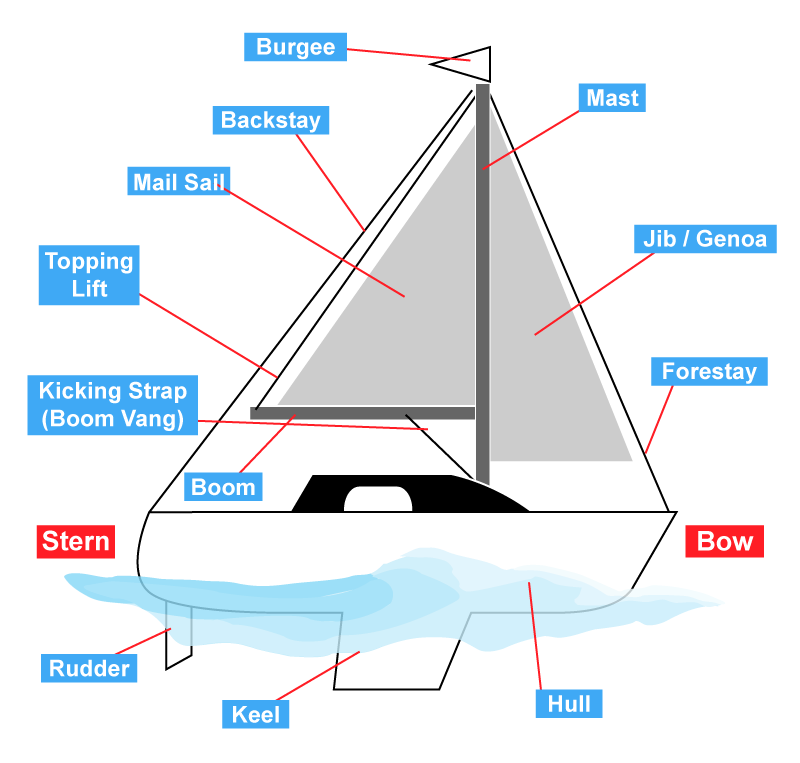
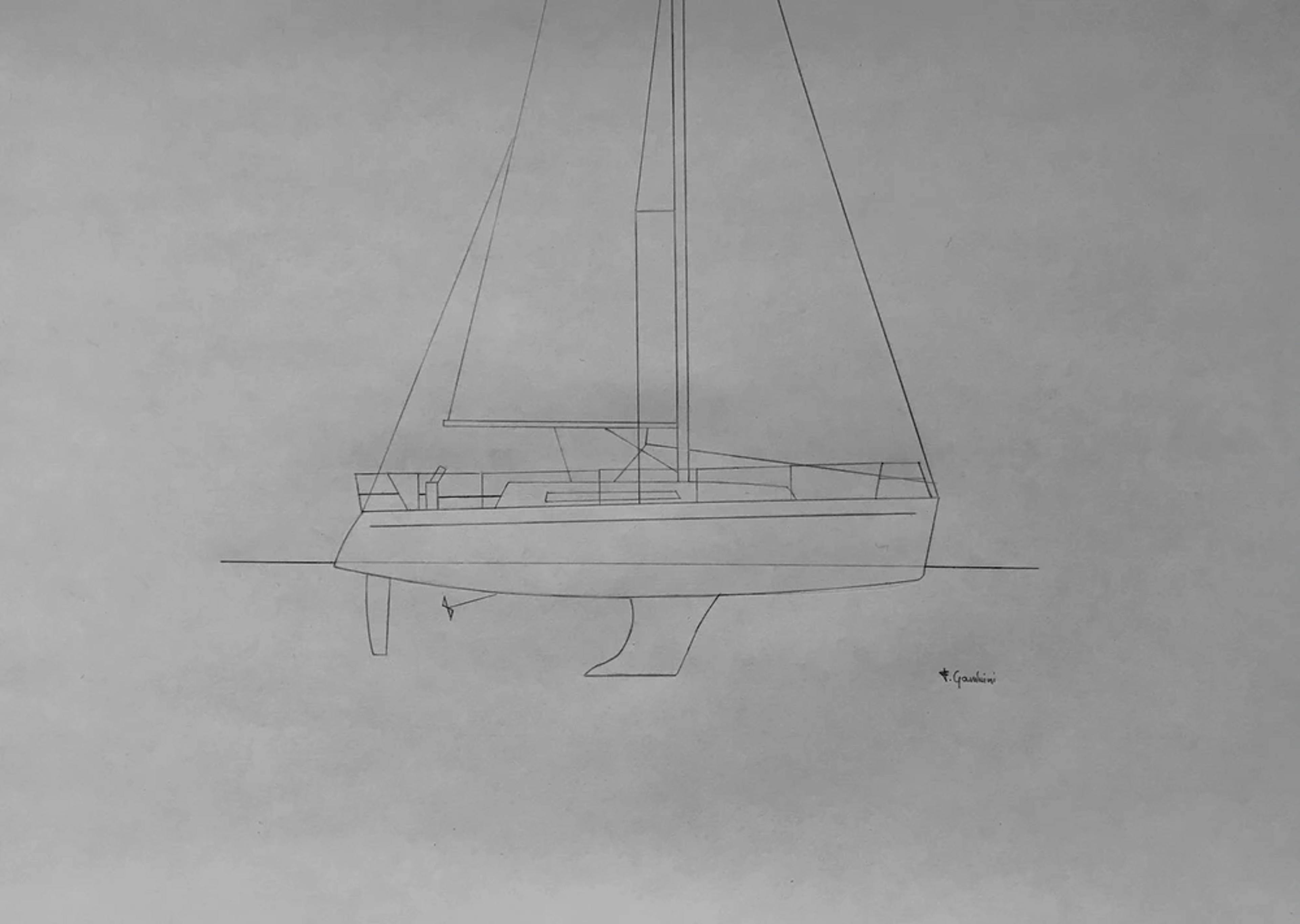
- Parts of a sailing boat: What's their use and can you locate them onboard?
From the bow to the stern
A sailing holiday is a holiday at sea... with a vitamin boost!
In fact, a sailing boat (I'm talking about a sailing boat, but what I've said is also valid for catamarans). Even if the size can feel relatively small, sailing boats hide lots of well-thought and organized spaces, each with its own peculiarities that we will discover during our holiday.
We will (soon) realize that some places are perfect for certain activities, while in others we will enjoy other moments of the day.
The sailing boat is a privileged point of view for a holiday at sea because it allows us to experience the sea... from the sea! This is no small detail...
Yacht charter: book your sailing holiday with us!
Let's start with the basics: what are the parts of a sailing boat .
A sailboat has a tapered shape. The front part is called the bow, whilst the back part is the stern.
Sailboats of the type we will be referring to here are called cabin boats because they have a living space inside the hull - namely, the cabin. Another aspect that identifies cabin boats is the keel's presence: a heavy ballast that ensures that it cannot tip over under any conditions. A cabin boat is clearly divided into an upper and lower section.
Above and below what? Above and below deck. The deck, otherwise known as the bridge, is the boat's outer surface, the one we walk on when we are outside. If we want to compare this space to your home, above you'll find the living area, and below, you'll have the sleeping area. It is above that we will spend most of our day on holiday, including meals.
The exterior and the cockpit
The external area is divided into three or four parts: Starting from the stern (we generally enter the boat from the rear, so this is in a sense our front door), we have the cockpit, which is the heart of the boat, this is where we will live most of our day, especially in summer. Bounded at the stern by the little beach and at the bow by the hatch, the opening that allows you to go below deck, the cockpit is a kind of living room of 4/6 square meters.
The cockpit, bordered by benches with soft cushions, features a helm wheel with all the nautical instruments and a superbly equipped table with lights, cup holders, and storage space for drinks and snacks.
You'll also find everything you might need to have at hand while sailing (sunglasses, hats, sun cream). The cockpit is naturally sheltered by the protected position, partially inserted inside the hull. The awning, also known as the bimini, shelters the cockpit from the sun (and rain). The canopy, also known as the sprayhood, shelters it from wind and water splashes. There is a central area in the middle of the boat with two walkways at the sides, mainly occupied by sail rigging but perfect for sunbathing as it is flat and a triangular area in the bow.
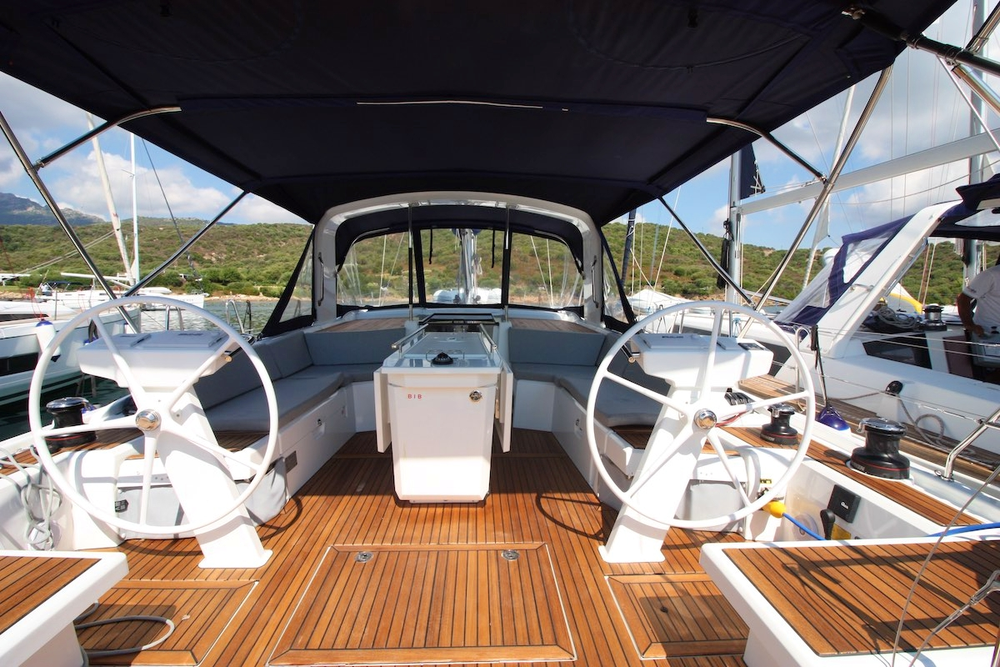
Exterior and the cockpit of a Beneteau Oceanis 46.1
Interior and dinette
After getting off, we will have the dinette, a sort of multifunctional living area with a small but well-equipped kitchen (two gas burners, two sinks, fresh and seawater at will, an under-sink fridge with a mini freezer).
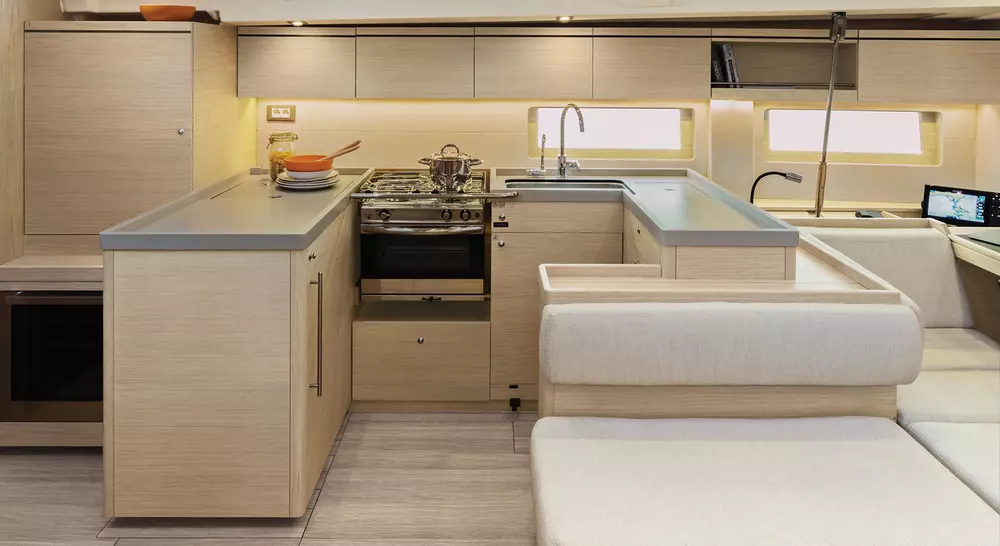
Interior and dinette of a Beneteau Oceanis 51.1
As in every house in every dinette, there is a table and chairs. Often the table is foldable to obtain two additional beds for friends passing through. On modern boats, this area, once the skipper's kingdom, is increasingly becoming the boat's technological heart, from all the monitoring takes place: the position of the boat, the battery charge, the water and fuel level, the switching on of all on-board equipment. For us, it's also where we charge our mobile phones.
This space is overlooked by the cabins and one or more bathrooms, small but very functional, in some cases with a separate shower. A sailboat, as the name implies, is characterised by the presence of sails. Sails are kept in position by the mast, which is made of aluminium. The mast is supported by strong steel cables: the one by the bow is called the forestay (to which the sail is wrapped around to form a soft sausage). The one at the stern, the forestay, often splits to facilitate boarding.
It is also excellent support for not one but two points of support.
On the right and left sides, the mast, which can be more than 15 metres high and is subjected to considerable strain, is supported by shrouds, one or more on each side, which reach right up to the outer side of the boat and are perfect for supporting it as it passes from stern to bow. In this article, I would like to point out two parts of the boat that I am sure you will appreciate to the fullest on your next sailing holiday. The first is the calling card of every holiday sailing boat, the stern platform, which can often be folded down. It is a platform on the surface of the water almost as wide as the boat itself, and its depth varies. Still, it is always enough to get in and out of the water and do all your favourite activities: yoga, diving, a snack, a nice shower or simply enjoy the moment with your feet underwater...
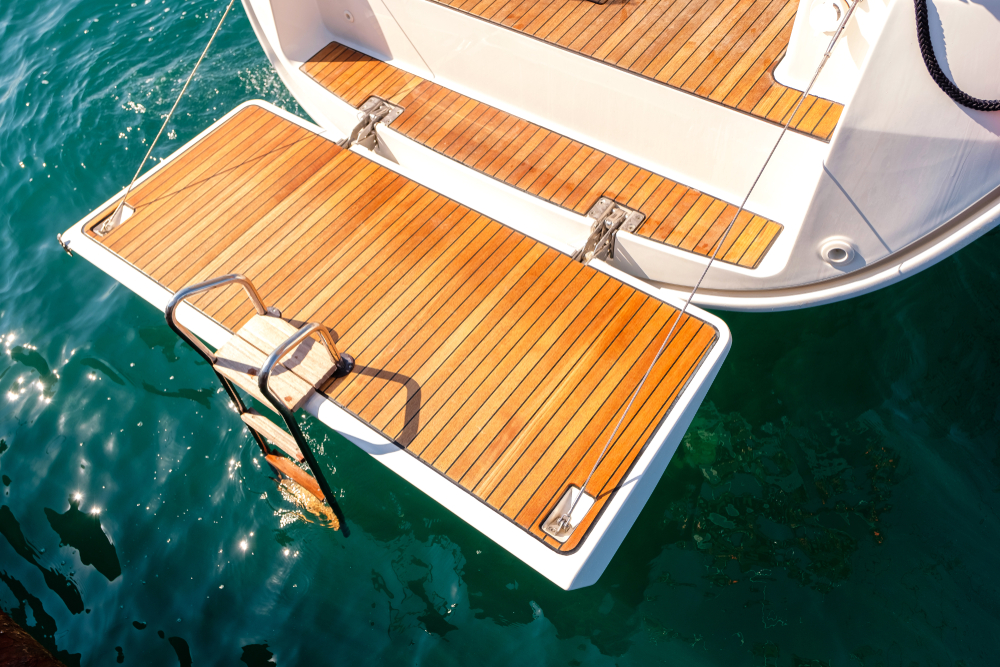
Deck of the sailing yacht from above
This delightful little balcony overlooking the sea also allows easy access on board in all conditions. The second is the bow of the boat itself, where the anchor winch is located. This area is often enhanced by a seat where we can sit back and watch the landscape change, "it's something I really like to do, especially on long motorboats," says Caterina, who has just returned from the Cyclades.
Yacht charter: book your sailing holiday with Sailogy
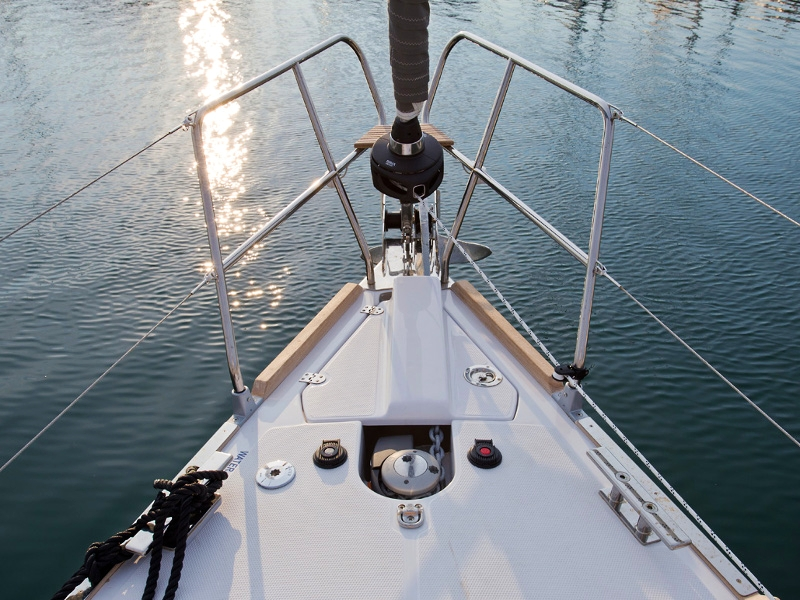
Elan Impression 45
Keep in mind while you're comfortably sitting on the bow and enjoying the scenery, not to end up in the water. You don't need to hold on with your hands. A good way is to put your legs on opposite sides of a candlestick.
A candlestick?!
Our boat is surrounded by a sort of safety railing: Let's see what it looks like: First of all, it is made up of rigid parts consisting of sturdy steel tube railings generally present at the bow and stern (pulpit) and flexible parts consisting of a set of vertical steel tubes firmly fixed to the deck of the boat (the stanchions) joined together by horizontal stainless steel cables (the dragnets).
A fine-meshed safety net can often be attached to these, which is advisable if there are children on board. What about you? What are your favourite parts of the boat?
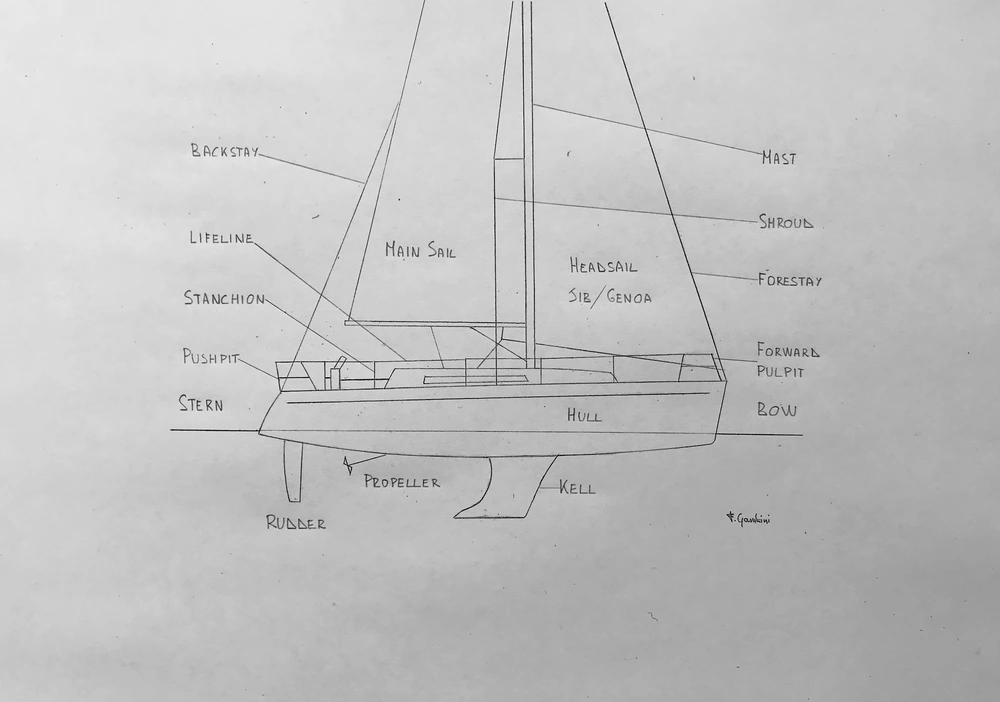
Discover our favorite yachts
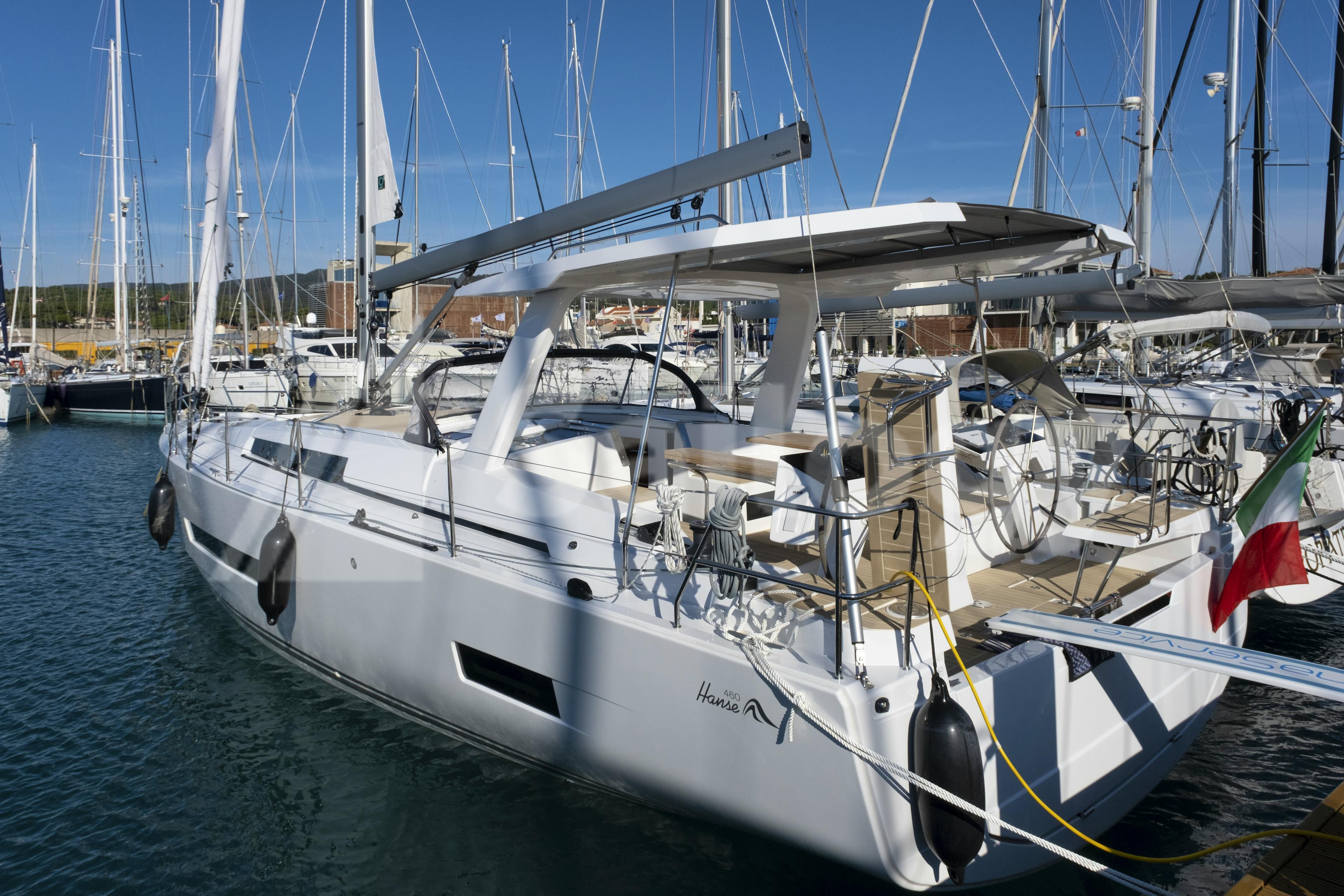
- Sailing boat
Castiglioncello, Tuscany
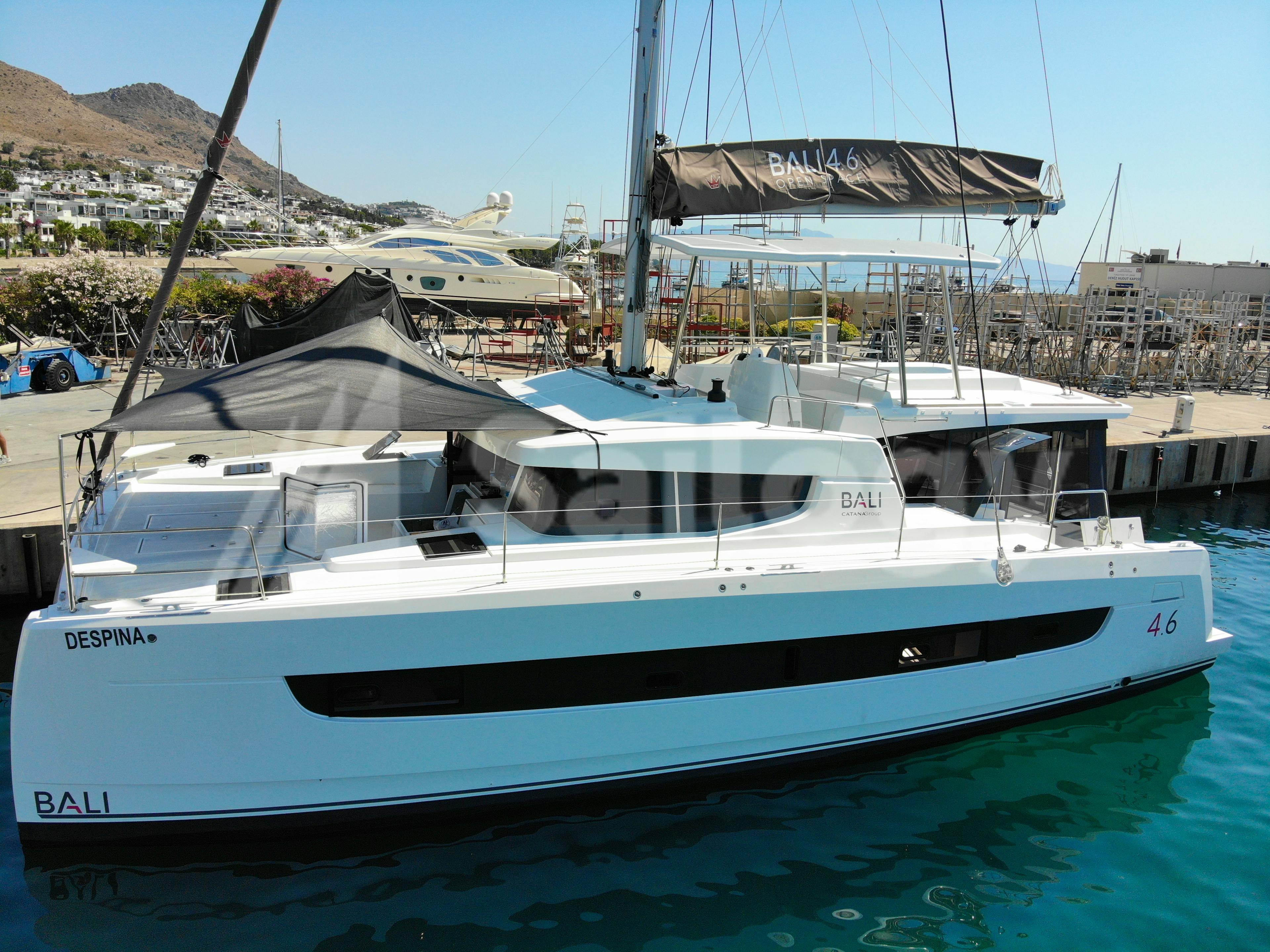
Gocek, Turkish Coast
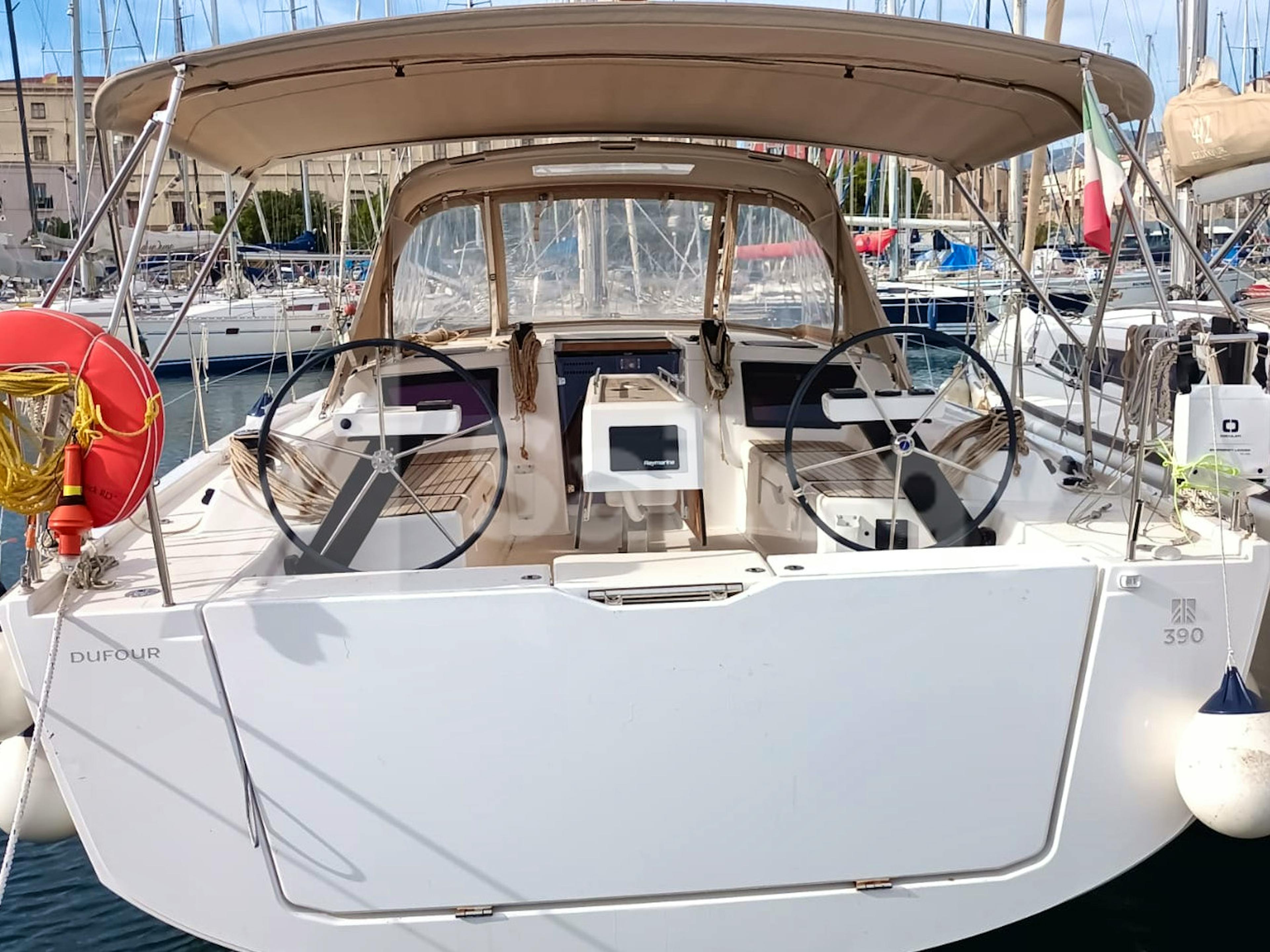
Dufour 390 Grand Large
Palermo, sicily.
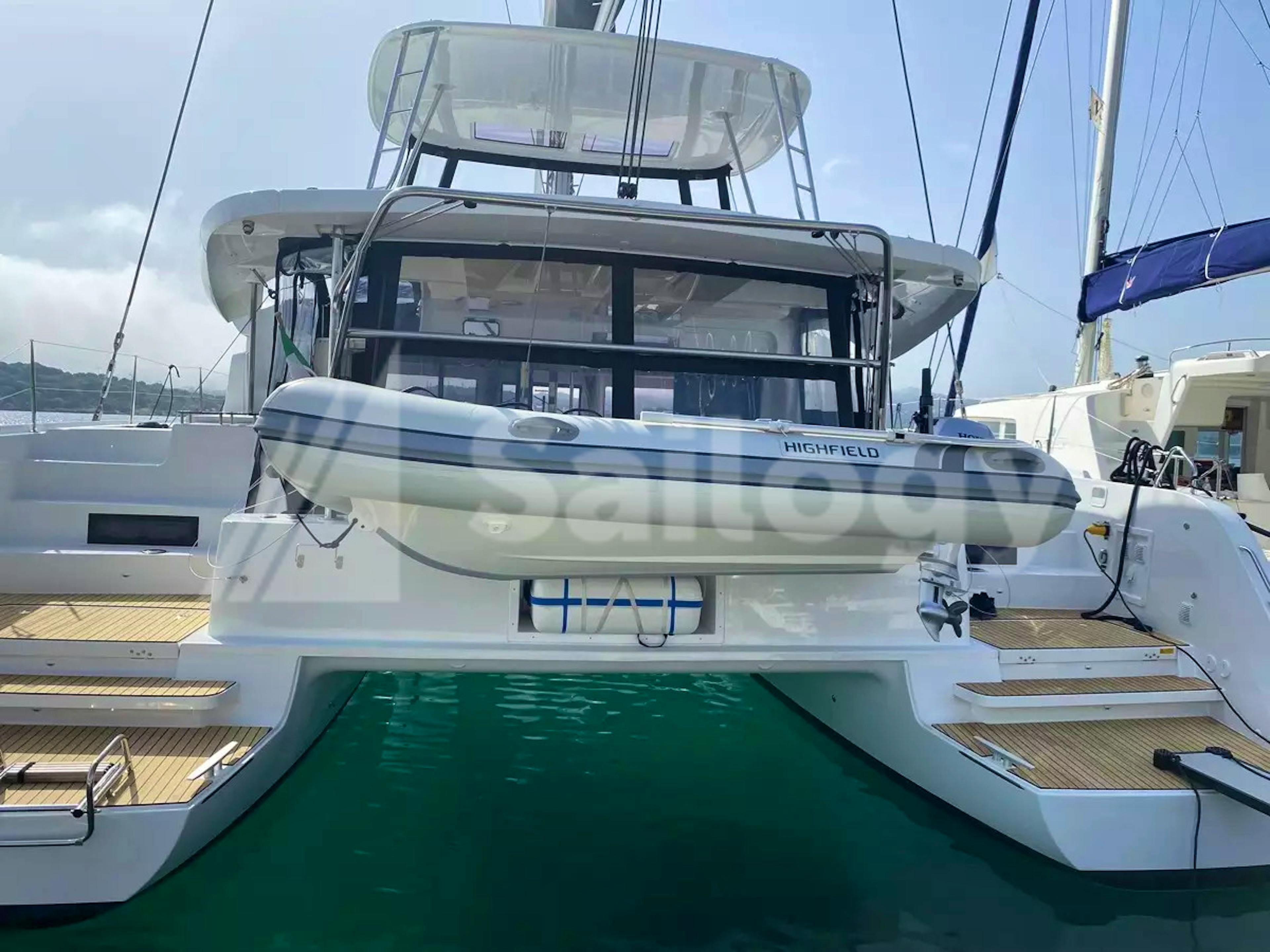
Portisco, Costa Smeralda
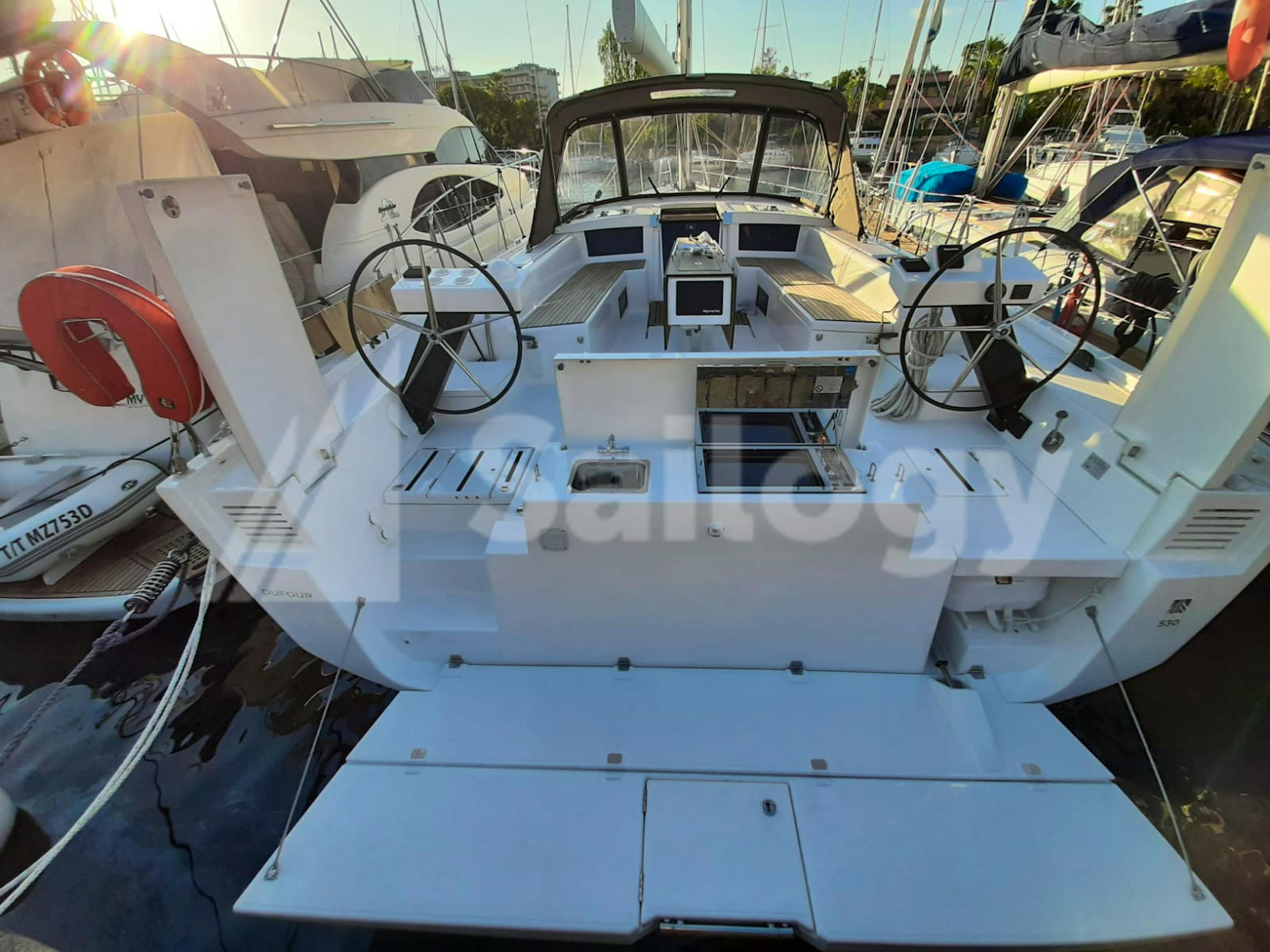
Portorosa, Aeolian Islands
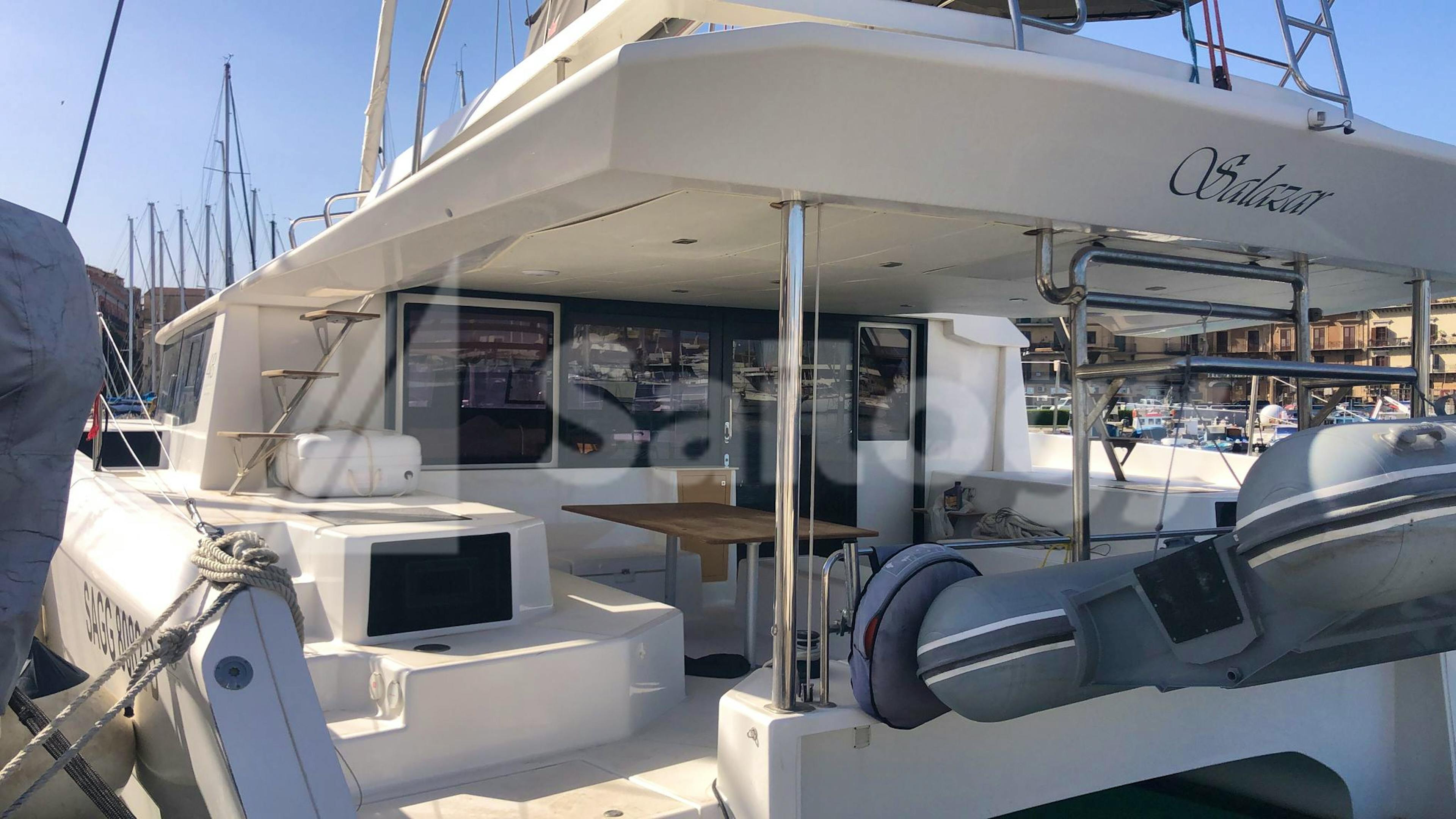
Dufour 430 Grand Large
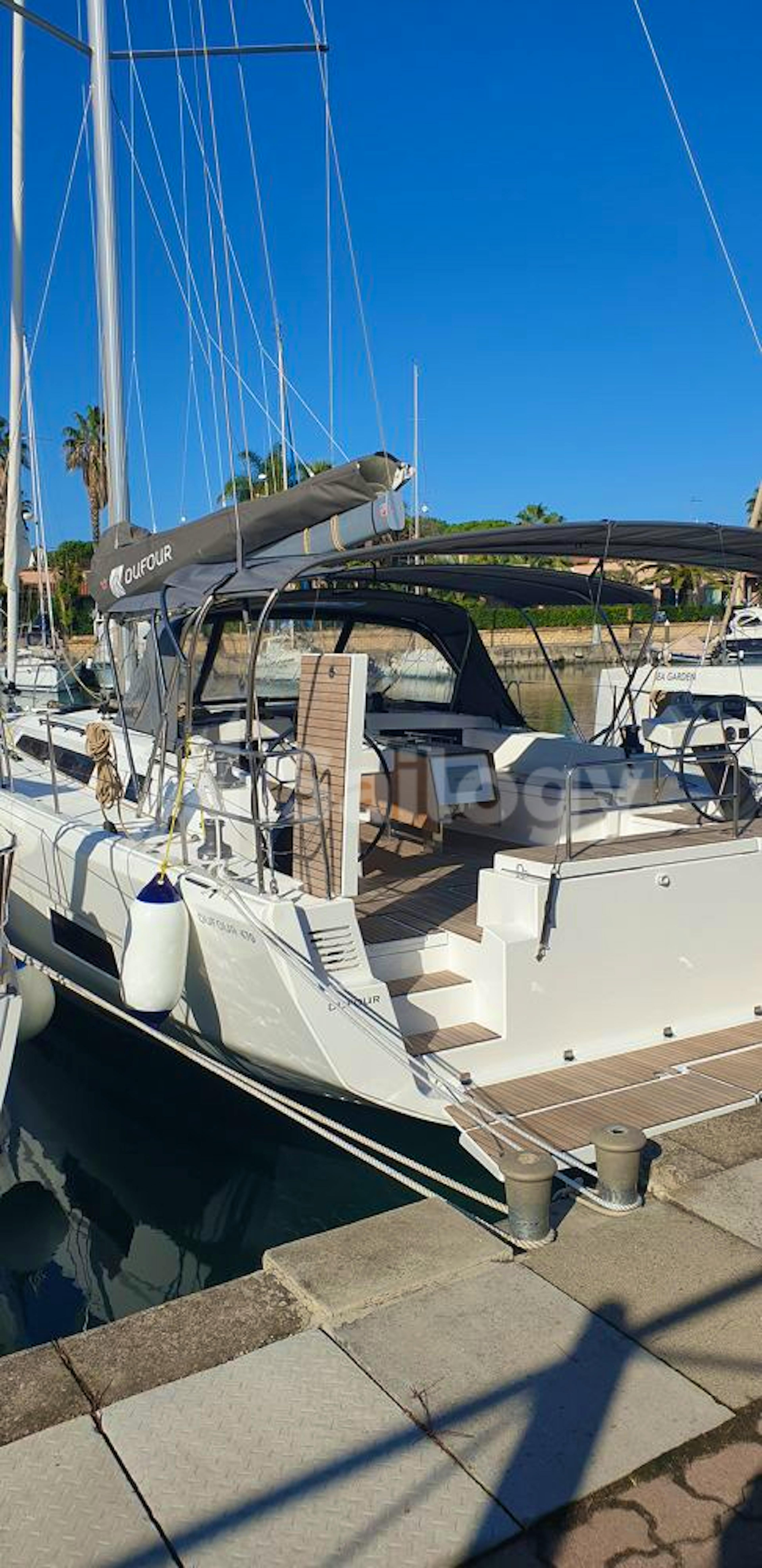
Other articles

7-day Sailing Itinerary in the Dodecanese Islands

What To Bring On a Boat

Kornati Islands Sailing: Best Spots To Visit By Boat
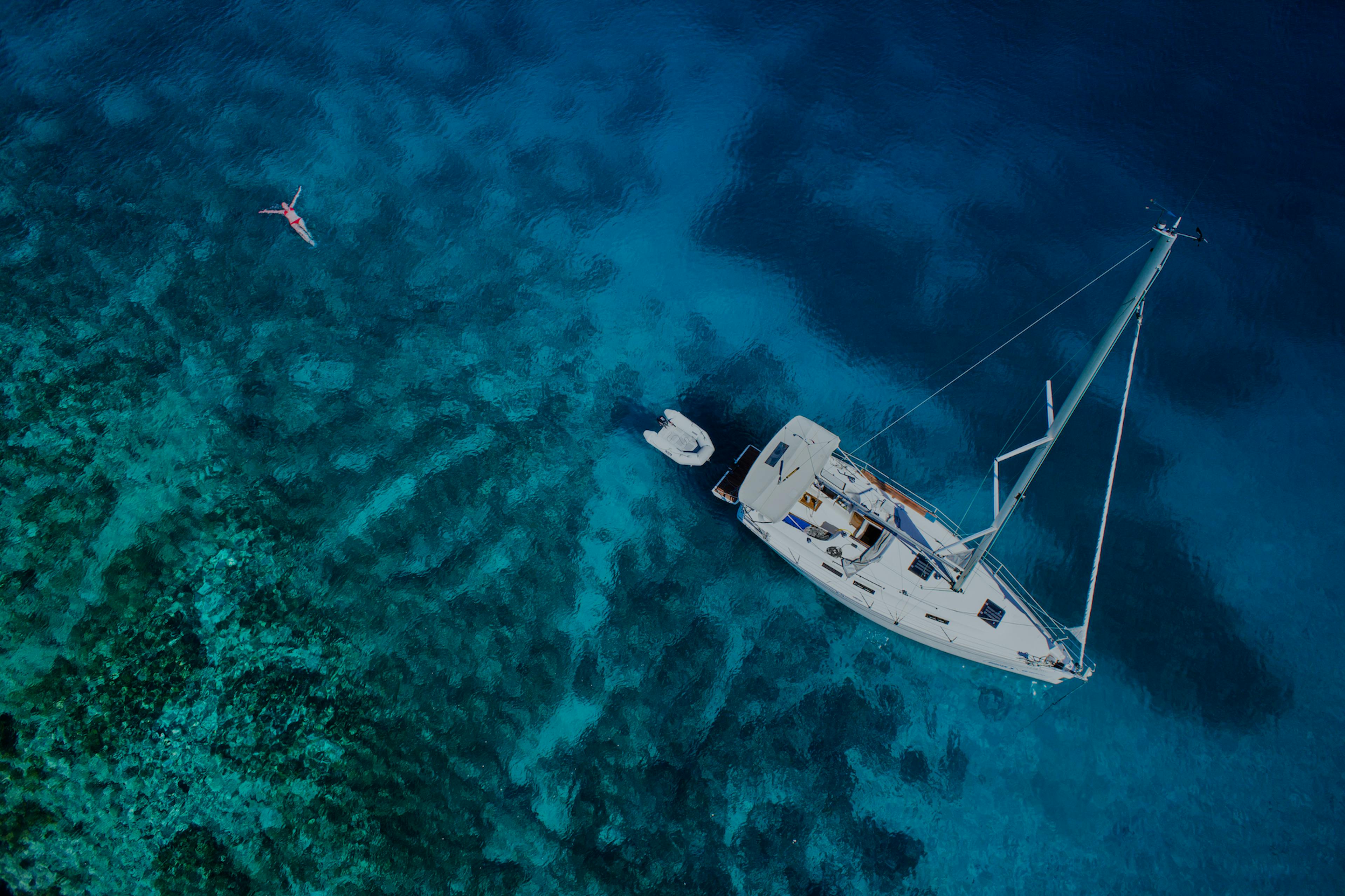
Stay in touch
New sailing magazine out now.
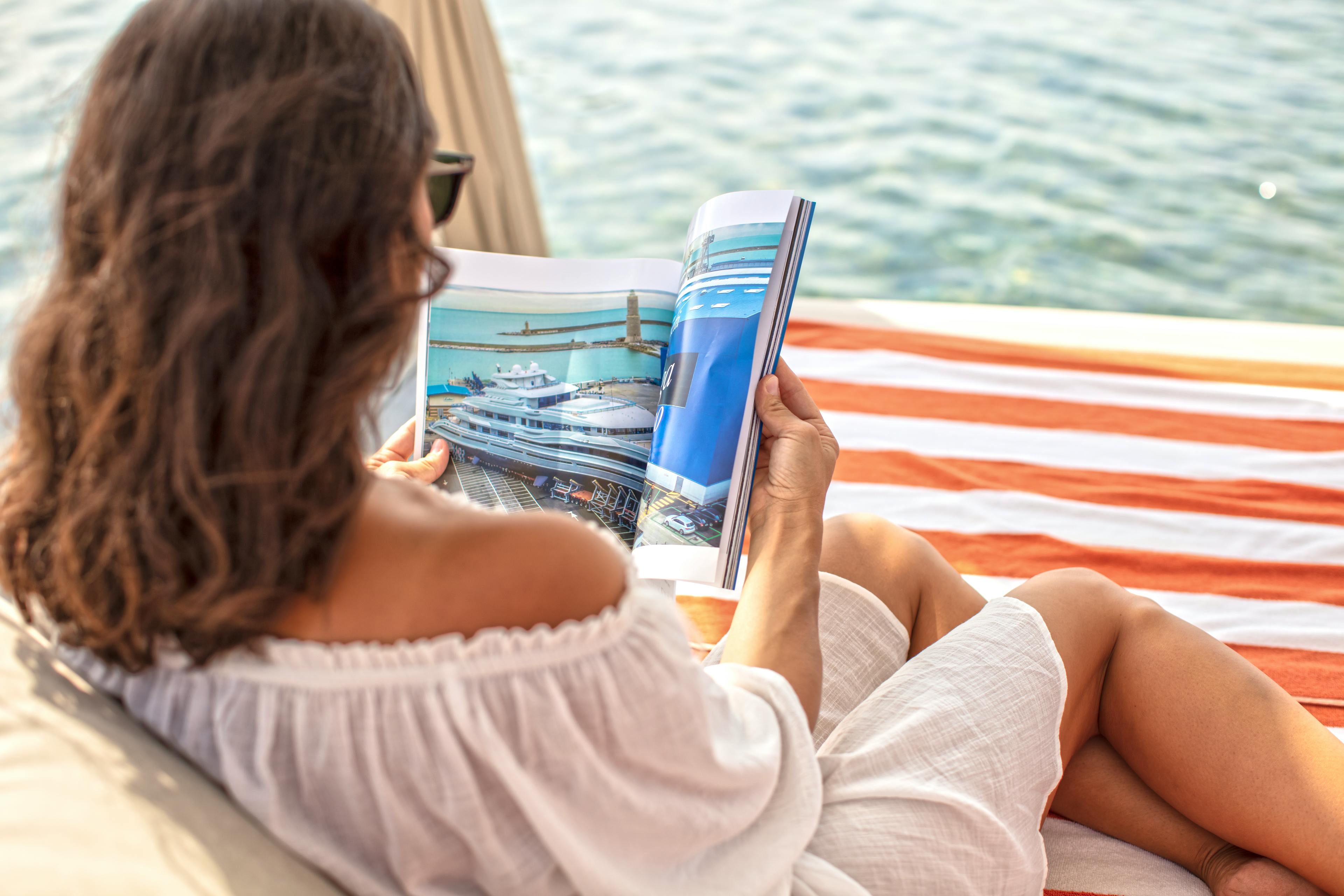

IMAGES
VIDEO
COMMENTS
Here are the different parts that belong to the standing rigging: Forestay or Headstay - Line or cable that supports the mast and is attached to the bow of the boat. This is often a steel cable. Backstay - Line or cable that supports the mast and is attached to the stern of the boat. This is often a steel cable.
A sail, which is a large piece of fabric that is attached to a long pole called the mast, uses the wind to pull a sailboat across the water. It has various parts, such as the head, tack, clew, luff, leech, foot, mainsail, jib, and batten. These components determine the shape and efficiency of the sail.
A basic sailboat is composed of at least 12 parts: the hull, the keel, the rudder, the mast, the mainsail, the boom, the kicking strap (boom vang), the topping lift, the jib, the spinnaker, the genoa, the backstay, and the forestay. Read all the way through for the definition of each sailboat part and to know how they work.
To understand mast maintenance better, it's essential to know the various components of a sailboat mast. The key parts include the masthead, spreaders, shrouds, and halyard sheaves. Masthead. The masthead is the topmost section of the mast, where the halyards are attached to raise and lower the sails. It also often houses instruments such as ...
Yawl: Two masts, with the shorter mast aft of the rudder post; Schooner: Two or more masts, with the shorter mast forward; Catboat: Single mast stepped far forward with one sail . All parts of a sailboat work together to allow the sailboat to harness wind power, maintain stability, and navigate through water efficiently. Parts common to all boats
In part 4 of Sailboat Parts Explained, we're taking a quick look at the different names for sail sides, corners and mast parts as well.Make your sailing drea...
Yacht Masts: Designed for grandeur, these masts are equipped to handle multiple heavy sails, sophisticated rigging systems, and the weight and balance demands of a large vessel. Sailboat Masts: Engineered for agility, they prioritize speed, wind optimization, and quick adjustments. Maintenance, Repairs, and the Importance of Both.
The main parts of a sailboat. Hull - The main structure. Keel - The fin under the boat. Rudder - To steer the boat. Mast and Rigging - Supporting the sails. Boom - Supporting the mainsail. Sails - The canvas used to harness the energy of the wind. The starboard and port side of the boat. Windward and Leeward.
Short answer sailboat parts names: Sailboat parts have various names that serve different functions. Some common sailboat parts include the mast, boom, rudder, keel, shroud, mainsail, jib sail, and winches. Each part plays a crucial role in maneuvering and controlling the sailboat during sailing. Understanding Sailboat Parts Names: A Comprehensive GuideUnderstanding Sailboat Parts Names: A
The simple parts of a sailboat include: Hull: The main body of the boat that provides buoyancy and houses the internal components.; Mast: A vertical spar that supports the sails and may have additional features like spreaders and halyards.; Sails: Fabric sheets that catch wind to propel the boat, including the mainsail and headsails like jibs.; Rigging: Ropes, wires, and chains that control ...
But parts like halyards, sheets, and blocks are unique to sailboats. Sailboats require four main parts to operate: a hull, mast, sail, and rudder. The hull is the body of the boat, and all other parts are directly or indirectly connected to it. The mast is a long pole that serves as a guide and mounting point for the sail.
Sailboat hulls are displacement hulls, which means they sit low in the water and move relatively slowly. The hull's job is to displace water, so you stay afloat! Bow. The forward "pointy end" of the boat. Stern. The rear end of the boat. Transom. If the stern of a boat has a flat section, it is called the transom.
Some parts of a sailboat are very small and cheap, but are far from insignificant. ... generally made up in 1x19 stainless-steel wire, supports the mast. ... are secured to the structural elements of the hull via chainplates. Standing Rigging. The running rigging is the collective name for the lines (halyards, sheets, topping lifts, uphauls ...
== Short answer sail parts names == Sail parts names include the mainsail, jib, spinnaker, mast, boom, halyard, sheet, and clew. These components play crucial roles in controlling and manipulating a sail's shape and position to optimize performance and maneuverability. 1) Understanding Sail Parts Names: A Comprehensive GuideUnderstanding Sail Parts Names: A Comprehensive Guide Sailing
A sailboat mast is the towering pole mounted to the deck. It attaches the length of the sail to the boat and supports the shape of the sail. Sailboat masts are the most distinct feature of sailing vessels, and they hold the sails in place. Masts are often taller than the length of the boat. Most modern sailboat masts are made of aluminum ...
Close-Hauled. Sailing as close to the wind as possible, with the sail set at a sharp angle to the boat. Beam Reach. Sailing perpendicular to the wind, with the sail set at a right angle to the boat. Broad Reach. Sailing with the wind at a diagonal angle behind the boat, with the sail angled away from the boat. Running.
Dwyer Mast & Rigging offers a wide range of parts and hardware commonly used on sailboat masts and booms including bails, chainplates and stemheads, cleats, clevis pins, connecting hardware and fasteners, eye straps and mast eyes, gooseneck assemblies, halyard organizer plates, mast steps and bases, hinges, spreaders, and more. (260)
Sailboats have various types of sails, including the mainsail, headsail (jib/genoa), and specialty sails like spinnakers. The mainsail is the primary sail attached to the main mast, while the headsail is located at the front of the boat. Spinnakers are large, lightweight sails used for sailing downwind.
A sailboat mast is a tall pole that is attached to the deck. It helps secure the sail's length to the boat and upholds the sail's structure. A sailboat mast is the most defining characteristic of a sailboat, helping keep the sail in place. What's amazing about it is that it can even be taller than the vessel's length!
A tall vertical spar that supports the sails. Rudder. Used to steer the boat through the water. Stern. The back of the boat. Topping Lift. A line used to hold the boom up while the sail is lowered. Most commonly attached to the aft of the boom to the top of the mast. It is loosened or removed once the sail is raised.
If you're a beginner sailor, you want a quick and solid overview of the different sailboat parts. In this video, I go over the four main segments of the sail...
A sailboat, as the name implies, is characterised by the presence of sails. Sails are kept in position by the mast, which is made of aluminium. The mast is supported by strong steel cables: the one by the bow is called the forestay (to which the sail is wrapped around to form a soft sausage).
Three-masted training ship Mersey Main topgallant mast. The mast of a sailing vessel is a tall spar, or arrangement of spars, erected more or less vertically on the centre-line of a ship or boat.Its purposes include carrying sails, spars, and derricks, giving necessary height to a navigation light, look-out position, signal yard, control position, radio aerial or signal lamp. [1]